
- Jurisdiction & Venue
- Class action allegations
- ScottishPower
- PacifiCorp
- PPM Energy Inc.
- Commercial wind power
- Greenlight Energy.
- Sale of Elk River Windfarms LLC
- Empire District Electric Company
- Flint Hills Ecoregion
- Tallgrass Prairie National Preserve
- International recognition
- Birds of the Tallgrass Prairie
- Tourism
- Wind turbines = environmental damage
- Wind turbines: an economic catastrophe
- Catastrophic wind turbine failures
- The prayer for relief
- In the Tenth Circuit Court of Appeals
- Jurisdiction & Venue
- Class action allegations
- ScottishPower
- PacifiCorp
- PPM Energy Inc.
- Commercial wind power
- Greenlight Energy.
- Sale of Elk River Windfarms LLC
- Empire District Electric Company
- Flint Hills Ecoregion
- Tallgrass Prairie National Preserve
- International recognition
- Birds of the Tallgrass Prairie
- Tourism
- Wind turbines = environmental damage
- Wind turbines: an economic catastrophe
- Catastrophic wind turbine failures
- The prayer for relief
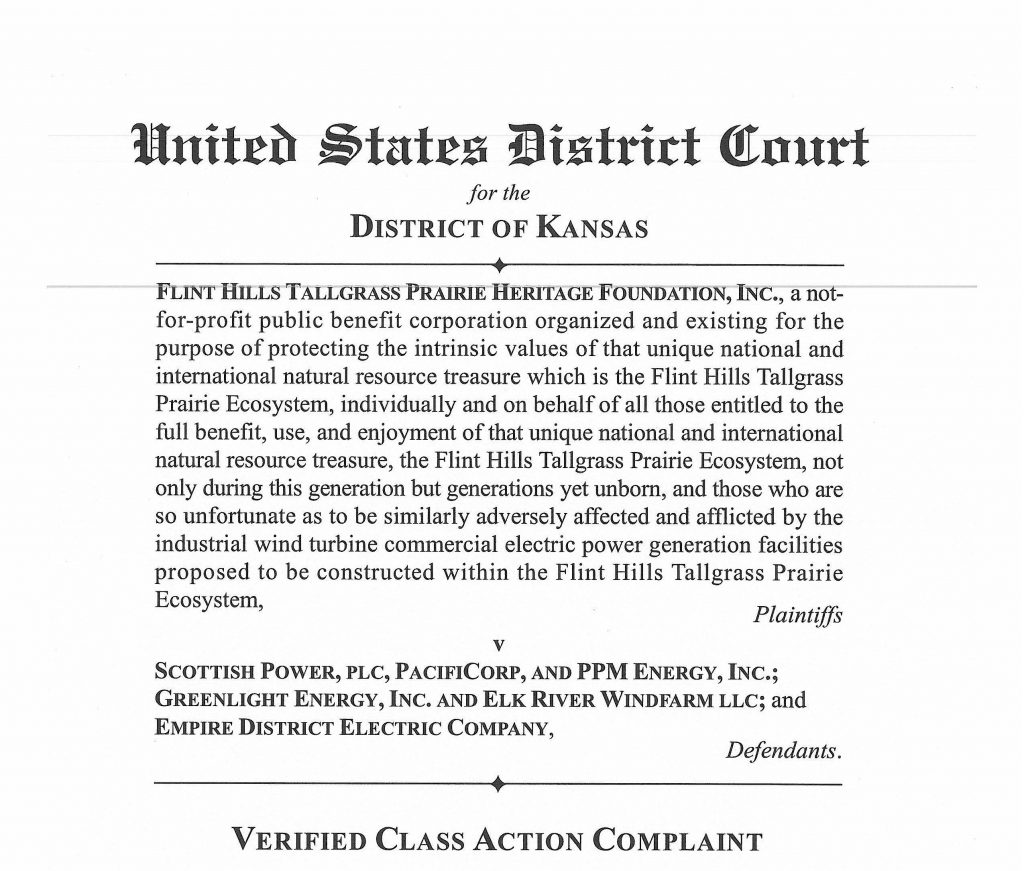
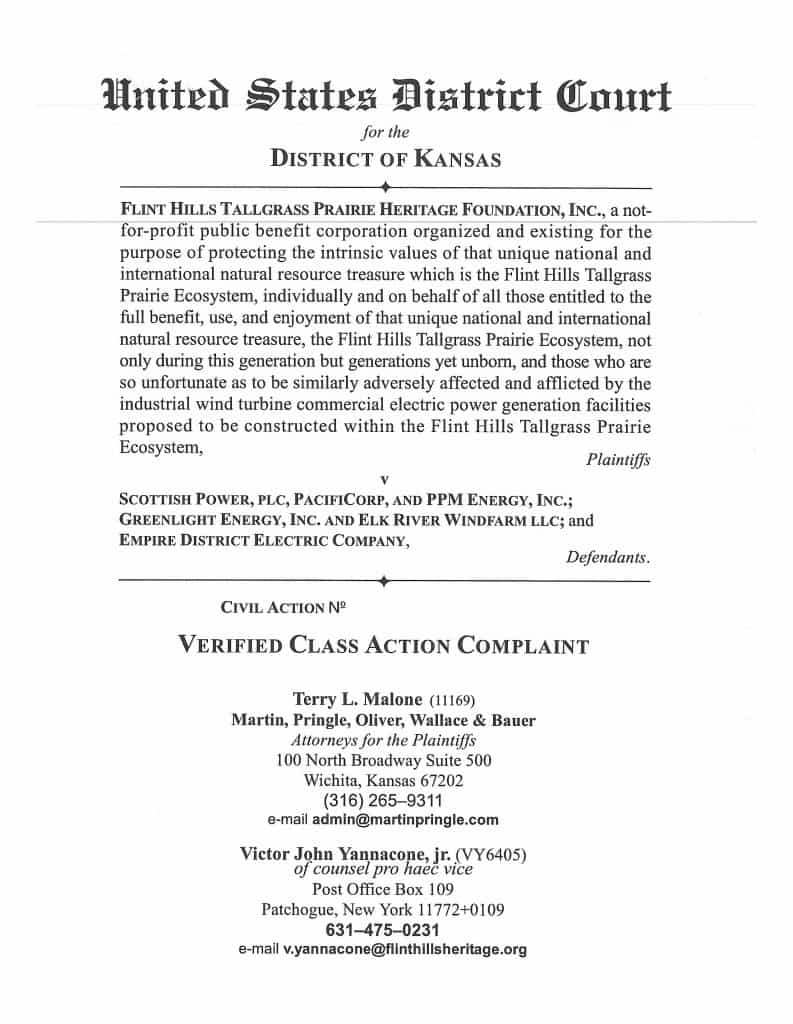
Jurisdiction
1. Jurisdiction of this Court is invoked under Title 28, United States Code, §1331(a).
1.1 This action arises under Article VI, section 2 of the Constitution of the United States. “This Constitution, and the Laws of the United States which shall be made in Pursuance thereof; and all Treaties made, or which shall be made, under the Authority of the United States, shall be the supreme Law of the Land; and the Judges in every state shall be bound thereby; any Thing in the Constitution or Laws of any State to the Contrary notwithstanding.”
1.2 This action involves the declaration and interpretation of the Plaintiffs′ rights guaranteed by the Ninth Amendment of the Constitution of the United States, “The enumeration in the Constitution of certain rights, shall not be construed to deny or disparage others retained by the people.”
1.3 These rights are protected under the due process clause of the Fifth Amendment of the Constitution of the United States. “… nor shall any person . . . be deprived of life, liberty, or property, without due process of law ….”
1.4 This action seeks a judgment declaring that tax relief and direct subsidies for industrial wind turbine commercial electric power generation facilities that will cause serious, permanent and irreparable damage to the unique national and international resource treasure, the Flint Hills Tallgrass Prairie Ecosystem, violates the provisions of the Constitution of the United States.
1.5 This action requires the declaration of the rights of the Plaintiffs under the Treaty with Great Britain for the Protection of Migratory Birds concluded August 16, 1916, and the Treaty with the United Mexican States for the Protection of Migratory Birds and Game Mammals, concluded February 7, 1936. The matter in controversy, exclusive of interest and costs, exceeds the value of several million dollars.
2. The federal statutes relevant to this proceeding are, among others, The Migratory Bird Act, Title 16, United States Code, §§ 701 et seq. which is based on a treaty of December 8, 1916, between the United States and Great Britain. The two nations agreed in the Treaty to take the proper steps for carrying out the expressed purpose and object of the treaty which is to save such birds from indiscriminate slaughter and to insure their preservation on account of their great value as a source of food and in destroying insects which are injurious to forests and forage plants on the public domain, as well as to agricultural crops in both the United States and Canada, by providing adequate protection during the nesting season or while on their way to and from their breeding grounds. (Shouse v Moore, 11 FSupp 784, 785)
Equitable Jurisdiction
3. This action is properly brought in equity before this court because the subject matter of the dispute is equitable in nature. This action is brought for the purpose of restraining the Corporate Defendants individually, and their successors in interest, from damaging or degrading the unique national and international resource treasure that is the Flint Hills Tallgrass Prairie Ecosystem.
3.1 The injury which may be inflicted by the Corporate Defendants individually or their successors in interest, if they are permitted to develop the area with industrial wind turbine commercial electric power generation facilities without regard for the unique national and international resource treasures of the Flint Hills Tallgrass Prairie Ecosystem will be serious, permanent and irreparable, in that those damages cannot be adequately and justly compensated within the lifetimes of many generations. The declaratory judgment demanded by the Plaintiffs, together with the equitable relief related thereto, are equitable remedies in the substance and character of the rights sought to be enforced, historically, in the province of the Court of Chancery.
4. There is no adequate remedy at law.
4.1 The law does not afford any remedy for the contemplated wrong to the American people of this generation and generations yet unborn which will result from the serious, permanent and irreparable damage and degradation of the unique national and international resource treasures that is the Flint Hills Tallgrass Prairie Ecosystem from the development and operation of industrial wind turbine commercial electric power generation facilities by the Corporate Defendants and/or their successors in interest.
4.2 There is no plain, adequate and complete remedy at law as practicable and efficient as the equitable relief sought herein. Nor would the damages sustained by the sovereign people of the United States as a result of the development of industrial wind turbine commercial electric power generation facilities proposed by the Corporate Defendants or their Successors in Interest, be capable of measurement and determination in any action at law.
5. That the Corporate Defendants individually, and their successors in interest, to the extent that they have any legal interest in the land and landscape of that unique national and international resource treasures, the Flint Hills Tallgrass Prairie Ecosystem, hold their legal interest in trust for the full benefit, use and enjoyment of all the sovereign people of this generation and those generations yet unborn, and may not cause serious, permanent and irreparable damage to the intrinsic values of the Flint Hills Regional Environmental System.
5.1 That the maintenance of this public trust is compatible with the proper efficient development of the resource represented by the area of the Flint Hills Tallgrass Prairie Ecosystem and that the maintenance of the public trust is consistent with private ownership of the property and does not constitute any taking of property.
5.2 That the administrative agencies of the Federal, State, and County governments are presently taking no action to prevent the serious, permanent and irreparable damage which will result from the improper development of industrial wind turbine commercial electric power generation facilities in the Flint Hills Tallgrass Prairie Ecosystem by the Corporate Defendants or their successors in interest without regard for unique national and international resource treasure which the Flint Hills Tallgrass Prairie Ecosystem represents.
Venue
6. Venue is proper in this judicial district pursuant to 15 USC §22 and 28 USC §1391(b) because Corporate Defendants transact business, are found and/or have agents in this district and because the equitable relief sought involves a unique national and international resource treasure, the Flint Hills Tallgrass Prairie Ecosystem which is located largely in the State of Kansas.
Class Action Allegations
7. The Representative Plaintiff organization brings this action on behalf of all those entitled to the full benefit, use, and enjoyment of that unique national and international resource treasure, the Flint Hills Regional Environmental System, and so unfortunate as to be similarly adversely affected and afflicted by the industrial wind turbine commercial electric power generation facilities proposed to be sited in the Flint Hills Tallgrass Prairie Ecosystem.
8. The Representative Plaintiff organization seeks class certification pursuant to Rule 23(b)(2) of the Federal Rules of Civil Procedure as to the declaratory and equitable relief sought herein.
Numerosity
8.1 Members of the Class are numerous and joinder is impracticable because, upon information and belief, tens of thousands of citizens of the State of Kansas and the United States of America each year are entitled to the full benefit, use and enjoyment of that unique national and international resource treasure, the Flint Hills Regional Environmental System, and so unfortunate as to be similarly adversely affected and afflicted by the industrial wind turbine commercial electric power generation facilities proposed to be sited in the Flint Hills Tallgrass Prairie Ecosystem.
Common questions of law and fact
8.2 Questions of law and fact common to the members of the Class predominate over questions, if any, that may affect only individual members, thereby making appropriate equitable, injunctive and declaratory relief with respect to the Class as a whole.
8.3 Certain specific conduct of the Corporate Defendants including, but not limited to misleading elected representatives and appointed officials and members of administrative agencies by misrepresenting the deleterious and damaging effects of industrial wind turbine commercial electric power generation facilities proposed to be sited in the Flint Hills Tallgrass Prairie Ecosystem is a question of law and fact common to the entire Class.
8.4 Whether certain subsidies and tax benefits for industrial wind turbine commercial electric power generation facilities violate the rights of the vast majority of the taxpayers of Kansas and the United States secured for them in perpetuity by the Constitution of the United States are questions of law and fact common to the entire Class.
8.5 Whether the actions by the Corporate Defendants jointly and/or severally, individually and/or collectively, in seeking to site industrial wind turbine commercial electric power generation facilities in the Flint Hills Tallgrass Prairie Ecosystem by taking advantage of unconscionable manipulation of the federal and state system of voluntary taxation is an effort to limit competition from more economically rational systems for electric power generation in Kansas and the surrounding Regional Economic System is a question of law and fact common to the entire Class.
8.6 Whether the Representative Plaintiff organization and members of the Class are entitled to declaratory, equitable and/or injunctive relief is a question of law and fact common to the entire Class.
Typicality
8.7 The claims of the Representative Plaintiff organization are typical of the members of the Class, in that the members of this organization are all affected by and will suffer serious, permanent and irreparable damage from the industrial wind turbine commercial electric power generation facilities proposed to be sited in the Flint Hills Tallgrass Prairie Ecosystem.
Adequate representation
8.8 The Representative Plaintiff organization can and will fairly and adequately protect and represent the interests of all those entitled to the full benefit, use, and enjoyment of that unique national and international resource treasure, the Flint Hills Regional Ecosystem, and so unfortunate as to be similarly adversely affected and afflicted by the industrial wind turbine commercial electric power generation facilities proposed to be sited in the Flint Hills Tallgrass Prairie Ecosystem.
9. The interests of the Representative Plaintiff organization are not in any way antagonistic to or in conflict with the interests of the entire class or any member of the Class as defined herein.
10. The Representative Plaintiff organization is represented by counsel who is experienced and competent in the prosecution of complex class action litigation.
The Representative Plaintiff, Flint Hills Tallgrass Prairie Heritage Foundation, Inc.
11. The Representative Plaintiff organization, Flint Hills Tallgrass Prairie Heritage Foundation, Inc., is a not-for-profit public benefit corporation organized under and by virtue of the laws of the State of Kansas for the purpose of protecting the intrinsic values of that unique national and international resource treasure, the Flint Hills Tallgrass Prairie Regional Ecosystem;
11.1 to build awareness of the fact that more than 95 percent of the original acreage of Tallgrass Prairie on the North American continent has been lost, and only 4 percent remains in any form, with nearly two thirds of that remaining in the Flint Hills Ecoregion of Kansas and Oklahoma;
11.2 to promote by means of education and other initiatives the stewardship, conservation and protection of native Tallgrass Prairie grasslands, intact prairie landscapes, and associated natural resources in the Flint Hills Tallgrass Prairie Ecosystem of Kansas and Oklahoma;
11.3 to promote public awareness and understanding of the importance of preserving intact prairie landscapes that function to maintain native flora and fauna in ecological communities, biodiversity and the Tallgrass Prairie ecosystem;
11.4 to promote public awareness and understanding of the importance of prairie landscapes and habitat for declining grassland birds, including Greater Prairie-chickens and other resident species, migratory neotropical and neoarctic species that depend on the area for summer nesting and brood rearing, migratory or wintering habitat;
11.5 to promote understanding and appreciation of the historical contribution of ranching as an instrument of conservation and management of native prairie rangelands and hay meadows;
11.6 to promote understanding and appreciation of contemporary ranching as a strategy for preserving existing prairie resources on a landscape scale, as a foundation for building a culture of conservation and wise use, an environmental ethic, and continuing a rural way of life;
11.7 to promote understanding and appreciation of the legacy of Native Americans within the Flint Hills, their culture and their association with the land, wildlife and other resources; to promote public support for governmental, organizational and private individual initiatives designed to facilitate conservation, stewardship and preservation of natural, cultural, historical, scenic, recreational and agricultural values of the Flint Hills Tallgrass Prairie Ecosystem;
11.8 to promote appreciation and enjoyment of the natural and pastoral elements of the Flint Hills Regional Environmental System and support nature based and agritourism and other initiatives designed to complement the economies of local communities, landowners and operators in a manner that is ecologically sophisticated, environmentally responsible, socially relevant, and economically rational;
11.9 to work with other organizations including the Tallgrass Legacy Alliance, Tallgrass Ranchers, Protect the Flint Hills, Audubon of Kansas, The Nature Conservancy, Kansas Wildlife Federation, Kansas Livestock Association, North America Grouse Association, Quail Unlimited, and/or others,
11.10 and public agencies including the U.S. Fish and Wildlife Service, National Park Service, Natural Resources Conservation Service, Kansas Department of Wildlife and Parks, Kansas Biological Survey, Kansas Conservation Commission and/or others
11.11 to develop comprehensive strategies for protection and preservation of unique natural and cultural resources which are integral elements of the Flint Hills Tallgrass Prairie Ecosystem;
11.12 to work with ranchers, farmers and other landowners, business leaders, and local community leaders and other residents to assist and support individuals who are striving to preserve the natural, cultural, historical, scenic, recreational, agricultural and other resource values associated with their land and the rural communities of the Flint Hills Regional Environmental System;
11.13 to take whatever action is appropriate to oppose unwarranted actions that have the effect of undermining conservation, stewardship and preservation goals for the Flint Hills Tallgrass Prairie Ecosystem that are and have been supported by those striving to maintain, in the public interest, the unique national and international resource treasure that is the Flint Hills Regional Environmental System;
11.14 to promote ecologically sophisticated, environmentally responsible, socially relevant, and economically rational siting standards for industrial wind turbine commercial electric power generation facilities which will not impose upon the unique national and international resource treasure that is the Flint Hills Tallgrass Prairie Ecosystem or cause serious, permanent and irreparable damage to that Ecosystem and the Regional Environmental System of which it is a part and upon which it depends for continued existence and sustainability.
Individual Incorporators and Members
11.15 The individual incorporators and members of the Representative Plaintiff, organization, Flint Hills Tallgrass Prairie Heritage Foundation, Inc., are persons who collectively have stewardship responsibilities for, and own and/or manage tens of thousands of acres of native tallgrass prairie rangelands, pastures, hay meadows and lands devoted to conservation of native flora and fauna, livestock husbandry and agricultural production, recreation and other activities consistent with maintaining the Flint Hills Tallgrass Prairie Regional Ecosystem as the unique national and international natural resource treasure it still is and may yet remain.
11.16 The economic livelihood, way-of-life and quality of life of the individual incorporators and members of the Representative Plaintiff, organization, Flint Hills Tallgrass Prairie Heritage Foundation, Inc., depend upon maintaining the Flint Hills Tallgrass Prairie Regional Ecosystem as the unique national and international natural resource treasure it still is and may yet remain.
11.17 Certain of the individual incorporators and members of the Representative Plaintiff, organization, Flint Hills Tallgrass Prairie Heritage Foundation, Inc., own and operate business enterprises including those related to tourism in the region and depend, to varying extents upon or derive economic benefit to various extents from continuing existence of the Flint Hills Tallgrass Prairie Regional Ecosystem as the unique national and international natural resource treasure it still is and should yet remain.
11.18 Among the members of the Representative Plaintiff organization, Flint Hills Tallgrass Prairie Heritage Foundation, Inc., are individuals such as Steven Trent who owns property in the area and earns his livelihood training raptors and is now subject to serious, permanent and irreparable damage as a result of the industrial wind turbine commercial electric power generation facilities proposed to be constructed in the Flint Hills Tallgrass Prairie Ecosystem.
Defendant ScottishPower plc
13. ScottishPower plc is an international energy company operating across the United Kingdom and in the United States, based in Glasgow, Scotland and is listed on the New York Stock Exchange under the symbol SPI and on the London Stock Exchange under the symbol SPW.
13.1 In both the United States and the United Kingdom, ScottishPower plc provides electricity generation, transmission, distribution and supply services.
13.2 In the United States, ScottishPower plc activities extend to coal mining and gas storage/hub services and, in the United Kingdom, the supply of gas to its customers.
13.3 ScottishPower plc generates electricity, operates and maintains large power delivery networks and provides retail services including metering, billing and call centre support.
13.4 ScottishPower plc claims to employ 15,000 employees to serve almost six million retail and wholesale customers, providing energy through 200,000 km of transmission and distribution networks from over 100 power plants.
13.5 The origins of ScottishPower plc lie in the state-owned United Kingdom utility sector. After privatisation in 1991, the business developed both through organic growth and through acquisitions in the electricity, gas, water and telecommunications industries, most notably the merger with PacifiCorp in the United States in November, 1999.
13.6 According to ScottishPower plc, since 2001/02, its long-term objective has been clear and consistent: to become a leading international energy company.
13.7 According to promotional materials distributed by ScottishPower plc, the company aims to increase its renewable energy capacity, mainly through windfarm development, to 1,000 MW in the United Kingdom by 2010 and to secure at least 2,000 MW of new renewable capacity in the United States over the same period.
13.8 ScottishPower has a corporate centre in Scotland and is organised into four divisions: PacifiCorp and PPM Energy in the United States and Infrastructure Division and UK Division in the United Kingdom.
13.9 Both PacifiCorp and Infrastructure Division are regulated, while PPM and UK Division operate in competitive energy markets.
13.10 According to ScottishPower plc, its regulated divisions provide a base for steady growth, while its competitive divisions seek market share growth and the enhancement of profit margins through the integration of generation, energy management and customer services.
13.11 ScottishPower plc has a number of joint ventures in the United Kingdom and United States principally connected with electricity generation.
13.12 ScottishPower′s Infrastructure Division is a regulated asset-owner, holding the Group′s United Kingdom transmission and distribution licences. The Division is divided into three main wholly owned subsidiaries: SP Transmission Ltd owns 4,000 km of transmission network in south and central Scotland (132 kV and above); SP Distribution Ltd owns the 66,000 km distribution network (from 33 kV downwards) in south and central Scotland; SP Manweb plc owns the 46,000 km distribution system in Merseyside, Cheshire and North Wales.
13.13 According to ScottishPower plc, these asset-owner companies also operate SP Transmission & Distribution (SPT&D) as an integrated business to concentrate expertise on regulatory issues. In addition to these three subsidiaries, a fourth subsidiary, SP Power Systems Ltd. is responsible for managing and maintaining the network on behalf of the asset owners.
13.14 ScottishPower′s competitive business in the United Kingdom, the UK Division, consists of five wholly owned subsidiaries: ScottishPower Generation Ltd, ScottishPower Energy Management Ltd and ScottishPower Energy Management (Agency) Ltd, ScottishPower Energy Retail Ltd and SP Dataserve Ltd.
13.15 ScottishPower Generation Ltd owns and operates its United Kingdom power stations and generation assets of some 5,400 MW of generating capacity comprised of coal, gas, hydroelectric and wind power.
13.16 ScottishPower Energy Management Ltd and ScottishPower Energy Management (Agency) Ltd deal in gas and electricity at the wholesale level and in the commercial instruments and agreements which constitute the market balancing mechanisms for the competitive energy market in the United Kingdom.
13.17 ScottishPower Energy Retail Ltd holds the Group′s electricity and gas supply licences and is the link to 4.25 million retail customers, both business and domestic managing sales and marketing, billing and processing of payments and handles customer enquiries at three call centers.
13.18 SP Dataserve Ltd manages ScottishPower′s data and metering, which underpin customer registration, billing and settlement.
13.19 At present, just under two thirds of UK Division′s generating capacity comes from coal-fired power stations, but ScottishPower plc is the largest United Kingdom wind developer.
ScottishPower plc Executive Management Team
14. Upon information and belief, the ScottishPower plc Board of Directors is comprised of five Executive Directors and eight Non-executive Directors from a variety of business backgrounds and disciplines in the United Kingdom and the United States. The five Executive Directors are Ian Russell, Chief Executive; David Nish, Finance Director; Charles Berry, Executive Director UK; Judi Johansen, President and Chief Executive Officer of PacifiCorp; Simon Lowth, Director, Corporate Strategy and Development.
14.1 Ian Russell is Chief Executive, having been appointed to this position in April 2001. He joined ScottishPower as Finance Director in April 1994 and became Deputy Chief Executive in November 1998. He is a member of the Institute of Chartered Accountants of Scotland, having trained with Thomson McLintock and has held senior finance positions with HSBC. He serves on the Council of Edinburgh International Festival and the Scottish Council of the Prince′s Trust and is leading a UK Government Commission investigating the development of a National Youth Volunteering Strategy
14.2 David Nish is Finance Director, having joined ScottishPower in September 1997 as Deputy Finance Director and then being appointed to the Board as Finance Director in December 1999. In this capacity, he also has responsibility at Board level for performance and risk management. He is a member of the Institute of Chartered Accountants of Scotland, the Scottish Council of the CBI, the UK Government′s Employer Task Force on Pensions and the Accounting Standards Board′s Urgent Issues Task Force and is a non-executive director of The Royal Scottish National Orchestra. Prior to joining ScottishPower, he was a partner with Price Waterhouse. He has a BAcc from the University of Glasgow. Charles Berry is Executive Director UK, responsible in this capacity for the UK energy businesses of Generation, Energy Management and Supply. He joined ScottishPower in November 1991 and was appointed to the Board in April 1999. He is a member of the Board of the Energy Saving Trust. Prior to joining ScottishPower, he was Group Development Director of Norwest Holst, a subsidiary of <em>Compagnie Generale des Eaux</em> and prior to that held management positions within subsidiaries of Pilkington plc. He holds a BSc (First Class Honors) in Electrical Engineering from the University of Glasgow an ?? Masters degree in Management-from the Massachusetts Institute of Technology.
14.3 Judi Johansen is President and Chief Executive Officer of PacifiCorp; she was appointed to this position in June 2001 and joined the Board on 1st October 2003. She joined PacifiCorp as Executive Vice President of Regulation and External Affairs in December 2000, having held senior positions with the Bonneville Power Administration and Washington Water Power. She is a member of the Boards of the Portland Branch of the US Federal Reserve Bank of San Francisco, the Port of Portland, The Haven Project for Disadvantaged Youth, the Oregon Business Council and Northwestern School of Law at Lewis & Clark College. She has a bachelors degree in political science from Colorado State University and a law degree from Northwestern School of Law at Lewis & Clark College in Portland, Oregon and is a member of the Oregon and Washington State Bar Associations.
14.4 Simon Lowth is Director, Corporate Strategy and Development, having been appointed to the Board in this position on 1 September 2003. He is responsible in this role for leading the formulation, presentation and delivery of corporate strategy. He was formerly a Director with McKinsey & Company, leading its UK Industrial Practice serving clients in the energy and utilities, manufacturing and transport sectors. He holds an MA in Engineering from Cambridge University and an MBA from London Business School.
15. The eight non-executive Directors of ScottishPower plc are Chairman Charles Miller Smith, Vicky Bailey, Euan Baird, Donald Brydon, Philip Carroll, Nolan Karras, Nick Rose and Nancy Wilgenbusch
15.1 Charles Miller Smith joined the Board as Deputy Chairman in August 1999 and was appointed Chairman in April 2000. Following a career with Unilever for some 30 years, during the last five of which he was Director of Finance and latterly of the Food Executive, he was appointed Chief Executive of ICI in 1995 and then served as Chairman from 1999 to 2001. He is an international adviser to Goldman Sachs, a member of the Board of the Indian company, ICICI One Source plc and a member of the Ministry of Defence Management Board . He is also a governor of the Menley Management College. During the year, he served on the committee chaired by Professor Laura Tyson of London Business School which considered, in the light of the recommendations of the Higgs Review, ways of broadening the pool of non-executive directors.
15.2 Vicky Bailey, who is based in Washington DC, is a former Assistant Secretary for Policy and International Affairs at the US Department of Energy and ex-member of the Federal Energy Regulatory Commission (FERC). She has also served as an Indiana state regulator. Evan Baird joined the Board in January 2001. He served as Chairman and Chief Executive Officer of Schlumberger Limited from 1986 to 2003. He is now non-executive Chairman of Rolls¬ Royce plc and a non-executive director of <em>Societe Generale</em>, Areva and the New York Stock Exchange. He is a trustee of Tocqueville Alexis Trust and Carnegie Institution of Washington and a member of the Advisory Committee of Banque de France. His current term of office, subject to his re-election in 2004, will expire at the AGM in 2007.
15.3 Donald Brydon Joined the Board on 30 May 2003. Following a 20- year career with Barclays Group plc, he joined AXA Group in 1997 and is now Chairman of AXA Investment Managers.
15.4 Philip Carroll first joined the Board in January 2002. He resigned his position on 15 May 2003 following his appointment, in connection with the reconstruction of post-war Iraq, as Chairman of the Advisory Board with oversight of the Iraqi Oil Ministry. Following completion of this assignment, he was re-appointed to the Board on 20 October 2003. He was formerly Chairman and Chief Executive Officer of Fluor Corporation, a California-based international engineering, construction and services company, until his retirement in February 2002. Previously, he was with Shell Oil for over 35 years, serving as President and Chief Executive Officer from 1993 to 1998. He is an honorary life member of the Board of the American Petroleum Institute and holds various posts with the James A Baker III Institute for Public Policy of Rice University and the University of Houston. His current term of office, subject to his election in 2004, will expire at the AGM in 2005.
15.5 Nolan Karras joined the Board in November 1999. He continues as a non-executive director of PacifiCorp, where, until the merger in November 1999, he served as Chairman of the PacifiCorp Personnel Committee. He is President of The Karras Company, Inc. and a Registered Principal for Raymond James Financial Services. He is Chief Executive Officer of Western Hay Company, Inc. and a non-executive director of Beneficial Life Insurance Company. He is Chairman of the Utah State Higher Education Board of Regents and a member of the board of Ogden-Weber Applied Technology College. He also served as a member of the Utah House of Representatives from 1981 to 1990 and as Speaker of the Utah House of Representatives from 1989 to 1990. His current term of office will expire at the AGM in 2006.
15.6 Nick Rose joined the Board in February 2003; he is the Chairman of the Audit Committee and is the Committee′s “financial expert”. He is Finance Director of Diageo plc, having been appointed to this position in July 1999. Previously, he held senior finance positions with GrandMet and was latterly Finance Director of International Distillers & Vintners in 1996 and then of United Distillers & Vintners in 1997. He is also a director of Moet Hennessy. His current term of office, subject to his election in 2003, will expire at the AGM in 2006.
15.7 Nancy Wilgenbusch is a distinguished community administrator and President of Marylhurst University in Portland, Oregon. She also serves on the Regional Advisory Board of PacifiCorp.
16. The remaining members of the ScottishPower plc Executive Management Group are Dominic Fry, Group Director, Corporate Communications; Terry Hudgens, Chief Executive Officer of PPM Energy, Inc.; Ronnie Mercer, Group Director, Infrastructure; Andrew Mitchell, Group Company Secretary; Michael Pittman, Group Director, Human Resources; and James Stanley, Group Director, Commercial and Legal.
16.1 Dominic Fry joined ScottishPower in September 2000 as Group Director, Corporate Communications. He is responsible for investor and media relations, communications with employees, corporate social responsibility and management of the group′s overall reputation. He has held appointments as Communications Director with J Sainsbury plc and Eurotunnel plc. He chairs the Trading Board of the Glasgow Science Centre and is a communications adviser to the Royal Shakespeare Company and Business in the Community. He is also a director of Scottish Business in the Community. He was educated at the <em>Universite Paul Valery III</em> in Montpellier and the University of North Carolina.
16.2 Terry Hudgens was appointed Chief Executive Officer of ScottishPower′s competitive US energy business, PPM, in May 2001 and joined the Executive Team in December 2001. He joined PacifiCorp as Senior Vice President of Power Supply in April 2000, having previously spent 25 years with Texaco, Inc. He was formerly President of Texaco Natural Gas and served as Texaco′s senior representative and elected officer in the Natural Gas Supply Association. He is a member of the Board of Trustees of The Nature Conservancy in Oregon. He has a bachelor′s degree in civil engineering from the University of Houston.
16.3 Ronnie Mercer was appointed Group Director, Infrastructure in April 2001 and is responsible in this role for the UK Wires Businesses. He joined the ScottishPower Generation Business in 1994 and was appointed Generation Director in 1996 and then Managing Director of Southern Water in 1998. Previous career positions include Scottish Director and Managing Director roles in British Steel. He was educated at Paisley College of Technology.
16.4 Andrew Mitchell was appointed Group Company Secretary in July 1993 and is responsible in this role for Board and shareholder services, corporate governance and compliance and group security. He also serves as Chairman of the trustees of the group′s UK pension schemes and as the company′s e7 representative. Prior to joining ScottishPower, he held a number of company secretarial appointments, latterly as Company Secretary of The Laird Group plc and then Stakis plc, now part of the Hilton Group. He is a graduate in law from the University of Edinburgh (LLB Hons) and the London School of Economics (:LLM) and is a member of the Institute of Chartered Secretaries and Administrators.
16.5 Michael Pittman was appointed Group Director, Human Resources in November 2001. He has groupwide responsibility for human resources, leading the focus on talent management, one of the group′s main strategic thrusts. He joined PacifiCorp in December 1979 and was appointed to the PacifiCorp Board in May 2000. He chairs the PacifiCorp Foundation for Learning Board and is involved in numerous civic activities, including chairing the Board of Directors for the Oregon Public Employees Retirement System. He has held several positions within PacifiCorp, including safety and health, risk management and operations. He holds an advanced degree in environmental health from the University of Washington.
16.6 James Stanley was appointed Group Director, Commercial and Legal in March 1996. He is responsible in this role for legal compliance and reporting together with the provision of all legal, commercial and associated services throughout the group and particularly the negotiation, structuring and delivery of M&A and similar projects. In his early career he specialised in commercial litigation in private practice. In 1986 he moved to the Trafalgar House Group and subsequently became both Commercial Director of John Brown plc and General Counsel to the Global Engineering Division of the Group. He is a graduate in law from Nottingham University and the College of Law in Chester where he qualified as a solicitor in 1980.
Defendant PacifiCorp
17. PacifiCorp is a regulated electricity company operating in six western United States states with an exclusive monopoly certificated service territory in all states except Washington, which is regulated by local energy commissions which determine its prices and many other aspects of its business. 17.1 PacifiCorp officially merged with ScottishPower in November 1999 and is listed in the electricity sector on the London Stock Exchange and the electric utilities sector on the New York Stock Exchange.
17.2 PacifiCorp generates electricity, operates the power delivery network and undertakes wholesale trading in the western United States. It also manages the ScottishPower plc coal-mining interests.
17.3 PacifiCorp′s retail electricity supply operations are conducted by Pacific Power, based in Portland, Oregon, and Utah Power, based in Salt Lake City.
17.4 PacifiCorp generates and provides energy for 1.6 million retail customers, covering an area of more than 136,000 square miles.
17.5 PacifiCorp owns 8,420 MW of generation capacity.
17.6 PacifiCorp owns fuel sources, including coalmines, and uses these sources along with natural gas, wind, geothermal and hydroelectric resources to generate electricity at its 71 power plants. The electricity generated from these plants, as well as electricity bought wholesale, is then transmitted over a grid of transmission lines before being transformed to lower voltages and delivered to customers through the company′s distribution system.
17.7 PacifiCorp meets around 78% of customer demand from its own low-cost generation, the remainder being obtained under long-term purchase contracts and other arrangements.
17.8 The retail business of PacifiCorp operates under the names of Pacific Power in Oregon, Wyoming, Washington and California; and Utah Power in Utah and Idaho.
17.9 According to ScottishPower plc, PacifiCorp has 220 million tons of coal reserves in three mines, owns 16,000 miles of overhead transmission lines, 44,000 miles of overhead distribution lines and 14,000 miles of underground distribution lines.
17.10 According to ScottishPower plc, PacifiCorp employs 6,507 employees to service its 1.6 million customers and in its last year report claimed 69,875 GWh in electricity sales from 71 generating facilities, including 54 hydroelectric plants, 16 thermal electric plants and one jointly owned windfarm, earning a £619 .3 million operating profit.
18. The history of PacifiCorp begins in 1910 when a utility holding company, Electric Bond and Share, bought several small West Coast utilities and formed Pacific Power & Light (PP&L), then expanded its service area through acquisitions and by building transmission lines.
18.1 The Public Utility Holding Company Act of 1935 forced Electric Bond and Share to unload PP&L in 1950. Uncertainty over government power contracts spurred PP&L to build its own hydroelectric dams.
18.2 In 1953 PP&L merged with Mountain States Power which had two small phone companies, expanding into Idaho, Montana and Wyoming.
18.3 In 1961, PP&L merged with California Oregon Power and began operating coal-fired plants and acquiring some 1.5 billion tons of Montana and Wyoming coal reserves.
18.4 In the 1970s, PP&L acquired Telephone Utilities in Washington and long-distance company Alascorn in Alaska and formed the Northern Energy Resources Company (NERCO) to manage its coal-mining units.
18.5 In 1982 the firm reorganized, becoming PacifiCorp. PP&L became a subsidiary and the phone services were renamed Pacific Telecom.
18.6 In the mid-1980s PacifiCorp bought a financial service firm and explored for oil and gas through NERCO.
18.7 In 1987 PacifiCorp merged with Utah Power and opened its grid to independent power producers.
18.8 In 1994 PacifiCorp entered wholesale power marketing as Fred Buckman became CEO.
18.9 In 1995 PacifiCorp bought Australian utility company Powercorp, split Pacific Telecom into a separate subsidiary, sold Alascorn to AT&T and split its utility operations into generation, transmission and retail sales units.
18.10 In 1997 PacifiCorp bought natural gas marketer TPC but sold TPC′s gas pipeline to El Paso Natural Gas, now El Paso Energy. That year PacifiCorp agreed to buy the UK Energy Group for about $9.6 billion, including debt and sold Pacific Telecom to Century Telephone, now CenturyTel and Pacific Generation, an independent power producer developer, to NRG Energy.
18.11 In 1998 PacifiCorp′s power trading arm lost $151 million when its suppliers couldn′t meet the energy demands of a sweltering hot summer in the western United States. Buckman resigned, replaced by CEO Keith McKennon and PacifiCorp was forced to reorganize.
18.12 In 1999 PacifiCorp sold TPC to NIPSCO. now called NiSource, for $132.5 million. It also sold its Montana service area to Flathead Electric Cooperative and exited most of its power trading operations.
18.13 In 1999 ScottishPower completed its purchase of PacifiCorp and Alan Richardson replaced McKennon as CEO.
18.14 In 2000 PacifiCorp sold its Centralia, Washington, coal-fired power plant and an adjacent coal mine to Canada′s TransAlta for $554 million and it sold Powercor for $2.14 billion to Cheung Kong Infrastructure.
18.15 For about six months in 2000 and 2001, PacifiCorp experienced an unscheduled outage at one of its Utah power plants which, coupled with unusually high-priced wholesale electricity in the region, caused losses for the company and led it to request rate increases for its service territories in 2001.
18.16 In 2001 PacifiCorp transferred its interest in PacifiCorp Power Marketing, now PPM Energy, its remaining energy trading unit, to another ScottishPower plc unit.
PPM Energy, Inc.

PPM structural relationships
19. PPM Energy, Inc., formerly PacifiCorp Power Marketing, holds the non¬ regulated North American operations of parent company ScottishPower plc and is engaged in wholesale energy marketing and providing services to municipal agencies, public utility districts, investor-owned utilities, producers, marketer I traders and others operating in eight states in the United States and in Canada, with a generating capacity of a little over 1,600MW in the Midwest and Western United States.
19.1 PPM Energy, Inc. balances its supply portfolio with sales to wholesale customers, placing almost all of its output in long-term contracts. Major customers include the federal Bonneville Power Administration, the cities of Seattle, Sacramento, Pasadena, Anaheim, investor-owned utilities such as Alliant Energy and Xcel Energy and cooperatives such as Minnesota′s Great River Energy.
19.2 PPM Energy, Inc. primarily develops and operates cogeneration power plants and wind farms.
19.3 PPM Energy, Inc. also markets and trades wholesale energy and offers risk and asset management services.
19.4 PPM Energy, Inc. was the second-largest provider of United States wind energy in 2003 and accounted for almost a third of new wind development in the United States in 2003.
19.5 According to ScottishPower plc, PPM owns 3 gas turbines, 9 windfarms and 2 gas storage facilities; employs 194 employees and has 18 large power customers, 37 large gas customers and in its last fiscal year generated a £36.7 million operating profit.
19.6 In early 2001 PPM Energy, Inc. extended its operations to include gas storage, operating natural gas storage and hub operations through its ENSTOR affiliate.
The PPM Energy, Inc. Management Team
20. Upon information and belief, PPM Energy, Inc. is operated by a management team made up of Terry Hudgens, president and chief executive officer; Merrick Kerr, chief financial officer; Matt Morrow, senior vice president of gas storage and hub services, who is also president of ENSTOR, a ScottishPower Company; Peter van Alderwerelt, senior vice president of business development and origination; Ralph Currey, who oversees the management of PPM′s energy trading; Allan Query, vice president of construction and operations for PPM Energy and vice president of engineering and operations for Pacific Klamath Energy; Julian Brown, vice president of new business initiatives; Don Winslow, vice president of policy and regulatory affairs; J.J. DiNorscia, vice president of pricing, structuring and market analysis; Patrick Haye, who is responsible for risk management and control, information technology, back office, contract administration and compliance; Vera Johnson, vice president of organizational effectiveness; Jean Wilson, Vice President, Renewable Business Development; and Paul Kaufman, lead counsel.
20.1 Upon information and belief, Terry Hudgens is president and chief executive officer of PPM Energy. Prior to being named CEO, Mr. Hudgens was senior vice president of power supply at PacifiCorp, responsible for the utility′s power generation, wholesale sales and mining businesses. Mr. Hudgens spent 25 years with Texaco, Inc. working in operations and management positions, including vice president of business development for Texaco Trading and Transportation, Inc. Prior to joining PacifiCorp, he was president of Texaco Natural Gas-North America. In that role, he was responsible for all aspects of Texaco′s $5 billion North American natural gas and worldwide natural gas liquids business. He also served as Texaco′s senior representative in the Natural Gas Supply Association . Mr. Hudgens has a bachelor′s degree in civil engineering from the University of Houston.
20.2 Upon information and belief, Merrick Kerr is PPM′s chief financial officer and is responsible for PPM′s accounting and financial reporting functions, as well as for delivering the company′s financial targets for value growth and profitability. Prior to joining PPM, Mr. Kerr served as PacifiCorp′s financial controller for power supply, ensuring tight control during a period of extreme price volatility. Prior to his international assignment, Mr. Kerr had extensive management experience across ScottishPower′s business units and was a key member of the transition team during the ScottishPower–PacifiCorp merger. Before joining ScottishPower, Mr. Kerr worked for Coopers & Lybrand in Glasgow, Scotland. He is a member of the Institute of Chartered Accountants of Scotland. Mr. Kerr received a bachelor′s degree in accountancy and economics from the University of Edinburgh in Scotland and recently completed Stanford′s Executive Program.
20.3 Upon information and belief, Matt Morrow is senior vice president of gas storage and hub services and also president of ENSTOR, a ScottishPower company. He has thirteen years of experience in the gas storage and hub services industry and was instrumental in the development of hub services within the gas industry at the Henry Hub. Previous positions include COO, TradeCapture.com; director of e-commerce, Texaco Natural Gas; and president, Sabine Hub services, where he was responsible for all aspects of Texaco’s storage and hub services business in North American natural gas. A native Texan, Mr. Morrow has a bachelor′s degree in civil engineering and an MBA from Texas A&M.
20.4 Upon information and belief, Peter van Alderwerelt is senior vice president of business development and origination at PPM Energy. He is responsible for the development and acquisition of wind and gas-fired power projects and the marketing of power, gas and renewable products. Over the last three years his team of developers and originators has been responsible for adding 830 MW of wind generation and 800 MW of high-efficiency gas-fired generation to PPM′s portfolio and for arranging the sale of output from these facilities under long-term bilateral contracts to load-serving entities. Mr. van Alderwerelt′s group of 25 professionals is focused on new wind power opportunities and providing an expanded range of wholesale products and services across the West and into the Midwest, Gulf Coast and Northeast as PPM′s business expands. Prior to joining PPM, Mr. van Alderwerelt was director of project development for PacifiCorp′s Pacific Generation Company, where he was responsible for developing and financing the 500 MW Klamath Cogeneration Plant. His 23 years of experience in the energy industry includes developing regional and international cogeneration and power project opportunities on behalf of ABB, Combustion Engineering and private developers and management consulting at Navigant and CH2M Hill on business strategy and development initiatives. Mr. van Alderwerelt has a bachelor′s degree in mechanical engineering from the University of California at Davis and recently completed ScottishPower′s year-long Business Leadership Program.
20.5 Upon information and belief, Ralph Currey oversees the management of PPM′s energy trading throughout the WECC region, negotiating sales and purchases in the day-ahead, short-term and forward physical and financial markets. Mr. Currey′s organization consists of 45 power and gas trading professionals. Prior to joining PPM, Mr. Currey was vice president of trading (North America Texaco natural gas. There he was responsible for managing the fixed price, futures, physical and options trading books for the company. His 22 years of energy experience include positions at Chevron Natural Gas and KCS Energy Marketing. He has been involved in gas thermal projects at PPM, with the Klamath Falls Cogeneration project and also various generation plants in San Jacinto, California, for Chevron and Texaco. Mr. Currey earned bachelor and master degrees from West Virginia University as well as a masters in economics from the Colorado School of Mines.
20.6 Upon information and belief, Allan Query is vice president of construction and operations for PPM Energy, and vice president of engineering and operations for Pacific Klamath Energy, the subsidiary that operates the Klamath Cogeneration Plant. Mr. Query is responsible for the operation of the Klamath Cogeneration Plant, as well as the engineering and project management activities surrounding the development and construction of future ventures. Mr. Query′s team consists of approximately 30 engineering and project management professionals in Klamath Falls and Portland, Oregon. Prior to joining PPM, Mr. Query was director of project engineering for PacifiCorp′s Pacific Generation Company. He has been responsible for project management during the engineering, construction and start-up phases of several recent notable projects, including the 240 MW Crockett Cogeneration combined-cycle facility and the 500 MW Klamath Cogeneration Project. Mr. Query has over 30 years of related experience which includes 18 years with General Electric Company. Mr. Query received his BS in mechanical engineering from Seattle University and a professional engineering (mechanical) certification in Washington.
20.7 Upon information and belief, Julian Brown is vice president of new business initiatives of PPM Energy, having most recently served as group director, strategy, for ScottishPower. He is responsible for developing related new areas of business to expand and supplement PPM′s current activities in thermal generation, renewable generation and gas storage. Prior to joining ScottishPower in 1993, Mr. Brown was with Exxon Chemical in Australia and subsequently spent seven years with management consultants McKinsey & Company. He holds a BSc from the Australian National University and a PhD in chemistry from University College London.
20.8 Upon information and belief, Don Winslow is vice president of policy and regulatory affairs for PPM Energy. Mr. Winslow has also previously served at PPM as vice president, economic analysis and structuring for PPM Energy. Prior to joining PPM, Mr. Winslow worked in various technical and engineering functions throughout the energy industry. This experience included 15 years at Unocal, an international oil and gas producing company where he worked both as a petroleum engineer and a financial analyst. He subsequently moved into risk management roles at Cinergy and Pinnacle West. Mr. Winslow has a degree in physics from Georgia Tech and an MBA from Southern Methodist University.
20.9 Upon information and belief, J.J. DiNorscia is vice president of pricing, structuring and market analysis. He is responsible for overseeing the economic analysis of PPM′s prospective development projects and origination transactions. Examples of these commercial activities include the construction of wind farms and gas storage fields as well as the structuring of gas and power marketing deals. Mr. DiNorscia manage s a group of 16 professionals. Mr. DiNorscia came to PPM Energy from RWE Trading Americas Inc. in Houston, where he served as vice president of risk control. He has spent more than 30 years in the energy industry. This experience included 12 years at ARCO where he both implemented trading strategies and managed marketing portfolios across different energy commodities. He also has held executive mid-office positions at both Texaco Natural Gas Inc. and TPC Corporation. Mr. DiNorscia holds a Bachelor of Science degree in Chemical Engineering from the University of Delaware and a Masters of Business Administration in Finance from Winthrop University.
20.10 Upon information and belief, Patrick Haye is responsible for risk management and control information technology, back office contract administration and compliance. With over 18 years of experience in the energy business, he manages a team of 26 professionals. Prior to joining PPM Energy, Mr. Haye was senior director of financial operations at Dynergy, where he was responsible for managing various mid- and back office functions for their energy asset and trading company. He also spent 12 years with Chevron, holding various positions of increasing management responsibilities within finance, risk and information system organizations. Mr. Haye graduated from Oregon State University with a bachelor′s degree in accounting and computer science. He is also a member of the Institute of Management Accountants and is a Certified Management Accountant.
20.11 Upon information and belief, Vera Johnson is vice president of organizational effectiveness with responsibility for management of human resources, internal communications, facilities and oversight of administrative support staff. Prior to joining PPM, Ms. Johnson worked in various positions of increasing human resources responsibilities at Texaco Natural Gas, Exxon Company USA and BellSouth Cellular, where her focus was compensation analysis. She has over 20 years experience in human resources management and has obtained the designations of Certified Compensation Professional and Certified Professional in Human Resources. Ms. Johnson earned a bachelors degree in English from Alabama A&M University and an MBA from Nova Southeastern University in Ft. Lauderdale, Florida.
20.12 Upon information and belief, Jean Wilson, Vice President, Renewable Business Development, is responsible for PPM′ s wind power supply business, including greenfield development, project acquisition and long term power purchase agreements. She has over 11 years experience in wind power development and marketing, including four years in wind development with Kenetech Windpower. Prior to joining PPM, she co-managed PacifiCorp′s green power marketing business. Her pre-wind energy career includes four years in corporate banking with Bank of America and four years in commercial real estate development with Tishman Real1y Corporation. Jean holds a B.S. in Finance from the University of Southern California and an MBA from Stanford University.
20.13 Upon information and belief, Paul Kaufman is PPM Energy′s lead counsel. Prior to joining PPM, Mr. Kaufman was an attorney with the law firm of Tonkon Torp LLP in Portland, Oregon, where he focused on renewable resource transactions. Prior to his tenure with Tonkon Torp, Mr. Kaufman was a Vice President with Enron Corp., with responsibility over legislative and regulatory matters in the Western United States and a partner with the Portland office of Ater Wynne LLP. During his tenure at Ater Wynne, Mr. Kaufman′s practice involved the development of electric generation resources, power sale contracting, electric energy and natural gas regulation and policy development for the qualifying facility industry in California, Nevada, Oregon and Washington. Mr. Kaufman holds a B.S. in Natural Resources from Cornell University and a J.D. from Lewis and Clark Law School.
ScottishPower plc and commercial wind power development
21. According to its public statements, ScottishPower plc plans to add 1,400 megawatts of renewable generation into the power system in the next 10 years as part of its Integrated Resource Plan.
22. According to its public statements, ScottishPower plc has supported the Federal Renewable Portfolio Standard and proclaims that, “As a company, we were the most vigorous utility supporter of the federal renewable portfolio standard and went on record against measures that would weaken the profitability of wind development.”
Greenlight Energy, Inc.
23. Upon information and belief, Greenlight Energy was founded in 2000 and is based in Charlottesville, VA.
24. Upon information and belief, Greenlight Energy has a nationwide portfolio of projects in 15 states in various stages of development. The portfolio consists of more than a dozen projects, including Elk River Wind Farm and Pembina Wind Farm that have been publicly announced.
25. Greenlight Energy claims to invest in new projects at the earliest stage and advances them through each phase of the development cycle until the industrial wind turbine complex is constructed and operational.
26. Greenlight claims to have assembled a team of highly qualified energy professionals to lead project development: S.A. Reisky de Dubnic, President; Matthew W. Hantzmon, Managing Director; David A. Stoner, Director of Development; Nelson S. Teague, Jr., Project Transactions Director; J. Jonathan F. Baker, Business Development Director; and Kevin M. Davis, Site Development Director.
26.1 Upon information and belief, S.A. Reisky de Dubnic is President of Greenlight Energy and prior to founding Greenlight, Mr. Reisky served as CFO of Boxerjam, Inc., a software company. Previously, he was responsible for financial transactions and capital investment analysis for Klockner Capital Corporation, the U.S. holding company of Klockner Werke AG. He earned a Bachelor of Science degree from the Mcintire School of Commerce at the University of Virginia.
26.2 Upon information and belief, Matthew W. Hantzmon is Managing Director of Greenlight Energy, which he joined in 2001. Previously, he had founded and served as COO and CFO of Multi-Media Medical Systems, which was later acquired by Varian Medical Systems, Inc. He also held a number of financial positions with IBM and worked as a management consultant for Price Waterhouse. He earned his undergraduate degree from the University of Virginia and has a Master of Business Administration from Northwestern University.
26.3 Upon information and belief, David A. Stoner is Director of Development for Greenlight Energy, and he has been both the lead developer and equity owner in numerous conventional energy projects which were initiated, developed, financed and constructed under his oversight. He was formerly Vice President and Managing Director of European Operations for Enetergy Corporation, Vice President of Newport Generation Ventures, Inc. and Vice President of Westmoreland Energy, Inc. He also worked with Pennsylvania Power and Light as Environmental Scientist. He earned a Bachelor of Science degree in Environmental Management from Pennsylvania State University and a Masters in Civil Engineering from Lehigh University.
26.4 Upon information and belief, Nelson S. Teague, Jr. is Project Transactions Director of Greenlight Energy. His background is corporate law and structured finance transactions. Mr. Teague is engaged in developmental transactions such as equipment procurement and project finance. Prior to joining Greenlight, Mr. Teague practiced law for Williams, Mullen, where he specialized in corporate law. He also served as corporate counsel for Circuit City Stores, Inc. He earned his undergraduate degree from Washington and Lee University and his law degree from the TC Williams School of Law at the University of Richmond.
26.5 Upon information and belief, J. Jonathan F. Baker is Business Development Director of Greenlight Energy, and prior to joining Greenlight he served as Managing Director of the Corporate Executive Board (NASDAQ: EXBD), a management information company. During his twelve years with the company, he held a range of senior management positions both in the Washington, D.C. and London offices and launched projects in the U.S., Latin America, Western Europe, Australia and Asia. He earned a Bachelor of Arts degree in English and a Bachelor of Science degree in Economics from the University of Virginia.
26.6 Upon information and belief, Kevin M. Davis is Site Development Director for Greenlight Energy and is supposed to oversee the company′s project initiation and site development process. He has been an architect and real estate developer and a professor at the University of Houston School of Architecture. Mr. Davis completed his undergraduate architecture degree at the University of Virginia and earned a master′s degree from Southern California Institute of Architecture (SCI-Arc).
Sale of Elk River Windfarms LLC
27. Upon information and belief, on or about December 14, 2004, Greenlight Energy, Inc., announced the sale of the Elk River Windfarm project in Butler County, Kansas, to PPM Energy, Inc. PPM Energy, Inc., ScottishPower′s competitive U.S. energy business, agreed to purchase Greenlight Energy′s subsidiary, Elk River Windfarm, LLC and will own and operate the 150-megawatt wind energy facility.
27.1 Greenlight Energy, which began development of the project in 2002, also negotiated a 20-year power purchase agreement with The Empire District Electric Company to purchase the energy generated from the wind farm.
27.2 The Elk River project development team included HMH Energy Resources, Inc., as project co-developer and Babcock & Brown, LP, as project financial advisor.
27.3 PPM Energy said this was its first project in Kansas. The Elk River Project is the third industrial wind turbine commercial electric power generation facility PPM has announced so far that is expected to go into operation in 2005.
27.4 According to the American Wind Energy Association, “with Congress′ decision to extend a federal tax credit for wind energy production, 2005 is expected to be a record year of wind development.”
The Empire District Electric Company
28. Based in Joplin, Missouri, The Empire District Electric Company (NYSE:EDE) is an investor-owned utility providing electric service to approximately 157,000 customers in southwest Missouri, southeast Kansas, northeast Oklahoma and northwest Arkansas.
29. The Empire District Electric Company transmits and distributes electricity to nearly 160,000 customers in southwestern Missouri and adjacent areas of Arkansas, Kansas and Oklahoma.
30. The Empire District Electric Company has interests in fossil-fueled and hydroelectric power plants that give it a generating capacity of 1,100 MW, and it also buys and sells power on the wholesale market.
31. Upon information and belief, The Empire District Electric Company is pursuing non-regulated opportunities, such as leasing capacity on its fiber-optic network, providing Internet access, and offering energy-related services, customer information software services, utility industry technical training and has an investment in close-tolerance, custom manufacturing.
32. The Empire District Electric Company also supplies water to three Missouri towns.
33. The history of The Empire District Electric Company is closely interwoven with the story of the development of this region. While Empire was organized in 1909, tracing its history takes us back to 1890 when the use of electrical power in the mining industry was still untried.
33.1 Individual zinc and lead miners who had staked their claims used mules and hard labor to scratch out a living. The names of the mines: Yellow Dog, Grasshopper, Windy Bill and the Morning Star, were as colorful as the people who worked them. As mining companies sprung up across the tri-state region, electrical motors began to replace the mule and steam power engines in several of the mines.
33.2 Electrical generating companies were born in several locations across the region. These small companies appeared haphazardly to supply the new mining district with the power it demanded.
33.3 On October 16, 1909, papers of incorporation were filed in Topeka, Kansas, bringing the Consolidated Light, Power and Ice Company, the Spring River Power Company, The Galena Light and Power Company and the Joplin Light, Power and Water Company together to form a Company that would be known as The Empire District Electric Company, under its parent company, Cities Services.
33.4 The formation of Empire marked the end of indiscriminate electrical development in the area and was the beginning of a construction program designed to meet the needs of a growing region. The vision of the New York financiers who invested in this area is still alive today. Hoping to develop a financially feasible venture, they referred to this region as “Little Empire” or the “Empire District” to denote their pride in New York, the “Empire State.” To this day, the name “Empire” represents the history of mining development in this area.
33.5 At the time of its organization, Empire had 109 miles of transmission line, 8 megawatts of generating capacity, and 2,400 customers. Today, the Company utilizes over 1,200 miles of transmission line and over 1000 megawatts of capacity to serve over 150,000 customers.
33.6 As industry grew and families moved into the four-state region, the demand for electrical power grew as well. Electrical power for Empire was first produced from generation at the Lowell and Redings Mill hydroelectric plants.
33.7 In the summer of 1909, work began on the Riverton Generating Station. Nine months later, it was completed. One of the generators at the plant was dubbed “Old Kate.” Kate was famous for supplying power to the St. Louis World′s Fair in 1904. Today, the Riverton Plant is still in operation, generating 136 megawatts of electricity. With its five turbines, the Riverton generating station is one of the oldest operational power plants in the United States. Although the plant was flooded in 1993 by the overflow of Spring River, it remains today a vital part of Empire′s generation mix.
33.8 Construction of the Ozark Beach Dam began in 1911 in Taney County, Missouri. Two years later, the dam was completed. It is 1,300 feet long and forms Lake Taneycomo, which stretches for 22 miles. Today, Ozark Beach Hydroelectric Plant supplies Empire with 16 megawatts of power and the Taney County area with a beautiful recreational area. Empire Park, located just above the dam, is a recreational park maintained by Empire District. In 1999 the park was honored with the annual Advisory Council on Disabilities Community Award for the refurbishment and addition of handicap accessible facilities.
33.9 In 1944 The Empire District Electric Company separated from its parent company to become an independent company with its stock listed on the New York Stock Exchange. From 1910 to its independence from Cities Services, Empire had purchased 27 separate power companies to become the dominant provider of electric service in the region.
33.10 From 1959 to 1966, Empire spent approximately $25 million on construction, mostly on new transmission and distribution facilities, to handle the increased demand for electric energy. This construction program included new high-voltage transmission lines and new substations. It also included new transmission lines to tie Empire′s system with neighboring electric companies, making Empire an important part of a vast power grid embracing the Midwest.
33.11 In the early 1960′s, the need for more automation in Empire′s operations brought about the construction of an operations and communications center in Joplin. System Operations was completed in 1964. Equipped with the latest design in electronic technology, this nerve center monitors and controls the production and power flow throughout the entire Empire system.
33.12 On September 10, 1967, just north of the town of Asbury, Missouri, ground was broken for a 200-megawatt, coal-fired power plant. The $26-million Asbury Generating Station was put into operation in June of 1970. Asbury was designed as a “mine-mouth” plant to burn coal from the Empire Mine located just north of the plant. Total plant capacity is 213 megawatts. Unit One is rated at 193 megawatts. Unit Two, completed in 1986, generates 20 megawatts of electricity from the excess boiler capacity of Unit One. In 1990 the plant was converted to use a blend of low-sulfur Wyoming coal and native coal to comply with new clean air standards. In 1997 Asbury set a continuous run record of 170 days. It was a remarkable feat, considering the 27-year age of the plant. Today, Asbury remains one of the lowest cost generating plants in the Midwest.
33.13 In 1978 Empire added the first of two 90-megawatt combustion turbine peaking units at the Empire Energy Center near LaRussell, Missouri, some twenty miles east of Joplin. An opportunity to purchase 12 percent, or 80 megawatts, of the 650 megawatt Iatan Power Plant, near Kansas City, postponed the addition of a second 90 megawatt unit at the Empire Energy Center until 1981. Although these units originally utilized only fuel oil for combustion, they were converted to use natural gas in 1994.
33.14 In 1993 Empire announced the addition of the State Line Power Plant located west of Joplin. A 98-megawatt combustion turbine began providing energy to Empire′s customers in May of 1995. Two years later, a second 150-megawatt turbine was added to the State Line power plant. Plans were announced in 1998 for construction of an additional 350 megawatts of electric power generation at State Line. A new 150-megawatt combustion turbine, combined with the existing 150-megawatt unit, generate enough waste heat to produce an additional 200 megawatts of steam¬ powered, combined-cycle energy. The combined cycle unit began providing energy to Empire customers in June 2001. Westar Generating, Inc., a wholly own subsidiary of Western Resources, Topeka, Kansas, is a partner in the State Line combined cycle. Empire owns 60 percent and is the operator of the plant. Total plant output at State Line is 600 megawatts, making it Empire′s highest megawatt-output power plant. All three combustion turbines at State Line Power Plant use natural gas.
The Empire District Electric Company Management
34. Upon information and belief, The Empire District Electric Company is operated by a management team made up of William L. Gipson, President and Chief Executive Officer; Gregory A. Knapp, Vice President, Finance and Chief Financial Officer; David W. Gibson, Vice President, Regulatory and General Services; Michael E. Palmer, Vice President, Commercial Operations; Bradley P. Beecher, Vice President, Energy Supply; Ronald F. Gatz , Vice President , Strategic Development; Janet Watson, Secretary-Treasurer; and Darryl Coit, Controller, Assistant Secretary and Assistant Treasurer.
34.1 William L. Gipson, President and Chief Executive Officer, joined The Empire District Electric Company in March 1981 in the Information Technology area and was promoted to the Manager of Economic Development in 1987. In October 1995, he was promoted to Director of Commercial Operations and, in February 1997, was named General Manager of Commercial Operations. He was elected vice President of Commercial Operations in April 1997, executive Vice President in February 2001 and Chief Operating Officer in October 2001. He was elected to the Board of Directors in April 2002 and President and Chief Executive Officer effective May 1, 2002. A native of Jasper County, Missouri, Gipson graduated from Missouri Southern State College with a Bachelor of Science degree in Management Technology. Mr. Gipson is currently serving as Chairman of the Missouri Energy Development Association, Vice¬ Chairman of the Joplin Business and Industrial Development Corporation and is a board member of the Joplin Area Chamber of Commerce where he is Chairman-elect. He is also a member of the Missouri Southern State College School of Business Advisory Council, active in the United Way of Southwest Missouri and is a member of the Joplin Rotary Club.
34.2 Gregory A. Knapp, Vice President, Finance and Chief Financial Officer, was elected to his current position effective March 15, 2002. He had been named General Manager of Finance for the Company effective January 21, 2002. During an eighteen-month separation in employment, he held the position of Controller for the Missouri Department of Transportation. Prior to that, Knapp had twenty-two years of service to the Company, beginning as the Director of Auditing in 1978, and in 1983 was named Controller and Assistant Treasurer. Knapp has broad overall responsibility for all aspects of financial planning, as well as the accounting and treasury activities of the Company. Knapp received a Bachelor of Science in Business Administration from Missouri Southern State College. He also holds a Master of Business Administration from Southwest Missouri State University. Throughout his career, Knapp has taken an active role in the community, serving on several committees at the Joplin Area Chamber of Commerce, as a member of the City of Joplin Board of Adjustment and the United Way LinkLine Board. Knapp has served as a member and president of the Joplin RVIII Board of Education and is currently a Director for the Joplin Schools Foundation. Mr. Knapp is a member of the local chapter of the Missouri Society of Certified Public Accountants and is a graduate of Leadership Missouri.
34.3 David W. Gibson, Vice President, Regulatory and General Services, joined The Empire District Electric Company in 1979 as a Senior Auditor. He was promoted to Director of Corporate Planning in 1982, Director of Financial and Regulatory Accounting in 1987, Director of Financial Services and Assistant Secretary in 1991, General Manager of Finance in January of 2001, Vice President, Finance in March 2001, Vice President, Regulatory Services in March 2 002 and Vice President Regulatory and General Services on July 1, 2002. A native of Sioux City, Iowa, Gibson graduated from the University of Nebraska at Lincoln with a Bachelor of Science degree in Accounting. Mr. Gibson served in the United States Army as an Infantry Platoon Leader in Vietnam and later as an Infantry Company Commander.
34.4 Michael E. Palmer, Vice President, Commercial Operations, joined The Empire District Electric Company in June 1986 as a Customer Service Consultant. He was named District Manager for the Aurora area in 1994 and Director of Operations in Branson in March 1997. In February 2001, he was named General Manager, Commercial Operations, and at the April 25, 2001 meeting of the Board of Directors, he was elected Vice President, Commercial Operations. A native of Pierce City, Missouri, Palmer graduated from Pittsburg State University in 1980 with a Bachelor of Science degree in Construction Management. Mr. Palmer is an active participant in the community, having served on the Branson City Council, Branson Lake Area Chamber Board, Skaggs Community Hospital Board of Trustees and Taney Economic Partners Board. Currently, Mr. Palmer serves on the City Council of Carl Junction, the Governor′s Business/Education Committee, Joplin Area Chamber of Commerce Public Policy Committee and is a member of the Rotary Club.
34.5 Bradley P. Beecher, Vice President, Energy Supply, joined The Empire District Electric Company in February 2001 as General Manager of Energy Supply and was elected Vice President, Energy Supply at the April 25, 2001 meeting of the Board of Directors. Before returning to Empire in February 2001 he was the Associate Director of Marketing and Strategic Planning for Black & Veatch′s Energy E&C Division. Beecher originally began work for Empire in May of 1988 as a Staff Engineer at the Riverton Power Plant. In November of 1990, he was named Production Staff Specialist and in 1993 became Director of Production Planning. In November of 1995, Beecher was named to the position of Director of Strategic Planning. A native of northwest Kansas, Mr. Beecher graduated from Kansas State University in 1988 with a Bachelor of Science degree in Chemical Engineering. Mr. Beecher is a registered professional engineer in the State of Kansas.
34.6 Ronald F. Gatz, Vice President, Strategic Development, joined The Empire District Electric Company as General Manager of Non¬ regulated Services in March 2001 and was elected Vice President at the April 25, 2001 meeting of the Board of Directors . In this position, he is responsible for the organization and development of new business opportunities. Mr. Gatz is a native of Newton, Kansas and earned a BS in Agricultural Economics from Kansas State University and a graduate degree in banking from the University of Delaware. Gatz was in the banking industry for 28 years with 12 of those years at Mercantile Bank of Joplin as Executive Vice President, Senior Credit Officer and Chief Financial Officer. Prior to coming to Empire, he was Chief Administrative Officer for Hook Up, Inc. of Joplin. Mr. Gatz is President and member of the Board of Directors for Main Street Joplin, serves on the R-8 School Board and is also a member of the Joplin Rotary Club and St. Mary′s Catholic Church.
34.7 Janet Watson, Secretary-Treasurer, joined The Empire District Electric Company in October 1994 as Accounting Staff Specialist and was elected to her present position in October 1995. Prior to joining The Empire District Electric Company, Watson was Accounting Superintendent with Missouri-American Water Company. She was also formerly employed by Freeman Hospital in Joplin as a Cost Analyst and with Teledyne Neosho as a Senior Administrative Accountant. A native of Southwest Missouri, Ms. Watson graduated Summa Cum Laude from Missouri Southern State College with a Bachelor of Business Administration in Accounting and special emphasis in Computer Science. Ms. Watson is an active member of the American Society of Corporate Secretaries, the National Investor Relations Institute and the Risk and Insurance Management Society, Inc. She is a past regional director and historian of the Heartland Council of the Institute of Management Accountants and past president of the Joplin Tri-State Chapter of the Institute of Management Accountants.
34.8 Darryl Coit, Controller, Assistant Secretary and Assistant Treasurer, began his career at The Empire District Electric Company in 1971. Coit held several positions in the Accounting Department including Financial and Regulatory Analytical Accountant, Supervisor of Property Records and Manager of Property Accounting. In July 2000, he was elected to his present position. A native of Joplin, Missouri, Coit is a graduate of Missouri Southern State College where he earned a Bachelor of Science degree in Marketing and Management.
35. Upon information and belief, the Board of Directors of The Empire District Electric Company include Myron McKinney, Chairman; Nick Chubb, Ross Hartley, Bill Helton, Julio Leon, Bob Lamb, D. Randy Laney, Tom Mueller, Mary Posner, Allan Thoms and Bill Gipson, Directors.
35.1 Upon information and belief, Myron W. McKinney is Chairman of the Board of Directors, Retired President and Chief Executive Officer of The Empire District Electric Company, and has been a Director since 1991.
35.2 Upon information and belief, Melvin F. (Nick) Chubb, Jr. is the Retired Senior Vice President of Eagle-Picher Industries, Inc., Cincinnati, Ohio and has been a director since 1991.
35.3 Upon information and belief, Ross C. Hartley is Co-Founder and Director of NIC Inc., Overland Park, Kansas, and has been a Director since 1988.
35.4 Upon information and belief, Bill D. Helton is the Retired Chairman and CEO of New Century Energies, Amarillo, Texas, and has been a Director since 2004.
35.5 Upon information and belief, Robert L. Lamb is the Retired President of The Empire District Electric Company and has been a Director since 1978.
35.6 Upon information and belief, D. Randy Laney is Co-Founder and Chairman of Mercari Technologies, Fayetteville, Arkansas, and Co¬ Founder and Partner in Bentonville Associates Ventures, Lowell, Arkansas, and has been a Director since 2003.
35.7 Upon information and belief, Dr. Julio S. Leon is President of Missouri Southern State University, Joplin, Missouri, and has been a Director since 2001.
35.8 Upon information and belief, B. Thomas Mueller is the Founder and President of SALOV North America Corporation, Hackensack, New Jersey, and has been a Director since 2003.
35.9 Upon information and belief, Mary McCleary Posner, President and Principal, Posner McCleary Inc., Columbia, Missouri, has been a Director since 1991.
35.10 Upon information and belief, Allan T. Thoms of Wilk & Associates/LECG, San Francisco, California, has been a Director since 2004.
The Empire District Electric Company and the Elk River Project
36. Upon information and belief, The Empire District Electric Company has recently signed a 20-year contract with PPM Energy, the U.S. competitive subsidiary of ScottishPower plc, to purchase the energy generated at the 150-megawatt Elk River Windfarm located in Butler County, Kansas, near Beaumont.
37. Empire anticipates that it will purchase approximately 550,000 megawatt¬ hours of energy annually from the project.
37.1 Brad Beecher, The Empire District Electric Company vice president of Energy Supply, stated, “With the improvements made in wind generation technology and the production tax credits that were recently enacted by Congress and signed into law by President Bush, wind energy provides price stability, is environmentally friendly and is economical for our customers.”
37.2 Beecher anticipates “taking delivery of the energy about December 1, 2005.”
37.3 Terry Hudgens, chief executive officer PPM Energy said, “We are pleased to be building our first wind power plant in Kansas … The Elk River Project is the third we have announced so far that is expected to go into commercial operation in 2005 and we look forward to additional growth and geographic expansion in 2005.”
The Flint Hills Regional Environmental System
38. The Flint Hills Regional Environmental System is the set of all the coupled and interactive processes which exist between and among the lithosphere, atmosphere, hydrosphere, biosphere, sociosphere and econosphere together with all the biotic and abiotic resources involved in such processes and upon which such processes depend.
General Description of the Flint Hills Tallgrass Prairie Regional Ecosystem
39. The following aerial photograph is a fair and accurate representation of the Flint Hills Tallgrass Prairie Regional Ecosystem viewscape in the vicinity of the proposed Elk River Project.

The Flint Hills Tallgrass Prairie
40. The Flint Hills Tallgrass Prairie Ecosystem lies within the Osage Plains/ Flint Hills Ecoregion of Kansas, Missouri and Oklahoma. It is located in eastern Kansas and northeastern Oklahoma and includes a relatively intact prairie landscape of 4.9 million acres. From the northernmost point approximately 25 miles from the Nebraska/Kansas border it extends 250 miles south to Tulsa, Oklahoma. Its width is relatively uniform, averaging perhaps 50 miles but reaching 75 miles at its widest. Except for the extreme northern portion, it lies south of the farthest maximum advance of glacial ice during the Pleistocene Epoch.
40.1 The following graphic exhibit is a map which is a fair and accurate representation of the relatively intact or “untilled” natural community landscapes in the Osage Plains/Flint Hills Ecoregion of the Flint Hills Tallgrass Prairie Regional Environmental System within Kansas and Oklahoma. Because of different mapping criteria used for the portion of the map within the State of Missouri, the areas colored green and labeled “relatively intact” are actually areas which have been identified for prairie restoration activities. Although the areas indicated within the State of Missouri include remnant prairie lands, much of the original prairie land and landscape has been converted to croplands and/or been planted or become infested with introduced cool season (tame) grasses or has succeeded to woodlands. The scattered remnant prairies in west central Missouri including the Missouri Prairie State Park near Joplin are not shown on this map. 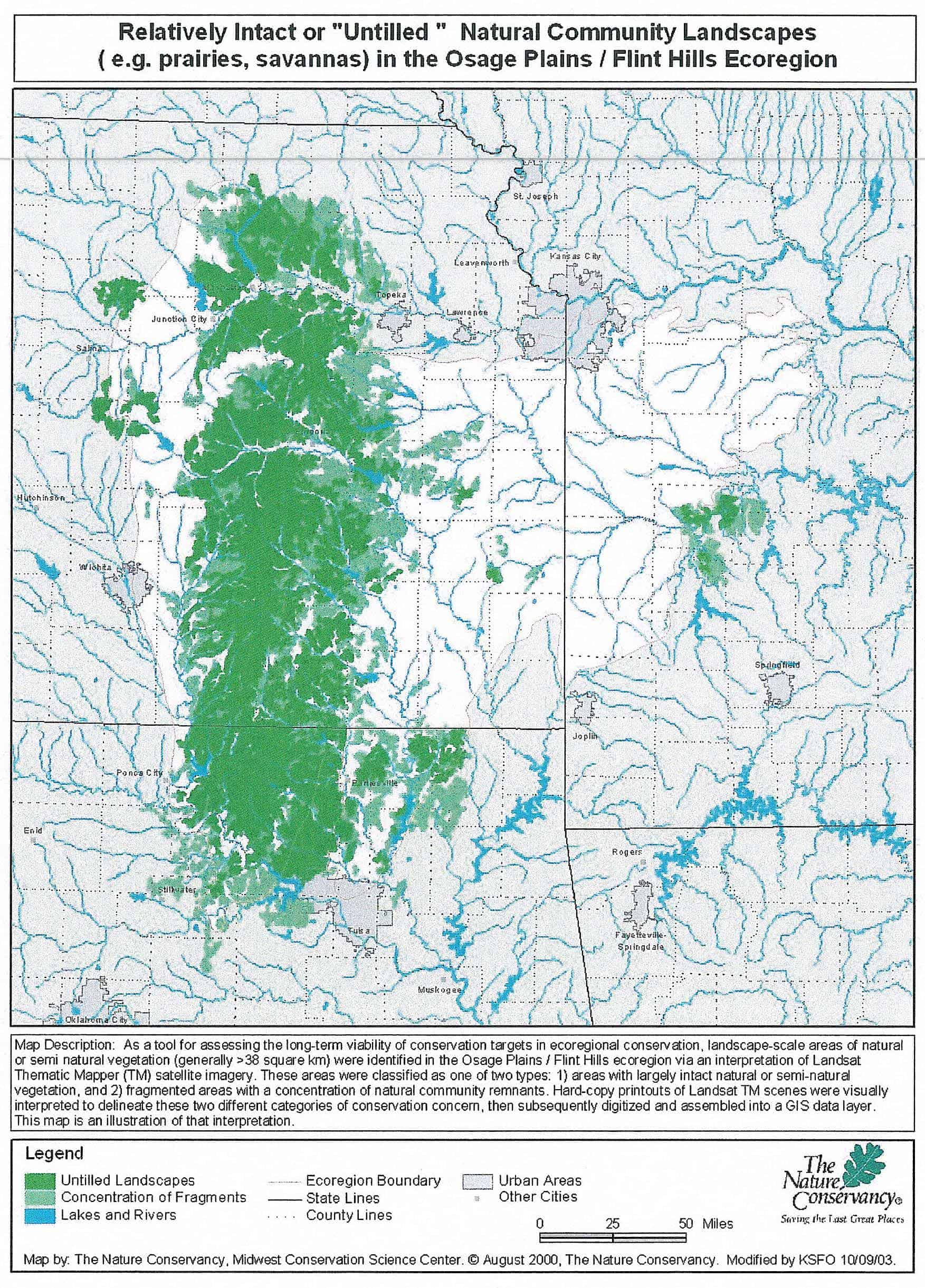 The relatively intact or “untilled” natural community landscapes in the Osage Plains/Flint Hills Ecoregion of the Flint Hills Tallgrass Prairie Regional Environmental System within Kansas and Oklahoma
The relatively intact or “untilled” natural community landscapes in the Osage Plains/Flint Hills Ecoregion of the Flint Hills Tallgrass Prairie Regional Environmental System within Kansas and Oklahoma
40.2 The 3,900 acre Prairie State Park located 35 miles north of Joplin, Missiouri, headquarters of corporate Defendant The Empire District Electric Company, is only half the size of the area of the industrial wind turbine commercial electric power generation facility proposed to be constructed, operated and maintained at Elk River. 40.3 Less than one percent of the original tallgrass prairie that once covered a fourth of the Missouri landscape remains. According to the Missouri Department of Natural Resources, The Prairie State Park offers nearly 70,000 visitors “a chance” to view and experience prairie flora and fauna. 40.4 Many corporations in Missouri support prairie preservation and restoration activities within the State of Missouri. Kansas City Power & Light Company has provided financial support for the partnership efforts of the Missouri Prairie Foundation, Missouri Prairie Foundation and The Nature Conservancy. 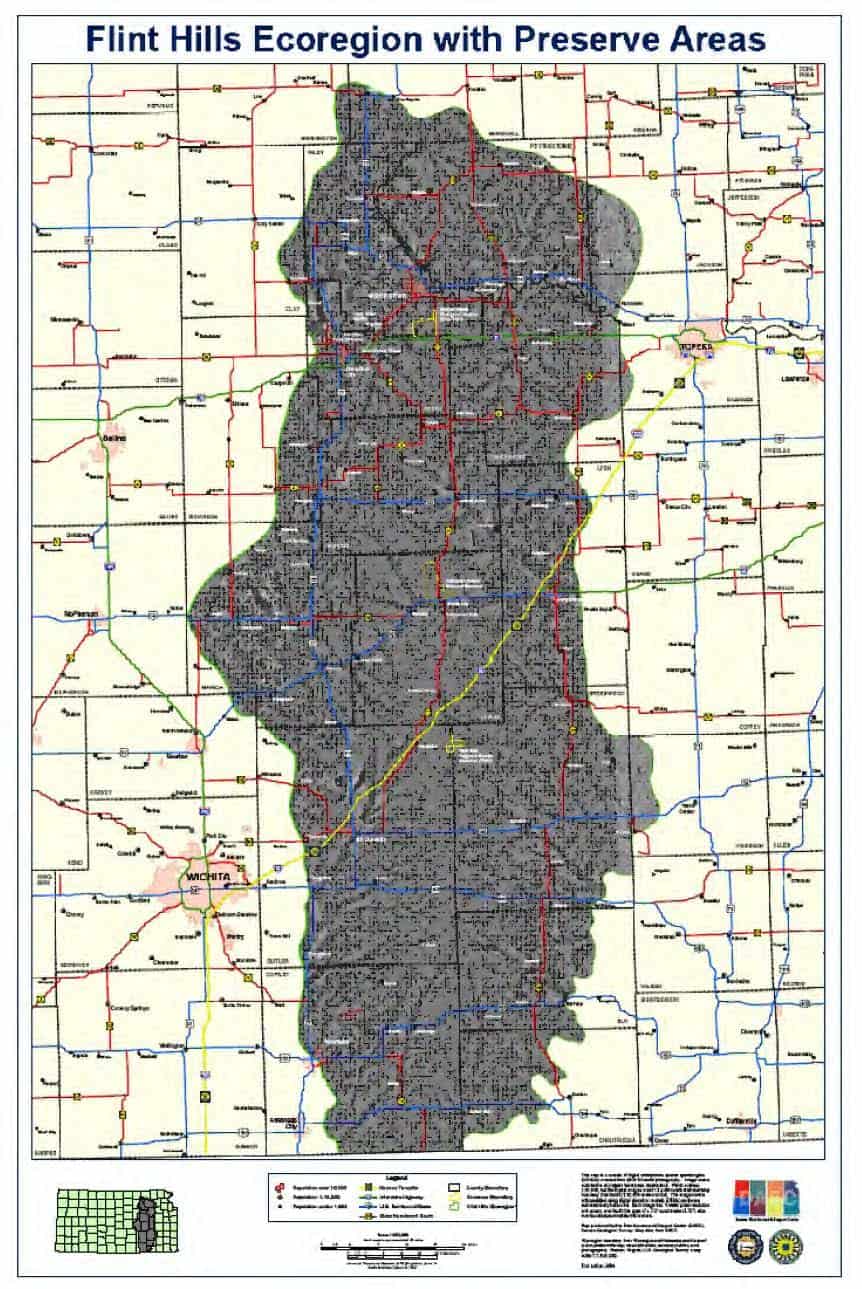
The Flint Hills Ecoregion (USGS)
40.5 The preceding map is a fair and accurate representation of the Flint Hills Ecoregion in the State of Kansas prepared by United States Geological Survey.
41. The Flint Hills Tallgrass Prairie Regional Ecosystem is underlain by distinctive geologic formations of limestone and sandstone that result in differing dominant matrix natural communities which occur contiguously as one surface landform.
41.1 The following photograph is a fair and accurate representation of one of the distinctive geologic formations that characterizes the Flint Hills Tallgrass Prairie Regional Ecosystem.
42. The Flint Hills Tallgrass Prairie Regional Ecosystem includes the Greater Flint Hills which is a limestone-based ecosystem, the Elk Prairie which is sandstone-based and the Ochelata Prairie which is limestone-based.
43. The Flint Hills Tallgrass Prairie Regional Ecosystem landform is characterized by gently sloping, prairie-dominated hills of limestone, shale and sandstone.
43.1 The following photographic exhibit is a fair and accurate representation of such gently sloping, prairie-dominated hills.

Flint Hills Topography
44. The Flint Hills are the source of many of the streams and rivers which are critical elements of the Flint Hills Regional Environmental System. Its shallow loamy soils overlying bedrock combined with a 150 year heritage of ranching are largely responsible for its continued existence relatively free of damage from urban/suburban development and other agents of habitat loss. Many of the streams within the Flint Hills Tallgrass Prairie Regional Ecosystem are remarkably clear and clean. The native prairie drainages contain some of the least contaminated streams in the entire Great Plains.
44.1 The following photographic exhibit is a fair and accurate representation of the prairie dominated hills of the Flint Hills Tallgrass Prairie Regional Ecosystem.

Flint Hills landscape
45. Climate is influenced by the ecoregion’s position within the interior of the continent. Hot continental summer temperatures and cool winters (accentuated by cold arctic blasts) are the norm. A pronounced rain shadow from the Rocky Mountains found throughout the Great Plains is somewhat tempered by periodic to frequent moisture-laden airflow from the Gulf of Mexico.
45.1 The following graphic exhibit prepared by the Kansas Geological Survey shows the annual precipitation over the State of Kansas which is reflected in the vegetation gradient from East to West.
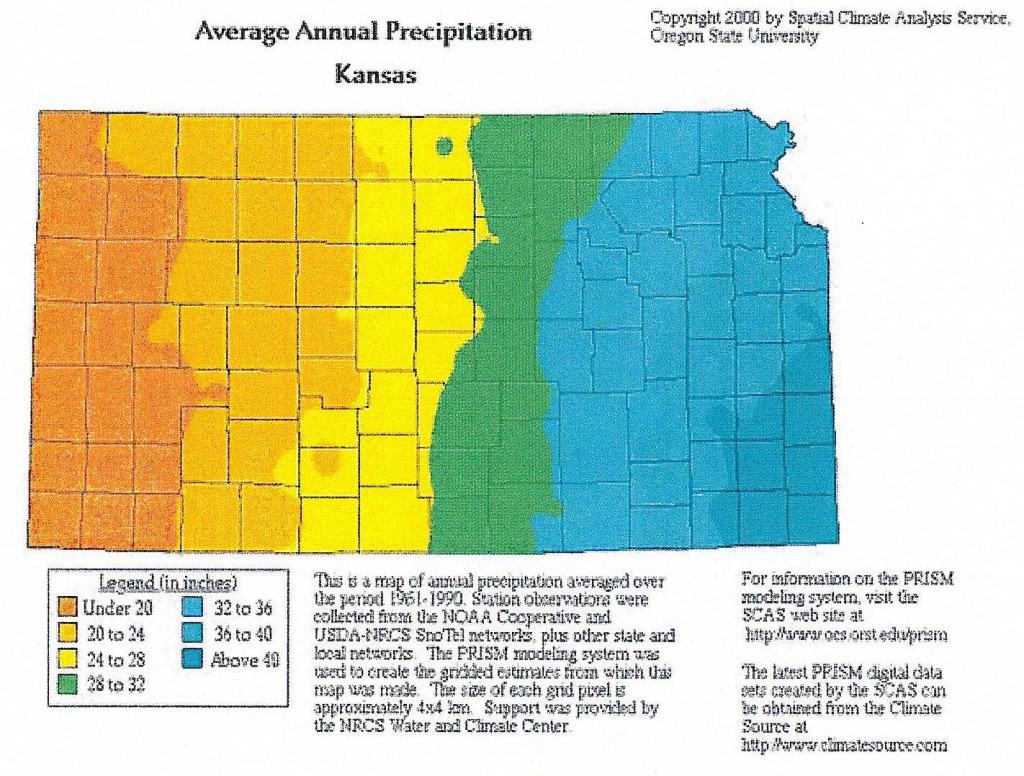
Kansas Annual Precipitation
46. The vast majority of land in the Flint Hills Tallgrass Prairie Regional Ecosystem is in private ownership, although sizeable federal, state, and privately owned preserves are found scattered throughout. The Fort Riley Military Reservation and the 8,616-acre Konza Prairie of The Nature Conservancy are located in the north, the 10,894-acre Tallgrass Prairie National Preserve and The Nature Conservancy’s 2,188-acre Flint Hills Tallgrass Prairie Preserve are located centrally, and The Nature Conservancy’s 38,700-acre Tallgrass Prairie Preserve in Oklahoma anchors the southern end. The United States Army Corps of Engineers manage several reservoirs and associated land. The Kansas Department of Wildlife and Parks owns and manages several fishing lakes and wildlife management areas.
46.1 The following photographic exhibit is a fair and accurate representation of the Elk and Bison herds that once roamed the prairies of the Flint Hills Tallgrass Prairie Regional Ecosystem. Bison are managed on several private ranches and at the Konza Prairie. Elk have been reestablished on the Fort Riley Military Reservation which also maintains a Bison herd. This photograph was made at the Maxwell Game Preserve.
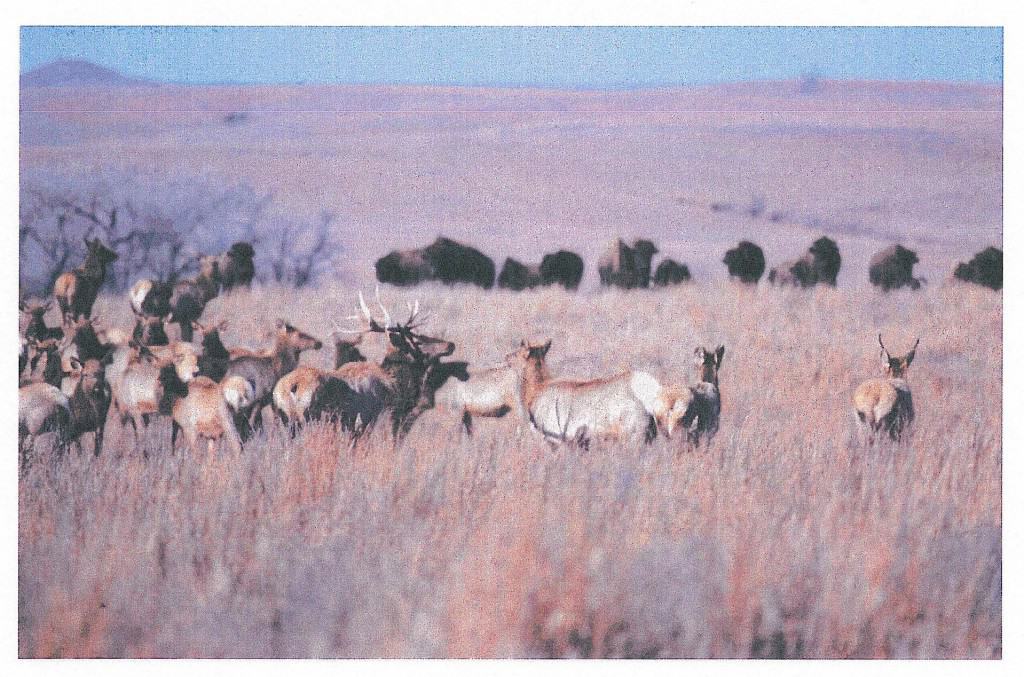
Elk & Bison grazing on the Flint Hills Tallgrass
47. Ranching is the dominant land use throughout much of the Flint Hills Tallgrass Prairie Regional Ecosystem. 47.1 The following photographic exhibit is a fair and accurate representation of ranch activity in the Flint Hills.
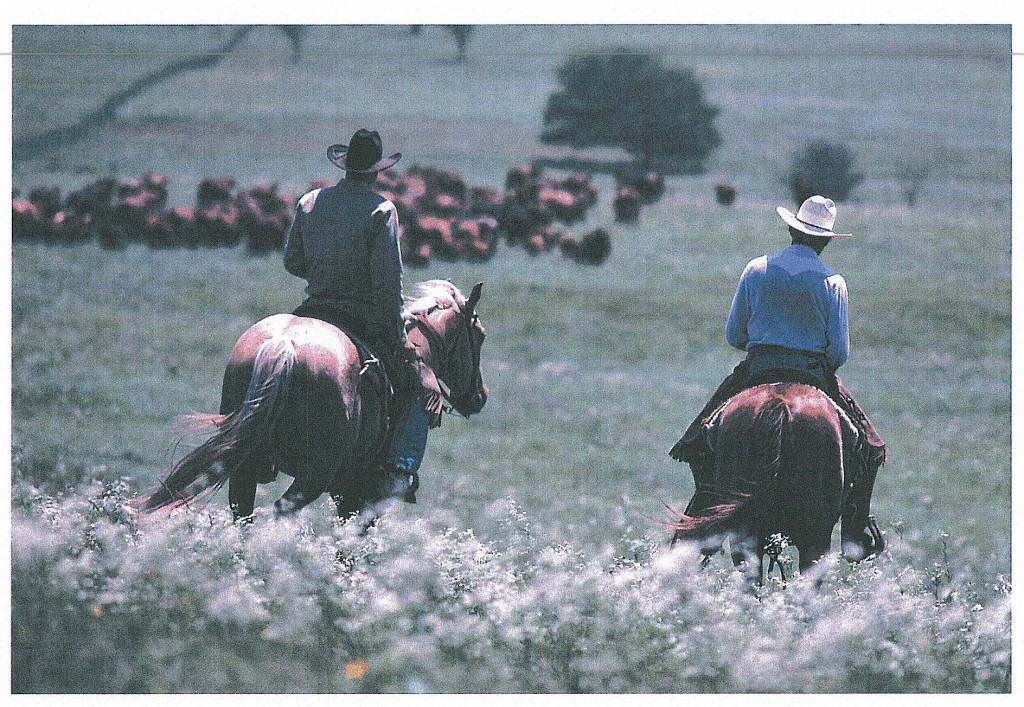
Flint Hills ranchers
47.2 The following photographic exhibit is a fair and accurate representation of working cattle on a Flint Hills Ranch
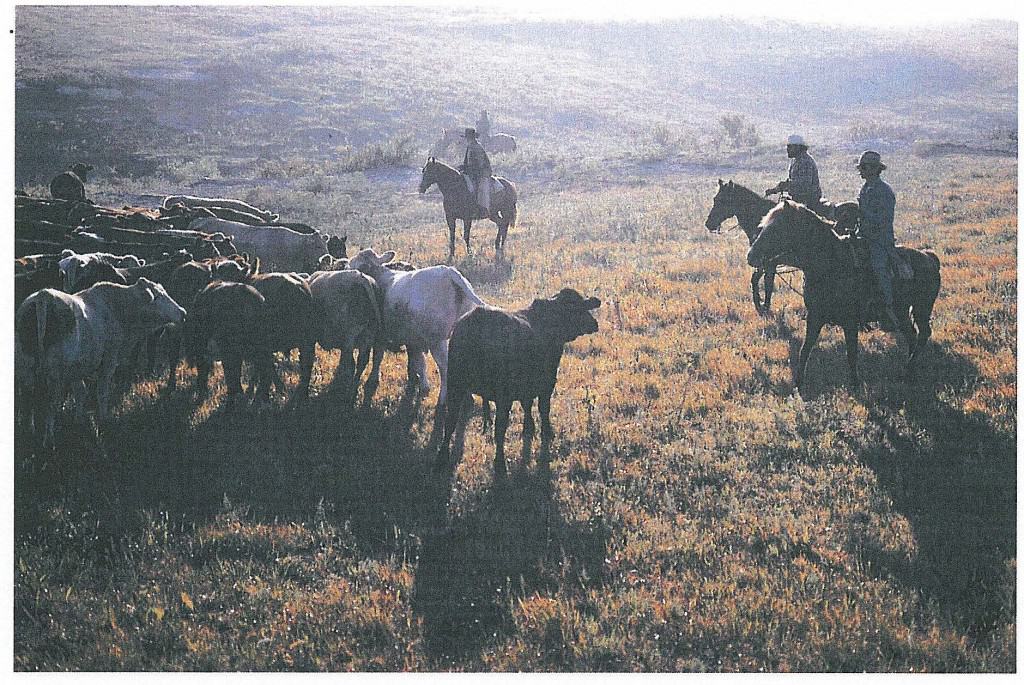
Flint Hills Cattle Ranching
48. Matrix-forming communities are overwhelmingly dominant on the landscape, and serve an important function in the long-term viability of the region, both in terms of habitat and in maintaining the functional networks between and among the species and the complex inter-related environment processes operating within them. Large expanse, small expanse and linear communities most commonly occur as “wet prairies” imbedded in the matrix prairie type or as woodlands confined to narrow bands along streams.
49. Some areas within the Flint Hills Tallgrass Prairie Regional Ecosystem are sparsely populated. Seven of the nine most sparsely populated counties in Kansas are located within this ecoregion. For example, Chase County, Kansas with a population of under 3,000 and a land area of approximately 800 square miles, has fewer than 4 residents per square mile. Moderate size urban areas are located on the flanks of the Flint Hills Tallgrass Prairie Regional Ecosystem: Tulsa and Bartelsville, Oklahoma on the south; Wichita, Kansas to the west; Topeka, Kansas adjacent on the northeast; Manhattan, Kansas within the northern section; and Kansas City, Kansas and Kansas City, Missouri 50–60 miles to the northeast.
Endangered species
50. Federally listed threatened and endangered species within the Flint Hills Tallgrass Prairie Regional Ecosystem include the Topeka Shiner, Neosho Madtom, American Burying Beetle, and Western Prairie Fringed Orchid, Eskimo Curlew, and Bald Eagle. However, the grasslands of the Flint Hills Tallgrass Prairie Regional Ecosystem provide essential habitat for several species experiencing significant declines range-wide such as grassland breeding birds.
50.1 The following photographic exhibit is a fair and accurate representation of the endangered American Burying Beetle.
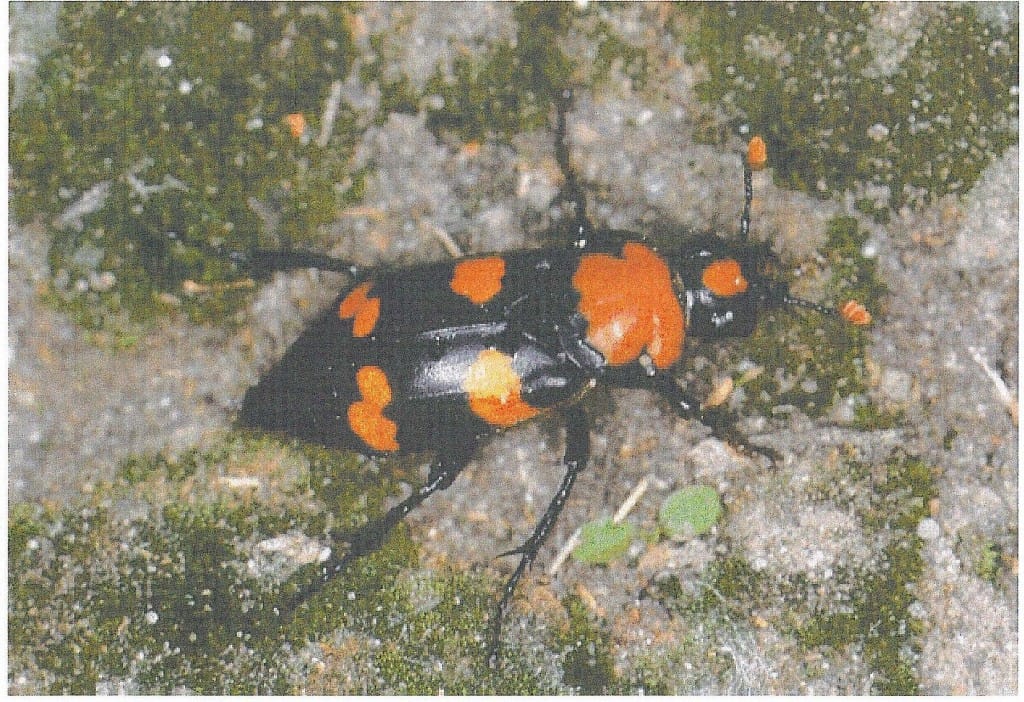
American Burying Beetle
50.2 The following photographic exhibit is a fair and accurate representation of the endangered Western Prairie Fringed Orchid.
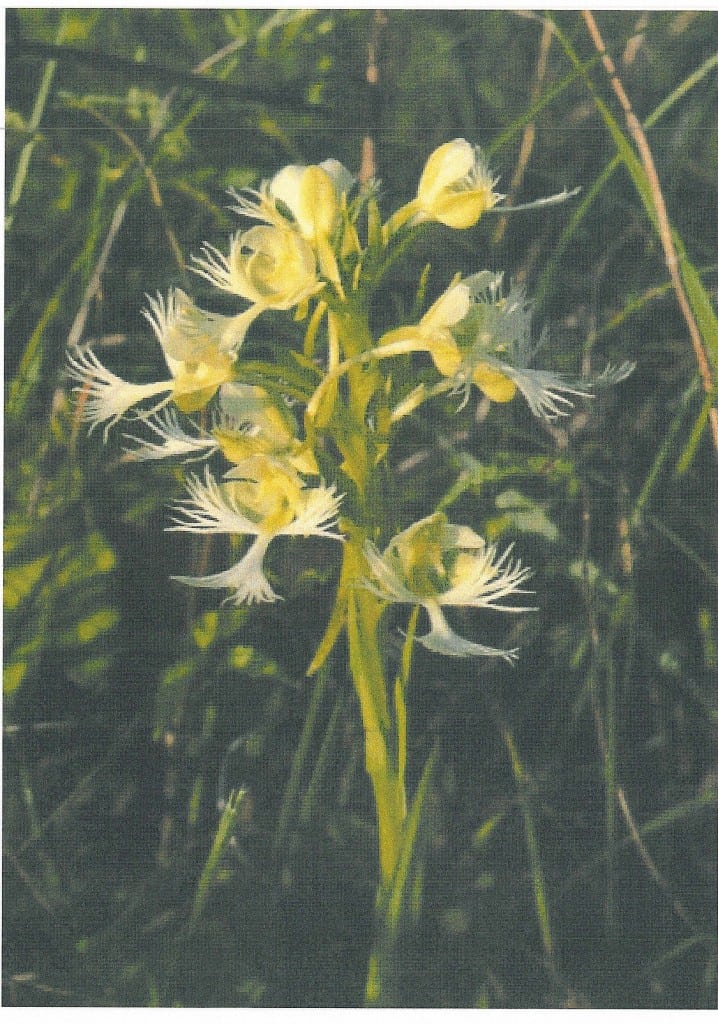
Fringed Orchid
Native Prairie
51. The Flint Hills Tallgrass Prairie Ecosystem is one of the few large areas of native prairie grassland left in the United States. Away from the roads and buildings, the Flint Hills region looks much as it did when Kansas was first settled by European immigrants and citizens from Eastern States. 51.1 The following photographic exhibit is a fair and accurate representation of native prairie grassland.
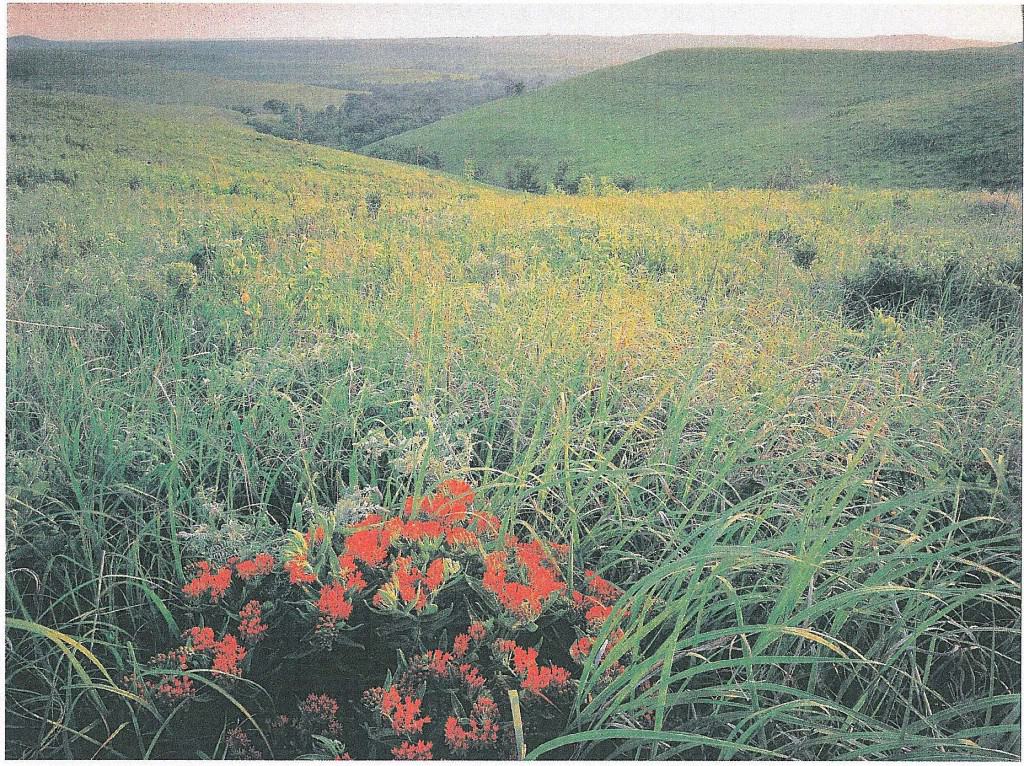
Native Prairie Grassland
52. Tallgrass Prairie once covered more than 140 million acres of the United States and Canada from Indiana on the east to Kansas on the west and from Canada on the north to Texas on the south. Nearly all of it has been plowed under for agriculture but an ancient past survives in the irreplaceable Flint Hills Tallgrass Prairie Ecosystem.
53. Today, the Tallgrass Prairie covers less than 4% of its original area. This makes it one of the rarest and most endangered ecosystems in the world, and one that is profoundly affected by a variety of potential ecological changes.
54. The Tallgrass Prairie Region of Kansas is one of the only remaining intact ecosystems of its type in the United States. Of the 400,000 square miles of Tallgrass Prairie that once covered the North American Continent, less than 4% remains, primarily in the Flint Hills.
55. Nearly two-thirds of all the surviving Tallgrass Prairie in North American lies within the Flint Hills of Kansas.
55.1 The Kansas Natural Heritage Inventory of the Kansas Biological Survey rates the Flint Hills as one of the top conservation priorities for the state of Kansas.
55.2 The Nature Conservancy has identified the Flint Hills as a priority conservation action site.
55.3 Flint Hills Tallgrass Prairie Preserve, a 2,200-acre preserve owned by The Nature Conservancy, has been designated as a globally important bird area by the American Bird Conservancy. 55.4 The following map prepared by the National Geographic Art Division in 1980 fairly and accurately depicts the original extent of the Tallgrass Prairie Regional Ecosystem.
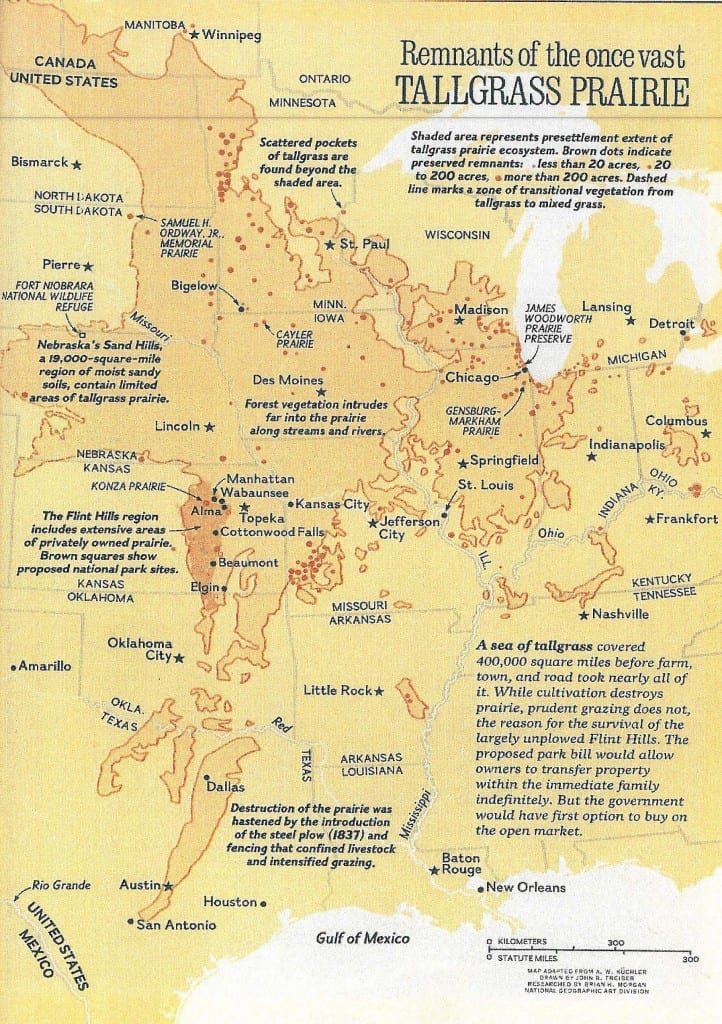
Remnants of once vast Tallgrass Prairie
55.5 The following photographic exhibit is a fair and accurate view of the Flint Hills Tallgrass Prairie National Preserve.
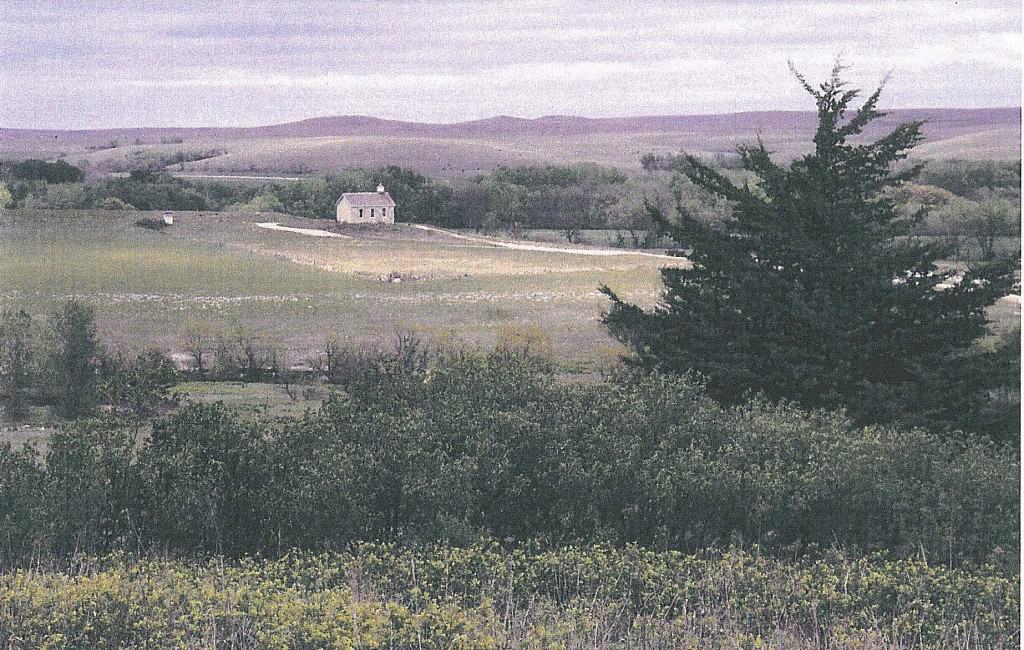
Tallgrass Prairie National Preserve
56. The Flint Hills Tallgrass Prairie Ecosystem is home to the largest area of native prairie grassland in a unit of the National Park System, the Tallgrass Prairie National Preserve, and to a state scenic byway and a candidate state scenic byway. 56.1 The following photographic exhibit is a fair and accurate representation of a state scenic byway designation in the Flint Hills.
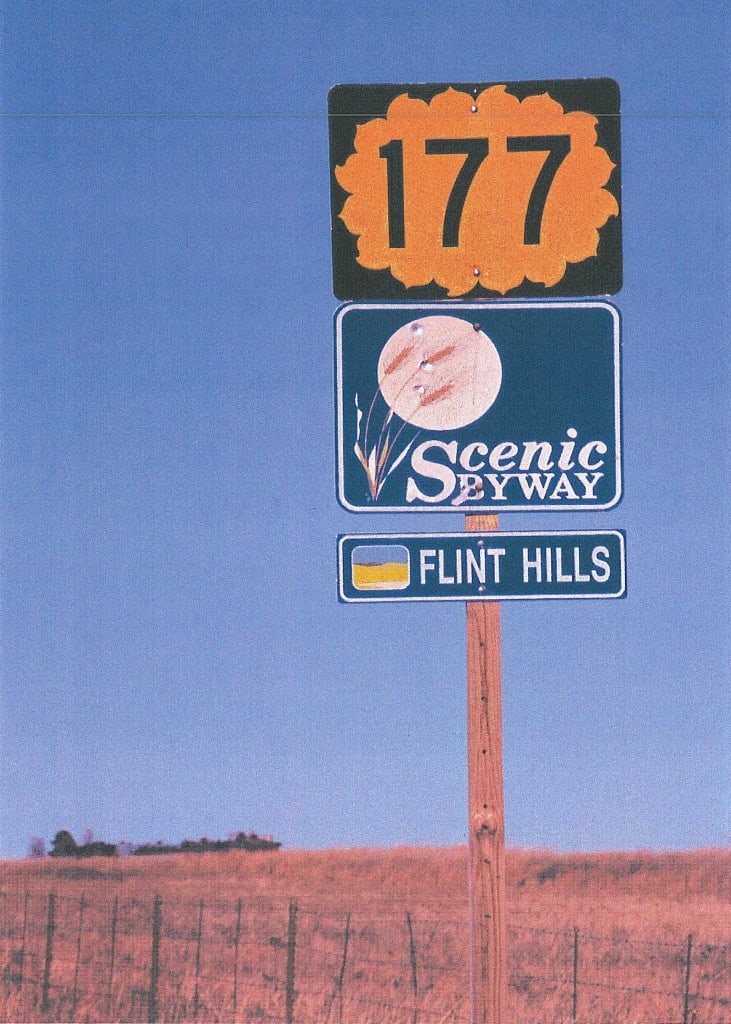
56.1 Scenic Highway Designation Route 177
57. The Flint Hills Regional Ecosystem region hosts a multitude of wildlife species, especially those dependent on expansive grasslands. It is one of the last strongholds of the Greater Prairie-chicken, a signature species of the Tallgrass Prairie ecosystem as well as many other grassland nesting species that, because of habitat loss, have declined more than any other class of birds. The Flint Hills also serve as an important avian migration corridor.
57.1 The following photographic exhibit is a fair and accurate representation of Greater Prairie-chickens.

57.1 Greater Prairie Chickens
57.2 The following photographic exhibit is a fair and accurate representation of migrating White Pelicans flying over the Flint Hills.

57.2 White Pelicans
57.3 The following photographic exhibit is a fair and accurate representation of migrating Snow Geese flying over the Flint Hills.
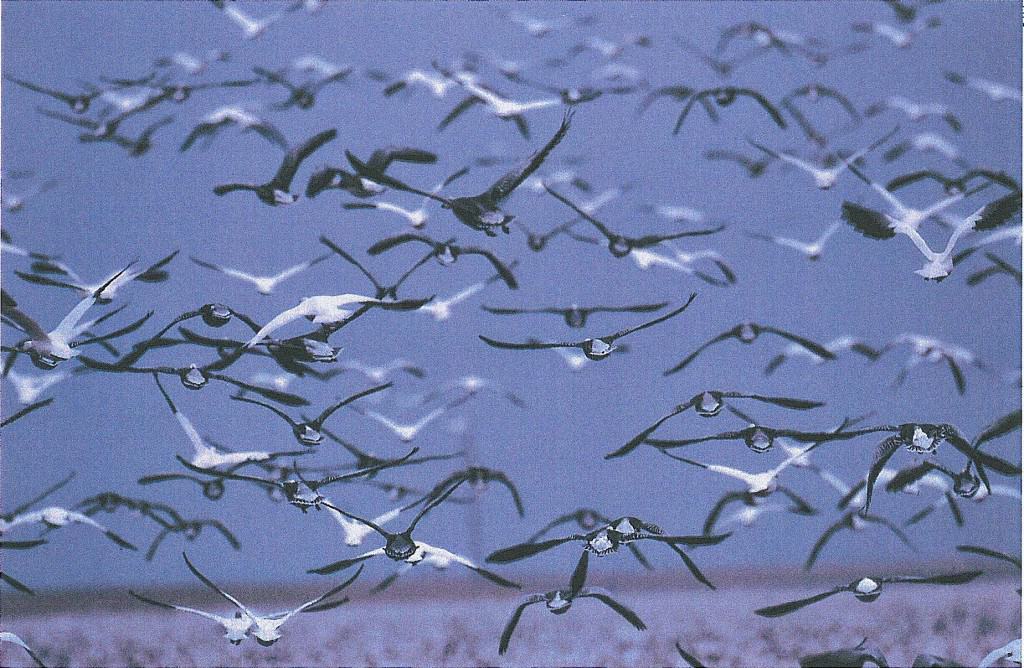
Snow Geese
58. The Flint Hills Tallgrass Prairie Ecosystem is home to approximately 1100 species of plants, 100 species of butterflies and moths, 100 species of fish, 78 species of reptiles and amphibians, 300 species of birds, and 31 species of mammals. Approximately 700 species of plants have been identified at Tallgrass Prairie Preserve in Oklahoma and more than 4OO species at Konza Prairie.
58.1 The following photographic exhibit is a fair and accurate representation of wild rose hips which are a plant species indigenous to the Flint Hills Tallgrass Prairie Regional Ecosystem.
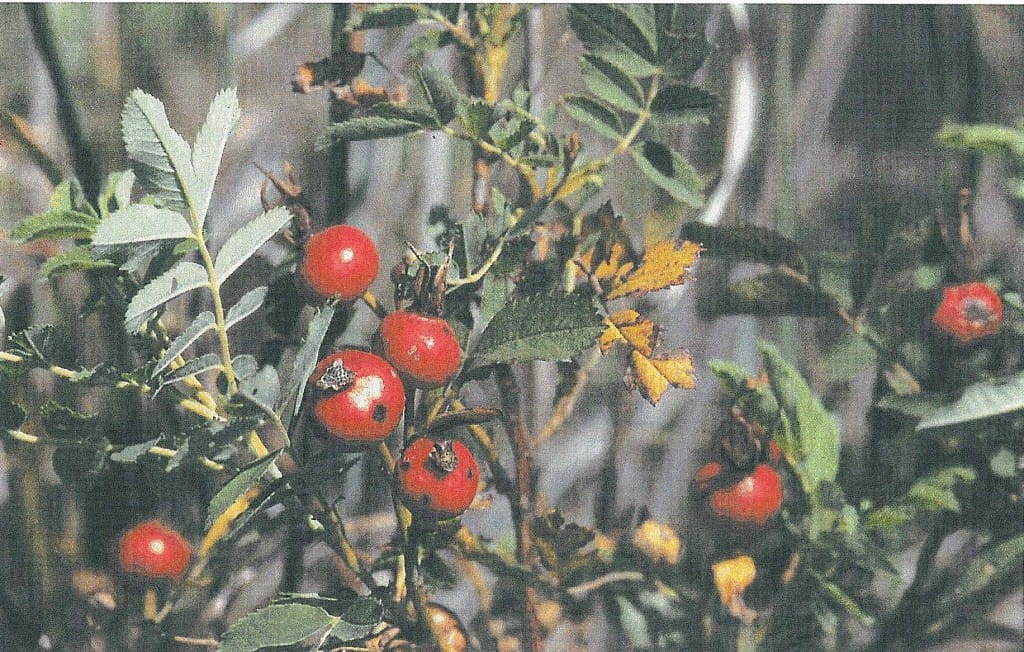
Rose Hips

pink Shooting Star
58.2 The preceding photographic exhibit is a fair and accurate representation of a pink Shooting Star which is a plant species indigenous to the Flint Hills Tallgrass Prairie Regional Ecosystem. 58.3 The following phototograhic exhibit is a fair and accurate representation of a Collared Lizard, a species of reptile indigenous to the Flint Hills Tallgrass Prairie Regional Ecosystem.
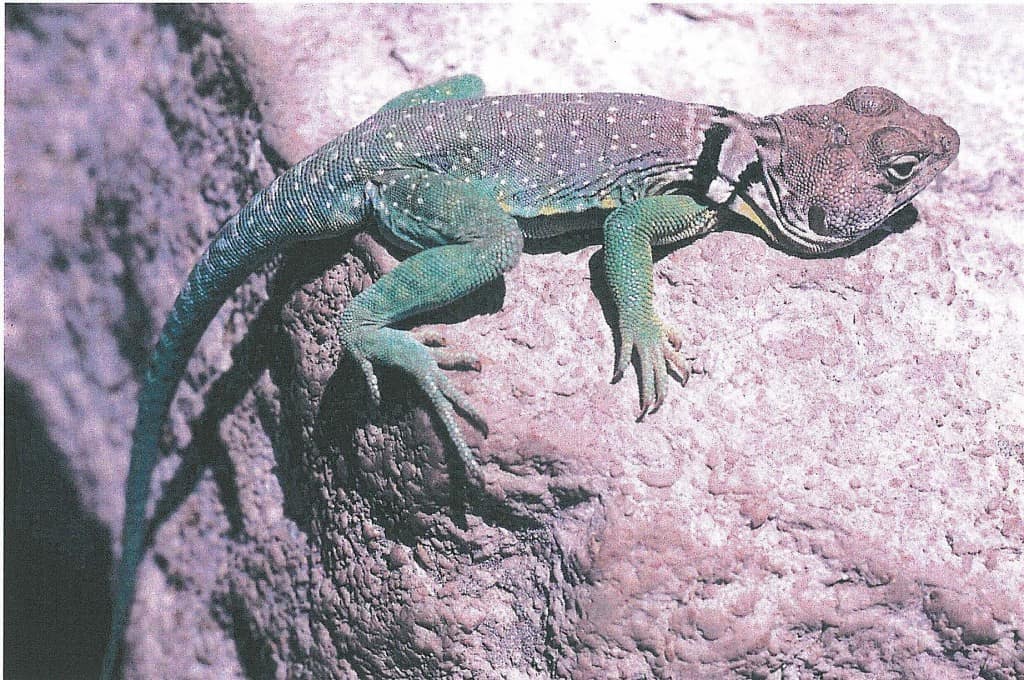
Collared Lizard
59. The open and undeveloped spaces of the Flint Hills Tallgrass Prairie Ecosystem are the equivalent resource in scale and spectacle to Florida’s Everglades. Yet, the Tallgrass Prairie Preserve and adjacent prairie lands are a largely neglected resource.
60. The World Wildlife Fund has recognized the Flint Hills as one of only six grasslands in the contiguous U.S. that is globally outstanding for biological distinctiveness.
61. The Flint Hills Regional Ecosystem is a unique national and international resource treasure still relatively unspoiled by the pressures of modern development and worthy of meaningful preservation.
62. The Flint Hills is home to many ranchers and landowners who have been traditional stewards of the prairie and who desire to retain the agricultural and ranching heritage by preserving the native grasslands for future generations.
63. The combination of the rich cultural, historical and ecological resources in the Flint Hills coupled with its natural beauty endows Kansas with an unparalleled asset. These attributes create an under-utilized opportunity for nature and agriculture based tourism, which have tremendous potential to improve the economy of the region as well as the State.
Tallgrass Prairie National Preserve
64. The Tallgrass Prairie National Preserve is 10,894 acres of rolling grassland located in northern Chase County, in the heart of the Flint Hills region. Two major creeks, Fox Creek and Palmer Creek, numerous springs, seeps, and stock ponds dot the landscape. Prominent buildings and structures link the site to its ranching history along with a unique collection of cultural and natural features, allowing the Tallgrass Prairie to tell the story of human interaction with the environment from pre-contact times to the present.
64.1 The following photographic exhibit is a fair and accurate representation of the historic ranch house at the Tallgrass Prairie National Preserve.
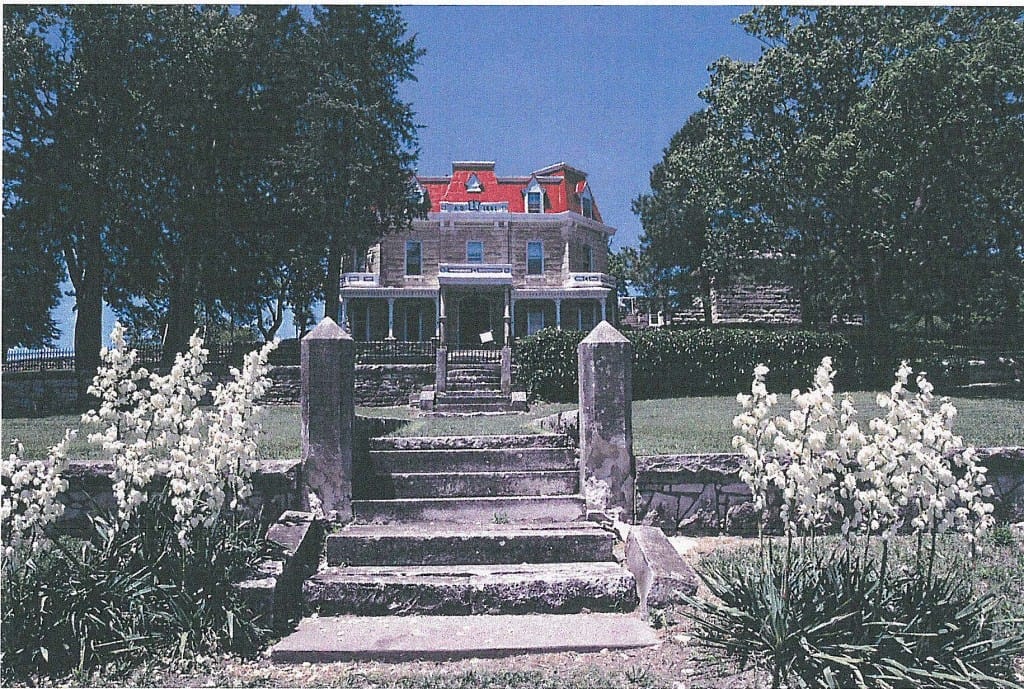
Flint Hills Historic Ranch House
64.2 The following photographic exhibit is a fair and accurate representation of Fox Creek School and a diversity of prairie plants on the Tallgrass Prairie National Preserve.
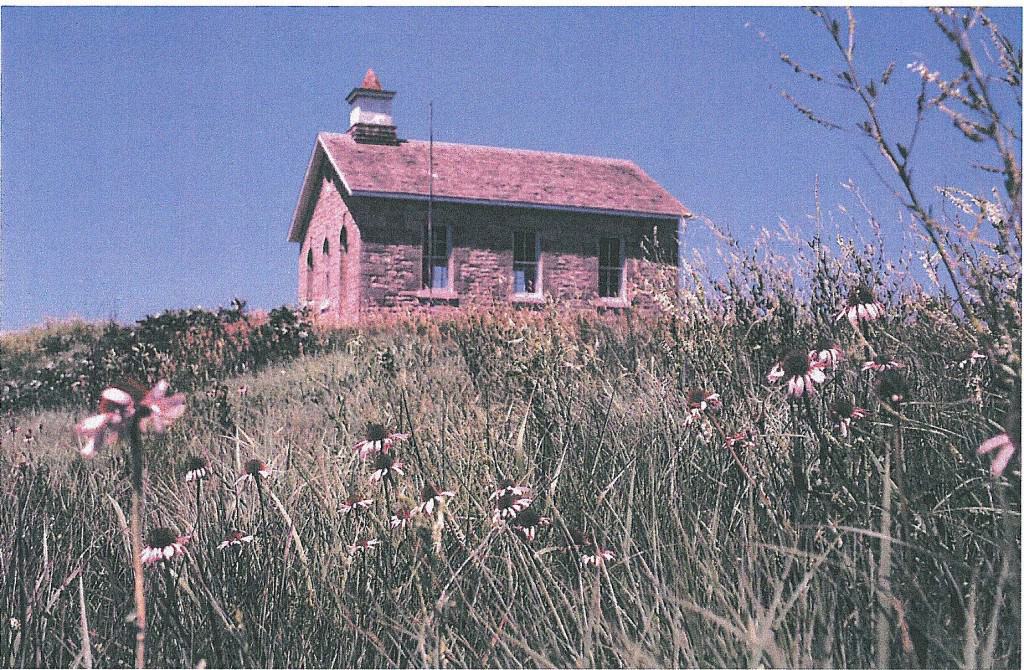
Fox Creek School House
Legislative History
65. The Tallgrass Prairie National Preserve, previously known as the Z-Bar (Spring Hill) Ranch, was proposed by Ron Klatasake, West Central Regional Vice President of the National Audubon Society in January 1989. The West Central Regional Office of the National Audubon Society, the predecessor to Audubon of Kansas, Inc., obtained a purchase agreement on the property from Boatmens National Bank of Kansas City in June 1988. Members of the Kansas Congressional delegation were informed and a plan was developed to be shared with the public. The proposal was based on purchase of the property on a willing-seller basis to establish a Tallgrass Prairie unit of the National Park system.
65.1 The National Park Service had recognized the need for a true Tall Grass Prairie National Park since the 1950s. In 1962 the U.S. Department of The Interior proposed establishment of a 57,000 acre “Prairie National Park” in Pottawatomie County Kansas. However, following United States Corps of Engineers acquisition of thousands of acres of adjacent land for construction of the Tuttle Creek Dam and reservoir, the prospect of additional forced sales was bitterly opposed by many local landowners and other residents and that proposal was dropped.
65.2 However, interest in preserving a substantial representative of tallgrass prairie remained high among Kansas residents, ecologists and scientists, and several national conservation organizations. An organization named the Save The Tallgrass Prairie (STP) was formed to specifically promote establishment of a Tallgrass Prairie National Park. When the Kansas Congressional Delegation was approached with a request to pursue legislative sponsorship in 1973 members of the delegation expressed reluctance because a specific site and size had not been identified.
65.3 Audubon’s Kansas-based representative at that meeting, recommend commission of a study by the National Park Service, and the delegation proceeded with a $50,000 appropriation request. Congressman Keith Sebelius (R-KS) served on the National Parks Subcommittee and he provided leadership support, along with Senator James B. Pearson (R-KS).
65.4 The National Park Service completed a comprehensive study of sites in 1975 and all of the remaining intact prairie landscapes were evaluated and mapped. The only sites worthy of evaluation were located in the Flint Hills Tallgrass Prairie Ecoregion. Three sites consisting of from approximately 60,000 acres to 90,000 acres were suggested as most suitable including one in Wabaunsee County, another principally in southeastern Chase and eastern Butler counties, and a third in the southern Flint Hills of Kansas extending into Osage County Oklahoma.
65.5 A bill was introduced by Congressman Larry Winn (R-KS) in 1977 calling for creation of a 185,000 acre Tallgrass Prairie National Park and Preserve. Kansas conservationists had generally pursued the concept of a 60,000 to 90,000 acre national park consistent with the National Park Service report-:—it was acknowledged that for grassland birds and most plant and animal species of the Flint Hills Tallgrass Prairie Regional Ecosystem landscape of traditionally managed rangeland would effectively provide genetic diversity and enhance population survival. The National Audubon Society’s west central regional office/regional representative and the Kansas Audubon Council did not endorse the proposal because it was based on acquisition of private ranch land by eminent domain.
65.6 Ranchers, agricultural organizations and many others strongly opposed the legislation for the same reason. The threat of eminent domain and the determination of most landowners to retain their property, and for many the concern for their family heritage of many generations associated with the land, and their way-of-life caused Audubon to explore other approaches to establishing a National Park.
65.7 Some ecologists suggested that a large prairie landscape was needed to maintain a functioning ecosystem with representative flora and fauna, and to provide visitors with an opportunity for a “prairie experience”. As Walt Whitman observed and elegantly wrote in 1879: “While I know the standard claim is that Yosemite, Niagara Falls, the Upper Yellowstone and the like afford the greatest natural shows, I am not so sure but that the Prairies and Plains last longer, fill the esthetic sense fuller, precede all the rest and make North America’s characteristic landscape.”
65.8 Audubon’s regional vice president began working with William R. Browning of Madison and other ranchers to pursue alternative acquisition approaches.
65.9 In October 1983 the 30,000 acre Barnard Ranch in Osage County Oklahoma was advertised for sale. With approval of the trustees for the property, Audubon suggested consideration of legislation that would incorporate the Chapman-Barnard Ranch within the boundaries of a 60,000 acre Tallgrass Prairie National Park or Preserve, and authorize acquisition of the Barnard Ranch. Additional owners of the adjacent Adams Ranch later expressed willingness to have their property included in a national park service proposal.
66. Legislation was introduced with bipartisan support of all members of the Oklahoma Congressional Delegation . Prospects for passage were bright. However, one of four major conservation organizations, the Sierra Club, raised objections to some provisions of the bill in a manner that was inconsistent with a prior pledge and agreement with members of the delegation. As a result, a key member of the Oklahoma Delegation withdrew his support and the opportunity to establish a Tallgrass Prairie National Preserve administered by the National Park Service in Oklahoma with federal acquisition of major portions of the Barnard, Chapman and Adams ranches was lost.
66.1 The Adams Ranch was sold, and then in an attempt to preserve the Barnard Ranch specifically for conservation purposes Tulsa businessman Joe Williams spearheaded a successful effort to acquire the property for a prairie preserve under the stewardship of The Nature Conservancy.
66.2 A bill to create the Tallgrass Prairie National Preserve in Kansas and provide for acquisition by the National Park Service was initially drafted by Audubon and Chase County community leaders and then introduced by Congressmen Dan Glickman (D-KS), Jan Meyers (R-KS) and Jim Slattery (D-KS). The bill was approved by the United States House of Representatives on 15 October 1991. However, the United States Senate did not follow the House’s leadership during that session of Congress.
67. In 1974 the National Parks and Conservation Association, creator of the National Park Trust, agreed to purchase the Z-Bar (Spring Hill) Ranch with the National Audubon Society holding the purchase agreement. U.S. Senator Nancy Kassebaum lead congressional efforts to authorize the Preserve. She sponsored a bill that limits federal ownership of the preserve to a maximum of 180 acres. The remainder of the property was to be owned by the National Park Trust or a successor conservation entity. Currently, the Park Service owns 32 acres. The balance of the ranch is owned by the National Park Trust, a non-profit group that purchases lands to protect them from development. The trust sold a 35 year cattle grazing lease to raise funds for operations and mortgage payments.
68. In January 2004, Governor Sebelius announced plans to involve the State of Kansas in a more active role in the development of the entire Z-Bar Ranch. On April 6, 2004, the Governor hosted a special conference in Cottonwood Falls to discuss the purchase of the Preserve by the Kansas Park Trust, a new private trust that will replace the National Park Trust as the owner of the Z-Bar Ranch. Even with transfer of ownership, the Preserve could still be managed by the National Park Service. Under the leadership of Governor Sebelius, former Senator Kassebaum-Baker, former USDA Secretary Dan†Glickman, and former Governor Mike Hayden, the Kansas Park Trust proposed to raise private monies to cover the current mortgage and re-purchase the grazing rights. The new plan calls for re introducing a few Bison, building a visitor’s center, and extending hiking trails. These measures, along with prairie restoration activities will enhance visitor interest and increase tourism in Chase County and the Flint Hills.
69. On November 12, 1996, legislation was passed creating the The Tallgrass Prairie National Preserve in the Flint Hills region of Kansas and a General Management Plan (GMP) was completed in September 2000
70. The Tallgrass Prairie National Preserve is a public/private partnership and its mission is to preserve and enhance a nationally significant remnant of the Tallgrass Prairie ecosystem and the processes that sustain it; preserve and interpret the cultural resources of the preserve and the heritage associated with the ranch property; and offer opportunities for education, inspiration, and enjoyment through public access to its geological, ecological, scenic, and historical features.
71. The Tallgrass Prairie National Preserve has been established as a unit of the National Park System to preserve, protect, and interpret for the public a remnant of the once vast Tallgrass Prairie ecosystem.
72. The Tallgrass Prairie National Preserve is a new kind of national park. The preserve is 10,894 acres. Most of that land has remained under the ownership of the National Park Trust, which purchased the land in 1994.
73. According to the National Park Service Grasslands Management Plan, this remnant exists today because of a complex history of interaction between people and the land.
74. Included in the Grasslands Management Plan are about a dozen “desired futures,” or conditions that will allow the preserve to achieve its purpose. Among these is an open and unobstructed view: “The vistas and views have been repeatedly identified by the public as some of the Preserve’ s most important resources. The relationship of earth and sky, the feeling of vastness, and the openness of the landscape all contribute to a ‘sense of place’. Existing developments should be managed to enhance views (i.e. power lines buried), and future developments should enhance and not detract from this important resource.”
74.1 The following photographic exhibit is a fair and accurate representation of sunset on the Tallgrass Prairie.

Sunset over the Tallgrass Prairie
74.2 The preceding photographic exhibit is a fair and accurate representation of earth and sky on the tallgrass prairie.
75. The 1996 legislation calls for the entire acreage to be managed cooperatively by the National Park Service and the National Park Trust.
76. On September 20, 2002, the National Park Trust donated to the National Park Service approximately 32 acres which included the historic 1880s ranch house, limestone barn and outbuildings, and one-room schoolhouse.
The Konza Prairie Site
77. The Konza Prairie Biological Station (KPBS) is representative of native Tallgrass Prairie in the Flint Hills of eastern Kansas. Because of the relatively steep topography and rocky soils characteristic of the region, this grassland has never been plowed.
78. Konza Prairie was established as a research natural area in 1972 primarily as a result of the efforts of Lloyd C. Hulbert. The first acquisition involved 916 acres near Interstate 70. A Conservancy office was not established at the time, and in the early 1970s when the 7,220 acre Dewey Ranch was listed for sale Ron Klataske, the west central regional representative of the National Audubon Society contacted The Nature Conservancy through Dr. E. Raymond Hall encouraging TNC to consider the potential acquisition. He was in the Riley County Courthouse obtaining the requested legal description on the day the Manhattan Mercury reported that the property had been sold in a private sale. The Conservancy later purchased the property from that party.
78.1 The following photographic exhibit is a fair and accurate representation of a bull elk.

Bull Elk in the Tallgrass Prairie
79. The land was originally acquired by the Nature Conservancy with funds provided by Katherine Ordway and is leased to the Division of Biology at Kansas State University for research purposes. Dr. Hulbert initially established a watershed-level fire-frequency experimental design that included-replicated unburned and annual, 2, 4, and l0 year frequencies of prescribed spring fire. Overlaid on this design was a grazing experiment with blocks of watersheds designated as ungrazed, grazed by native ungulates (Bos bison) and watersheds grazed by domestic cattle (Bos taurus). With only minor modifications, Dr. Hulbert’s design has been fully implemented. Fire treatments have been maintained in the southernmost watersheds since 1971, and throughout the rest of Konza Prairie since 1979. Bison were reintroduced to Konza Prairie in 1987 and experimental cattle herds in 1992. The union of Hulbert’s experimental plan for Konza Prairie with the National Science Foundation Long Term Ecological Research (LTER) initiative has resulted in a statistically robust, ecological research program designed to elucidate patterns and processes important in Tallgrass Prairie. In contrast to a monitoring approach to long-term studies, the Konza Prairie LTER program is an example of an experimental paradigm with a long time frame. As such, it contains what Krebs (1991) has argued are the “essential components of the 21st century” research program.
79.1 The following photographic exhibit is a fair and accurate representation of ongoing research activity in the Tallgrass Prairie of the Flint Hills. It shows Dr. Lloyd C. Hulbert in Prairie Cordgrass.
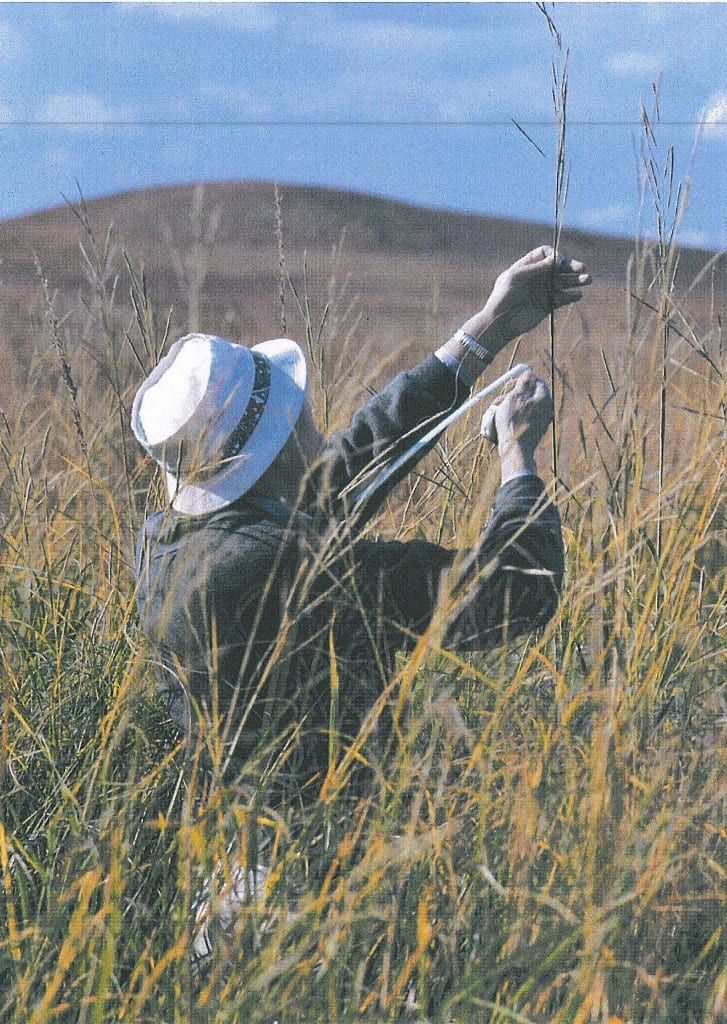
Dr. Lloyd C. Hulbert in Prairie Cordgrass
79.2 The following photographic exhibit is a fair and accurate representation of a controlled burn during the springtime on the Flint Hills Tallgrass Prairie. Controlled burning as an alternative to prairie wildfires is a management practice employed by ranchers and prairie managers fnroughouf file FlinCHills Tallgrass Prairie Regional Ecosystem and it is a subject of research at Konza Prairie.
79.3 The following photographic exhibit is a fair and accurate representation of adult Bison cows with a calf in the tallgrass prairie at Konza.
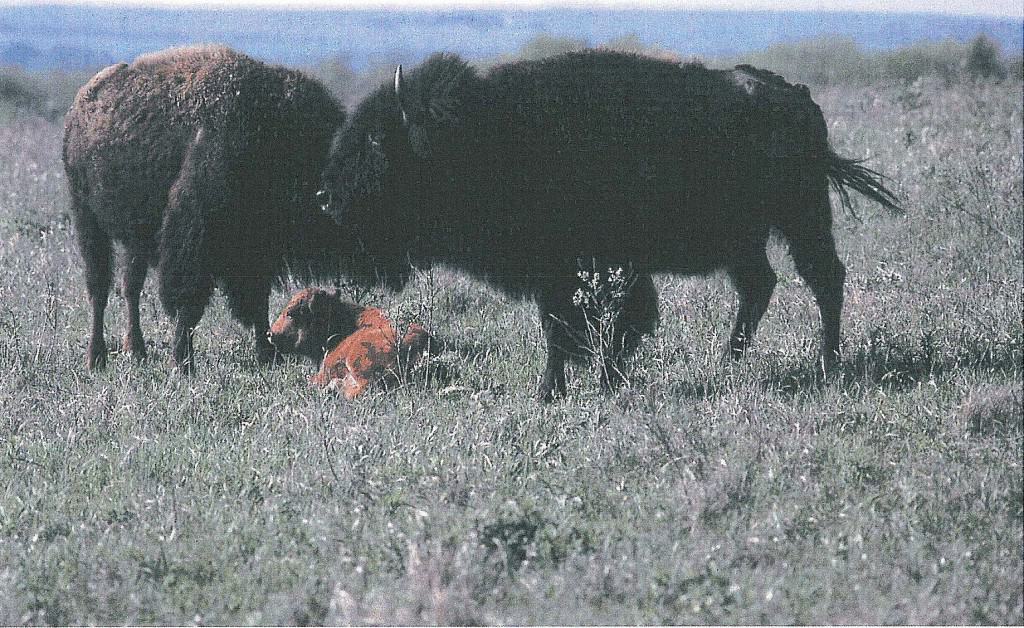
Bison cows and calf
The LTER Program
80. The National Science Foundation’s Long Term Ecological Research (LTER) Program began funding research in 1981 after a series of workshops and planning meetings in the late 1970s. Rationale for development of the LTER program included explicit recognition of the low rate of change of many significant ecological processes, the importance and prevalence in most ecosystems of rare events and episodic phenomena with long return intervals, the tremendous interannual variability of many ecological processes, and the value of long-term databases for providing the context for shorter term studies.
80.1 The LTER program was designed to support a multidisciplinary approach to addressing long-term questions in a wide variety of biomes in North America and beyond. Coordinated research among the network of LTER sites (numbering 24 in 2000) is encouraged to enhance our understanding of ecological phenomena and processes operating over broad spatial scales, as well as long-time scales.
80.2 LTER sites conduct research in 5 general “core” areas. These core areas focus on understanding and documenting (1) patterns and controls of primary production (to study the energy limitations to ecosystem function), (2) spatial and temporal dynamics of key populations (selected to represent trophic structure to identify major pathways of mass and energy transfer and the structural organization of the ecosystem), (3) patterns and controls of organic matter accumulation in surface layers and sediments (to elucidate storage and processing of biological materials), (4) patterns of inorganic input and movements through soils, groundwater, and surface water (to assess interactions among geochemical and biological processes), and (5) patterns and frequency of disturbances to the system (to compare nature and humans as perturbers of natural systems).
80.3 Konza Prairie was one of the 6 original LTER sites selected by National Science Foundation in 1981.
80.4 From 1981 through 1986, the initial research program involved comparative investigations of biotic responses to fire and climatic variability. Long-term research sites and sampling protocols were established during this period with an emphasis on studies of the extremes of annually burned vs. unburned watersheds and upland vs. lowland sites.
80.5 From 1986 through 1990, research efforts expanded to include a wider range of fire frequencies, specifically 4-yr fire cycles, and increased exploration of ecosystem responses. Researchers began to address more complex questions of scale and make use of remotely-sensed satellite data to explore landscape-level issues.
80.6 From 1991 through 1996, the primary research goals were to understand how grazing influences biotic and ecosystem processes and patterns imposed by fire frequency over the landscape mosaic, all of which are subjected to a variable and possibly directional climatic regime. The additional research associated with large ungulate grazing and an expanded landscape perspective were designed to complement programs at other LTER sites as well as enhance efforts within the LTER core areas.
80.7 From 1996 through 2002, researchers continued to build on existing long-term studies of fire, grazing and climatic variability with a broadly-based research program encompassing studies from the organismic through population, community, ecosystem and landscape levels. The research effort expanded to include studies of climate change, net carbon exchange, restoration ecology and land use/land cover change. These studies are thematically linked via an overarching theme that explicitly includes a non-equilibrium perspective on ecological patterns and processes in this grassland and which addresses the major abiotic and biotic factors influencing this ecosystem.
81. The central hypothesis of the Konza research effort is that fire, grazing and climatic variability are essential and interactive factors responsible for the structure and dynamics of Tallgrass Prairie. In contrast to many other grasslands where ecological processes are constrained by chronic limitations of a single resource such as water, organismic to ecosystem processes and dynamics in Tallgrass Prairie are products of spatial and temporal variability in multiple limiting resources including water, light, and Nitrogen. Variability in, and switching among, these primary limiting resource(s) are caused by both extant and historical fire, grazing and climatic regimes. Moreover, responses to these factors are strongly dependent on topographic and landscape position. As a result of this complexity, and because grazing and fire regimes are managed in grassland systems worldwide, data from the Konza Prairie LTER program have relevance not only for understanding this grassland, but for broader ecological issues such as stability-diversity questions and interactions among land-use, biodiversity and climate change.
81.1 The following photographic exhibit is a fair and accurate representation of the Flint Hills Tallgrass Prairie at Konza in the fall.
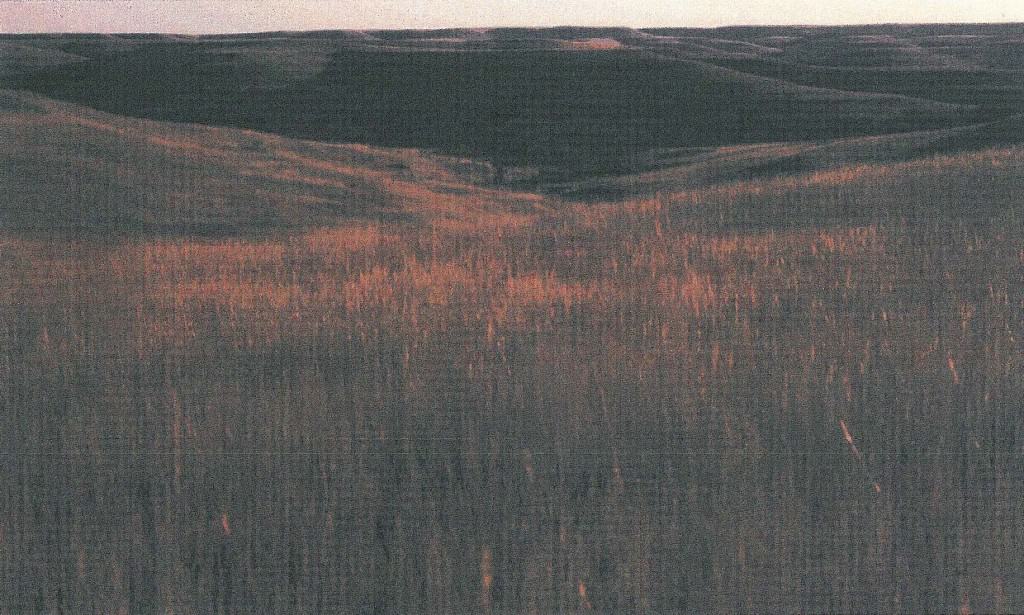
Tallgrass prairie at Konza
Prairie Parkway
82. In 1967 the Kansas Legislature passed a bill establishing the Prairie Parkway extending south from the Pony Express Station near Hanover through the Flint Hills to Elgin. Elgin is near Sedan, a community that is striving to project a prairie heritage and the tourism potential of the southern Flint Hills with help from Bill Kurtis.
82.1 The following photographic exhibit is a fair and accurate representation of the Kansas State identification sign for the Prairie Parkway.

82. Prairie Parkway
83. The Tallgrass Prairie National Preserve is one of the flagship attractions along the parkway. Audubon of Kansas in partnership with the Kansas Department of Transportation and the Division of Tourism in the Kansas State Department of Commerce is currently developing a statewide system of Kansas Birding and Natural Heritage Trails including a Tallgrass “Prairie Parkway” Birding and Natural Heritage Trail closely following the Prairie Parkway route. A six-state “Prairie Passage” parkway from Texas to Minnesota is considering two routes which include the southern and central Flint Hills.
84. The Skyline-Mill Creek Scenic Drive is another long established scenic route in the Flint Hills. It was designed by Wabaunsee County officials and it extends largely on county roads from Alta Vista through Alma to I-70 east of Paxico.
85. The proposed Munker’s Creek industrial wind turbine commercial electric power generation facility site will be visible from this route. 85.1 The following photographic exhibit is a fair and accurate representation of winter on the Flint Hills Tallgrass Prairie as seen from the Prairie Parkway.
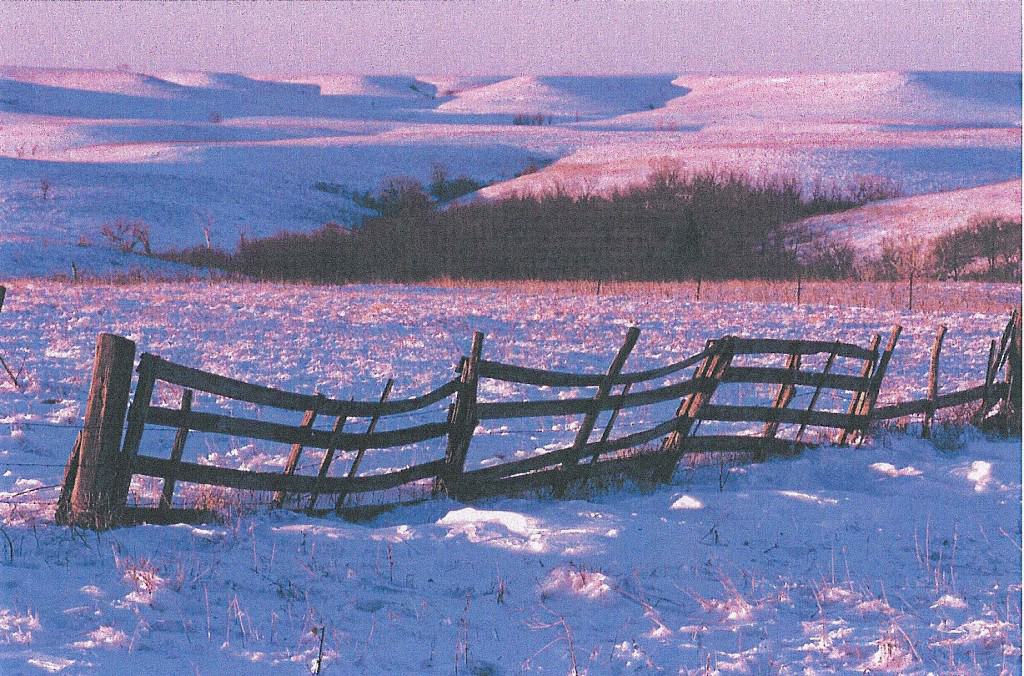
85.1 Tallgrass Prairie Winter
Flint Hills Scenic Byway
86. The Flint Hills Scenic Byway is a beautiful drive year-round showing off the panoramic vistas of the Tallgrass Prairie along 47.2 miles through the Flint Hills of Kansas on Highway K- 177 between Council Grove and Cassoday. Historic sites abounCl in the region incluCling tlie Kaw Mission and the Last Chance Store in Council Grove, and the Chase County Courthouse in Cottonwood Falls.
86.1 The following photographic exhibit is a fair and accurate representation of the Last Chance Store in Council Grove, Kansas.
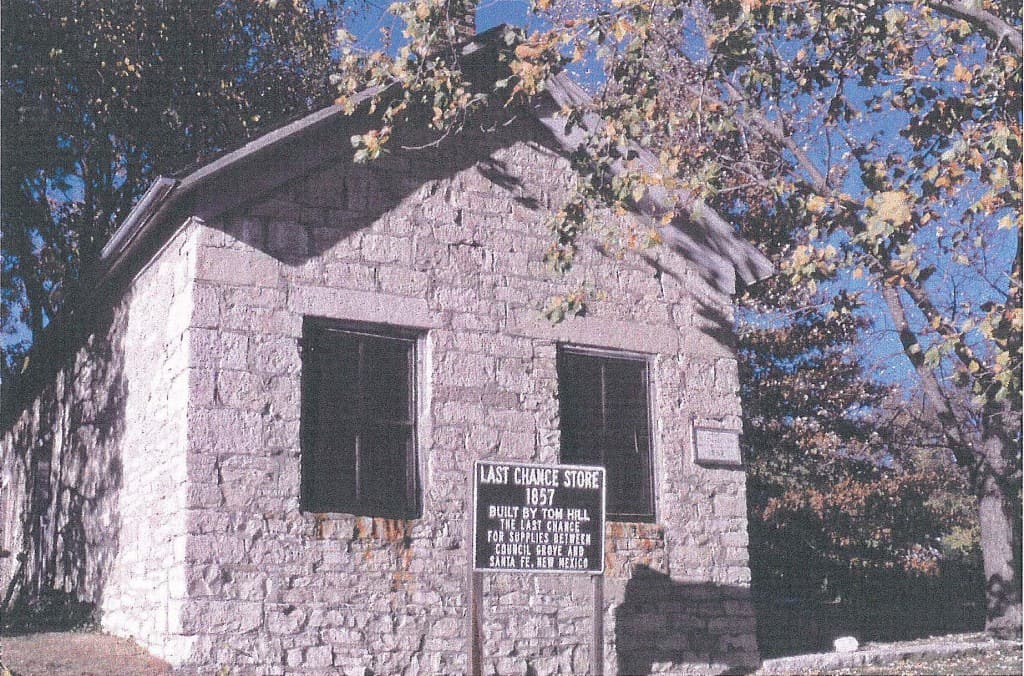
86.1 Last Chance Store
87. The Flint Hills Scenic Byway was designated a Kansas Scenic Byway on June 14, 1995 by the Kansas Secretary of Transportation.
88. The Byway passes the Tallgrass Prairie National Preserve and follows the roadway through Strong City and Cottonwood Falls, site of the Chase County Courthouse which has been in operation since 1873.
88.1 The following photographic exhibit is a fair and accurate representation of the Chase County Courthouse.

88.1 Chase County Courthouse
89. South of Cottonwood Falls, the Flint Hills Scenic Byway travels atop the hills for more panoramic views of the prairie landscapes and ranches in the area, then dips down into the creek bottomlands to follow magnificent stone walls around farmsteads still in operation.
90. The Flint Hills Scenic Byway takes the traveler deep into the heart of the Flint Hills where the sky expands and the land begins to rise and fall like waves on a sea of grass.
90.1 The following photographic exhibit is a fair and accurate representation of a Flint Hills Tallgrass Prairie Regional Ecosystem viewshed.

90.1 Flint Hills Tallgrass Prairie viewshed
91. Much of the land in an area 30–40 miles wide along the byway has remained relatively unchanged for thousands of years. The Plains Indians, such as the Kaw and Osage, made the prairie their home using pieces of chert found here for their tools and weapons. Early settlers crossed over the land, finding it too steep and rocky to farm. The Byway is a journey into the history of the American West.
91.1 The following photographic exhibit is a fair and accurate representation of the kind of rocky landscape the early settlers found as they made their way West.

91.1 Flint Hills rocky landscape
92. In 1999, Goals for the Corridor Management Plan were set forth and a primary goal of the Corridor Management Plan was to preserve the intrinsic resources of the byway by conserving the intrinsic resources of the scenic byway in a sustainable balance with economic development and tourism and develop a sense of joint stewardship by all users-visitors, property owners, and managers.
93. The Corridor Management Plan encouraged tourism and suggested developing an overlook at Schrumpf Hill, recently established by the Kansas Department of Transportation.
94. The Corridor Management Plan identified a substantial number of key resources, including scenic, historic, cultural, natural, recreational, archeological, and national register listings as well as tourist amenities such as dining, lodging, picnic areas, camping, and visitor facilities.
95. National Scenic Byway designation was considered but was not pursued in the past. The next time that an application for federal recognition may be made is 2005.
Scenic Resources
96. The Flint Hills Scenic Byway Management Committee identified the following key scenic resource elements along the existing transportation corridors of the Flint Hills Tallgrass Prairie Ecosystem.
- Rogler Ranch Stone Fences north of Matfield Green
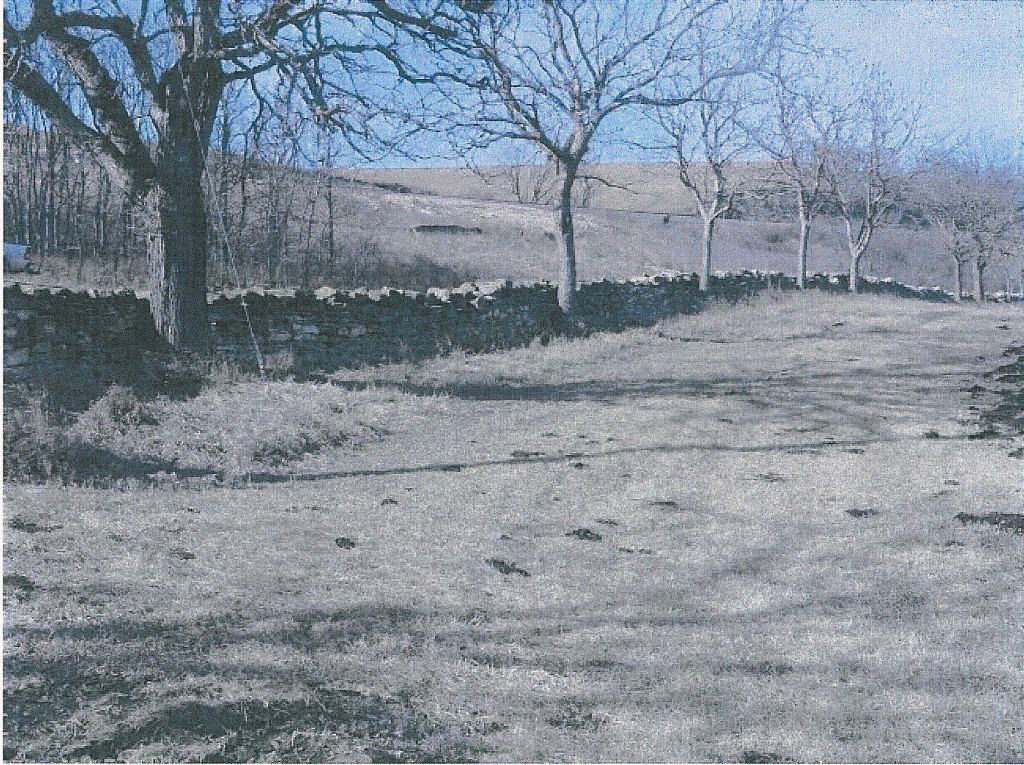
96_Rogler Ranch stone fence
- Railroad (Orient) right-of-way on east side of byway south of Matfield Green
- Schrumpf Hill 2.8 miles south of Cottonwood Falls
- Chase County Courthouse Cottonwood Falls
- eortonwood River Fatlseottonwood Falls
- Z Bar Ranch/Spring Hill Ranch/National Tallgrass Prairie Preserve north of Strong City
- River Walk Council Grove
- Madonna of the Trail Council Grove
- Kaw Indian Warrior sculpture Council Grove
- Numerous opportunities to view Flint Hills along the byway while driving
Historic Resources
97. The Flint Hills Scenic Byway Management Committee identified the following key historic resource elements along the existing transportation corridors of the Flint Hills Tallgrass Prairie Ecosystem.
- Cassoday Museum, Cassoday
- Railroad bridge over K-177 north of Cassoday
- Railroad section house north of Matfield Green
- Rogler log cabin north of Matfield Green
- Knute Rockne Memorial at Bazaar
- Bazaar cemetery at Bazaar
- Chase County Courthouse at Cottonwood Falls
- Cottonwood River Falls at Cottonwood Falls
- Roniger Native American Museum at Cottonwood Falls
- Sam Woods house (Private) – east of Cottonwood Falls
- Santa Fe Depot at Strong City
- W.B. Strong Memorial Railroad Park at Strong City
- Stone Arch Bridge over Fox Creek at Strong City
- Z Bar Ranch/Spring Hill Ranch/National Tallgrass Prairie Preserve north of Strong City
- Fox Creek School north of Strong City
- Santa Fe Trail at Council Grove
- Kaw Mission State Historic Site/Museum at Council Grove
- Old Bell Monument at Council Grove
- Farmers and Drovers Bank at Council Grove
- Council Oak at Council Grove
- Cottage House Hotel at Council Grove
- Conn Stone Store at Council Grove
- Council Grove National Bank Building at Council Grove
- Old Cowboy Jail at Council Grove – Hermit’s Cave at Council Grove
- Seth Hays Home at Council Grove
- Cemetery Wall at Council Grove
- Last Chance Store at Council Grove
- Custer’s Elm at Council Grove
- Post Office Oak and Museum at Council Grove
- Neosho River Crossing at Council Grove
- Durland Park at Sylvan Park Depot, Caboose, Buckeye Oil Engine, KATY Depot – Council Grove
- Council Grove Lake and City Reservoir
98. In addition to historic and cultural activities, Morris County is the site of twin lakes where recreational opportunities abound. The twin lakes at Council Grove include the City Reservoir and the 3,000-acre federal Council Grove Lake. Visitors can enjoy many outdoor activities including fishing, camping, swimming, and boating.
Native Stone State Scenic Byway
99. A Native Stone State Scenic Byway Plan in Shawnee and Wabunsee Counties i s being developed. The proposed scenic byway will be approximately 64 miles long and begin at exit 353 on 1–70, just west of Topeka; then follow Auburn Road (K-4) south through Dover and Eskridge where the route b ecomes (K-4/K-9 9) and proceed west. At the T-intersection where K-4 and K-99 split, the byway will go both north and southwest. The northern route will end at exit 328 at I-70 and the southwest terminus will be at the intersection of K-4 and K-177.
99.1 The following photographic exhibits are fair and accurate representation of the view from a hillside northwest of Alma looking toward an area where industrial wind turbine commercial electric power generation facilities might be located and how a few of them might look from that location.
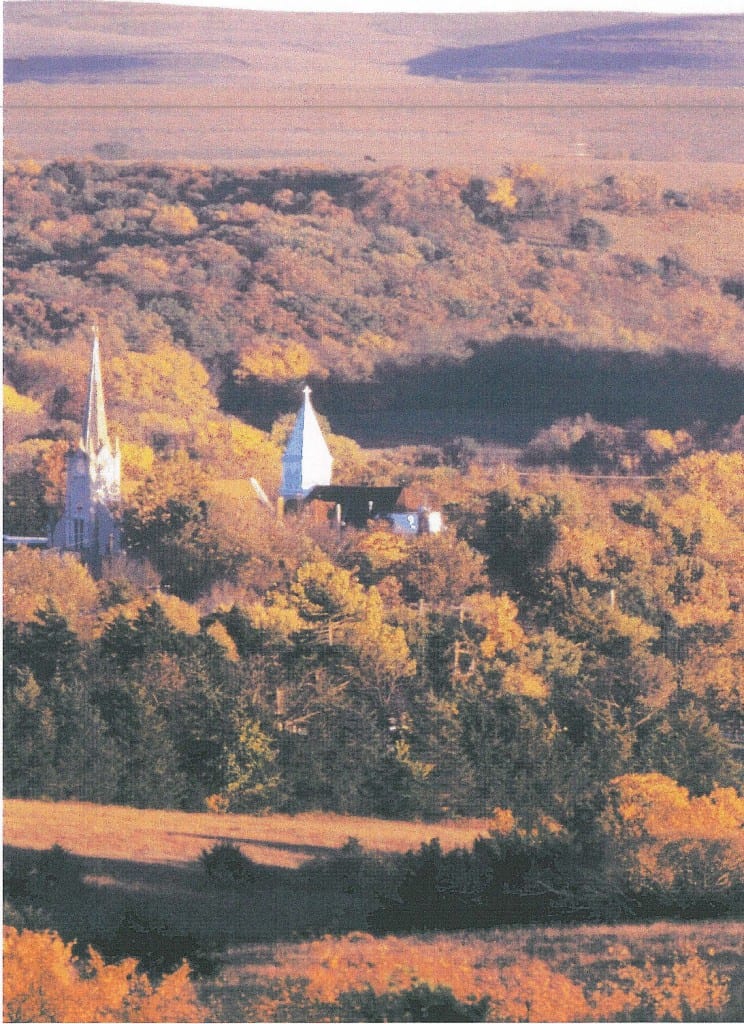
99.1 View from the Alma hillside
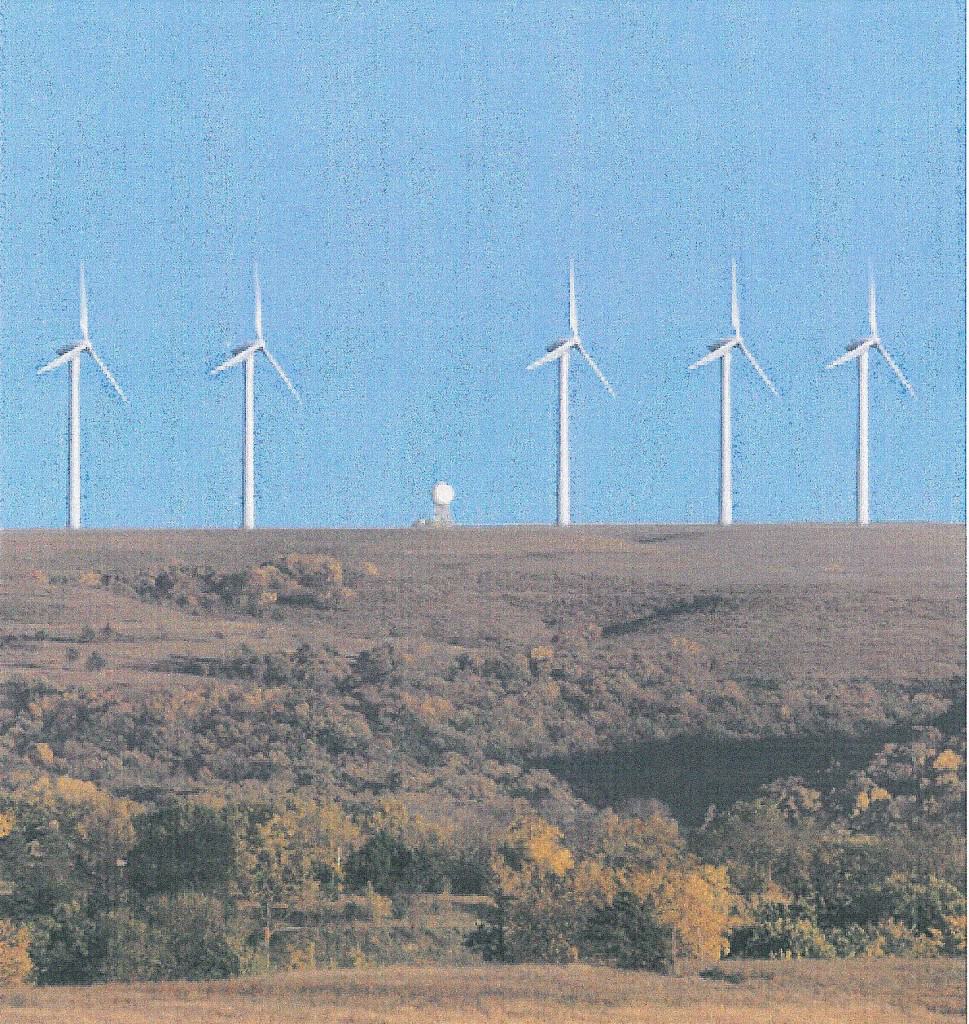
99.1 Windmills not church steeples
International recognition
100. The Flint Hills Regional Environmental System of Kansas/Oklahoma is an “important bird area” of statewide, national, hemispheric and international importance, and it deserves this designation along with two other areas in the state that have received formal international recognition as “Ramsar” sites. Those sites are Cheyenne Bottoms and Quivira National Wildlife Refuge, west of the Flint Hills. 100.1 The Convention on Wetlands, signed in Ramsar, Iran, in 1971, is an intergovernmental treaty which provides the framework for national action and international cooperation for the conservation and wise use of wetlands and their resources. There are presently 144 Contracting Parties to the Convention, with 1401 wetland sites, totaling 122.8 million hectares, designated for inclusion in the Ramsar List of Wetlands of International Importance. 100.2 “The Convention’s mission is the conservation and wise use of all wetlands through local, regional and national actions and international cooperation, as a contribution towards achieving sustainable development throughout the world”
Birds of the Flint Hills Tallgrass Prairie
101. It has been well-established through long-term monitoring that the grassland birds of North America, as a habitat-based species suite, have been undergoing steeper and more consistent population declines than any other group of birds on the continent. This measured decline over the last few decades builds on a century of population loss that accompanied nineteenth and twentieth century alteration of the Great Plains.
101.1 The following photographic exhibit is a fair and accurate representation of a Prairie Falcon, one of the raptors in serious danger from industrial wind turbine commercial electric power generation facilities and their associated transmission lines.
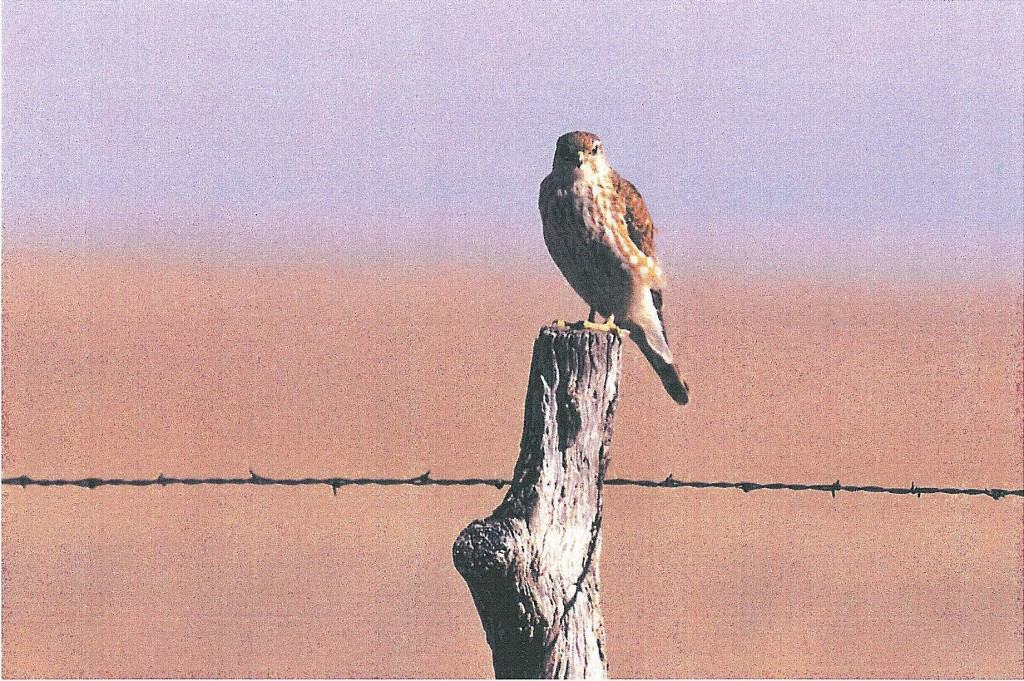
101.1 Prairie Falcon
102. Several owl species including Short-eared Owls, Long-eared Owls, Barred Owls, Great-horned Owls and Burrowing Owls, migrate across or are attracted to prey in native grasslands within the Flint Hills Tallgrass Prairie Regional Ecosystem.
102.1 The following photographic exhibit is a fair and accurate representation of a Barred Owl, one of the species of bird that will suffer serious, permanent and irreparable damage from industrial wind turbine commercial electric power generation facilities in the Flint Hills Tallgrass Prairie Regiona Ecosystem.
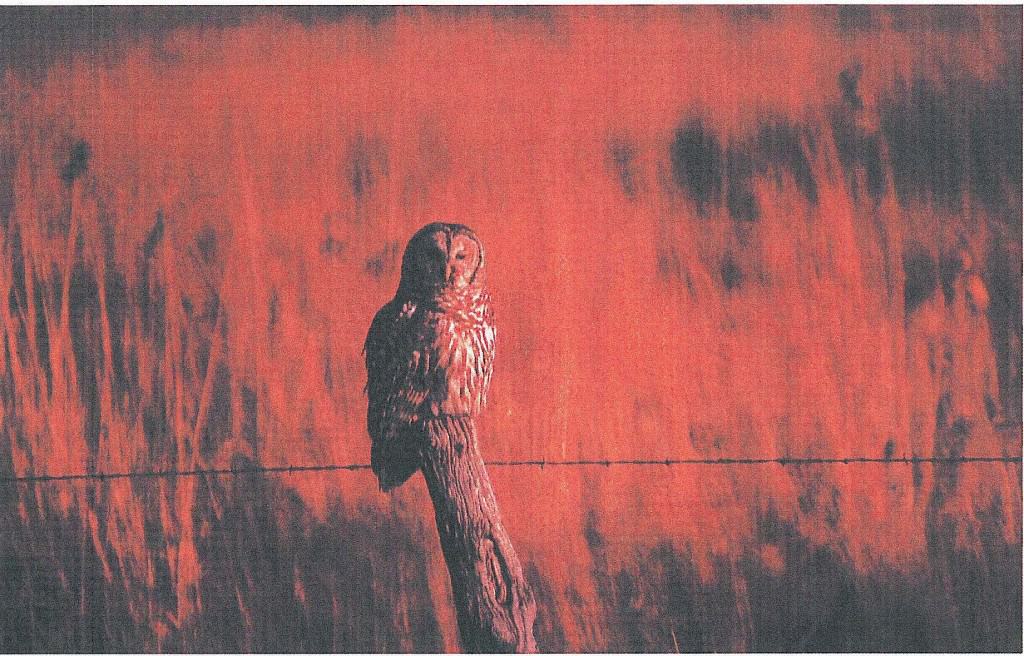
102.1 Barred Owl in the Tallgrass Prairie at sunset
102.2 The future of many species of birds depends more than anything on retention of the great healthy expanses of grassland that still remain largely in the hands of the ranching community. While cattle grazing and bird communities are by and large compatible with one another, there are only a few such large expanses of mixed or Tallgrass Prairie remaining -the Flint Hills of Kansas and Oklahoma, the Nebraska Sandhills, the Prairie Coteau in South Dakota, and the Missouri Coteau in North Dakota. These four areas are largely intact, but are surrounded by landscapes dominated by agriculture that provide little benefit to high priority birds.
103. The bird life of each of these large coupled systems of remaining mixed or Tallgrass Prairie-the Flint Hills of Kansas and Oklahoma, the Nebraska Sandhills, the Prairie Coteau in South Dakota, and the Missouri Coteau in North Dakota is distinctive, reflecting their great latitudinal breadth and the diversity of grassland systems.
103.1 Partners in Flight, the collective effort in North America to bring about the conservation of landbirds, has identified the Flint Hills as critically important for the health of the avifauna of the mid continent.
103.2 Numerous neotropical and neoarctic grassland species depend upon the Flint Hills for nesting and/or as a spring and fall migratory habitat corridor, and/or as a wintering area.
103.3 The Flint Hills is the last north-south corridor of Tallgrass Prairie remaining in the Central Great Plains. In addition to the habitat provided at ground level, the winds and updrafts associated with these hills are undoubtedly another reason this is an important migratory corridor for birds. 104. Soaring birds such as hawks, eagles and vultures, are among the birds that are most evident in their daytime use of these winds and thermals associated with landscape features. The Flint Hills Tallgrass Prairie Regional Ecosystem hosts high winter and migratory populations of bald eagles and several species of hawks. Red-tailed hawks are resident nesters and the area has an exceptionally high summer population of Turkey Vultures.
104.1 The following photographic exhibit is a fair and accurate representation of a Red-tailed Hawk, one of the native raptors of the Flint Hills Tallgrass Prairie Regional Ecosystem.
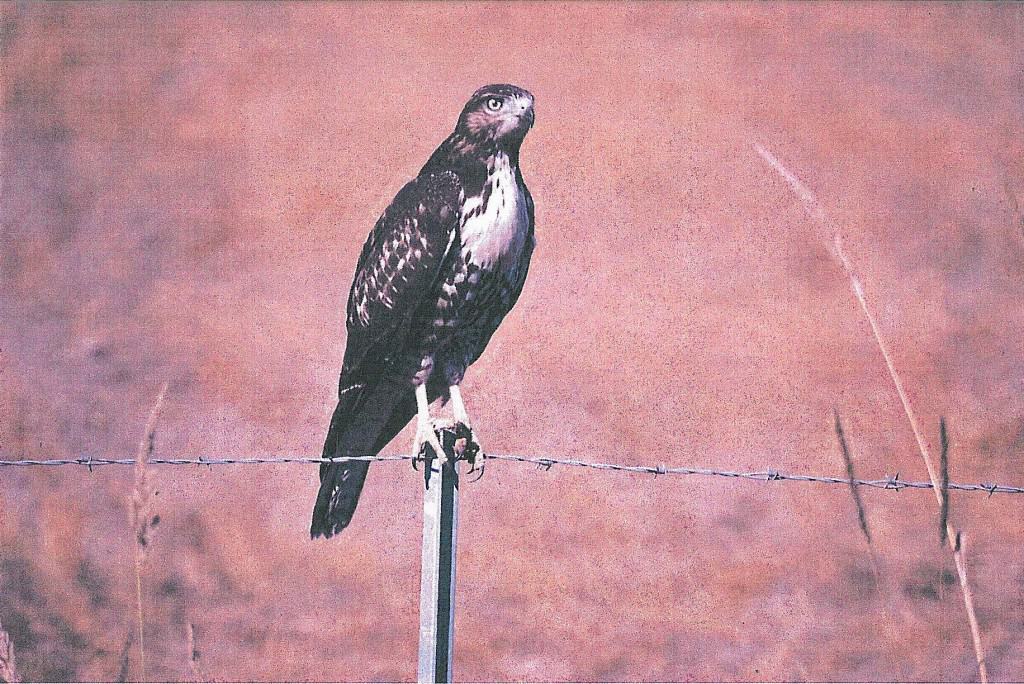
104.1 Red-tailed Hawk
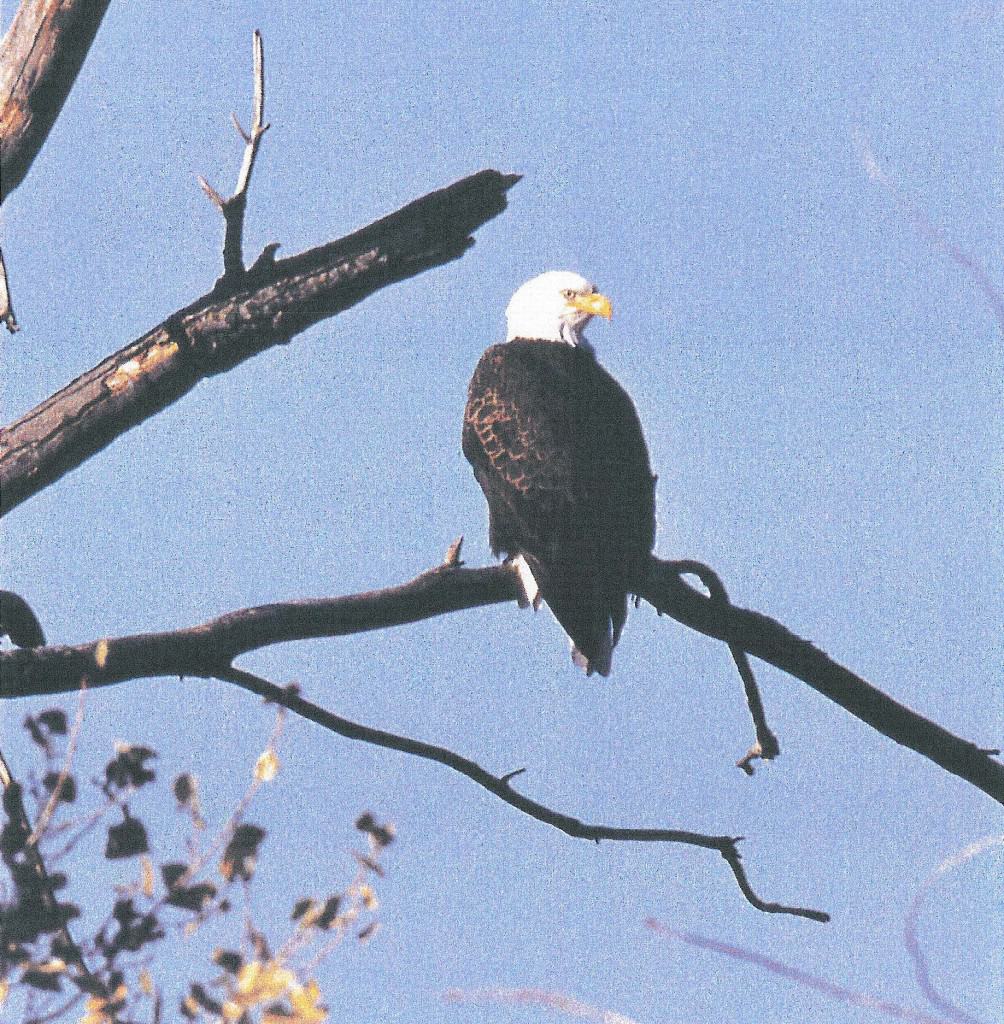
104.2 Bald Eagle
104.2 The preceding photographic exhibit is a fair and accurate representation of a Bald Eagle, another native majestic soaring bird indigenous to the Flint Hills Tallgrass Prairie Regional Ecosystem. Bald Eagles occur in greatest numbers throughout the Flint Hills Tallgrass Prairie Regional Ecosystem during the winter months when they hunt for prey and carrion above the tallgrass prairie. 104.3 The following photographic exhibit is a fair and accurate representation of Turkey Vultures which are critical elements of the Flint Hills Tallgrass Prairie Regional Environmental System.
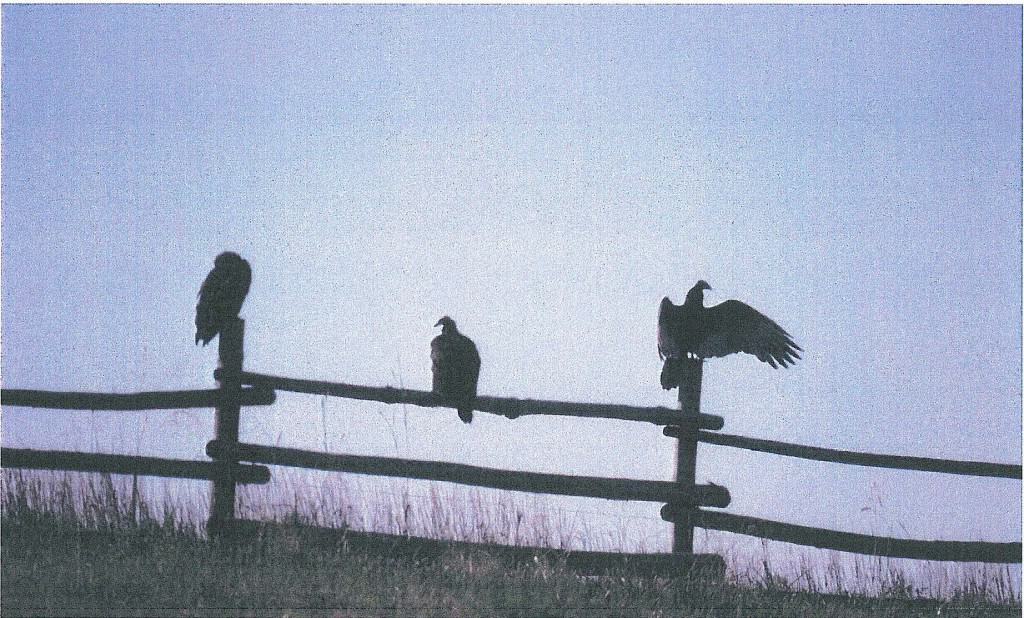
104.2 Turkey Vultures waiting…
105. The Flint Hills have the most extensive Tallgrass Prairie habitat remaining for Greater Prairie-chickens, Upland Sandpipers and a number of other grassland birds. It is a migratory route for American Golden Plovers and numerous other species. It has been a primary migratory corridor for the endangered Eskimo Curlew. Upland Sandpipers can be heard migrating at night over the Flint Hills in late summer.
105.1 The following photographic exhibit is a fair and accurate representation of an Upland Sandpiper indigenous to the Flint Hills Tallgrass Prairie Regional Ecosystem.

105.1 Upland Sandpiper
106. All Prairie-chicken species and subspecies are imperiled throughout most of their historic range. Greater Prairie-chickens have been extirpated from most of their historical range, and are at or close to endangered status in most states. The endangered Atwater’s Prairie-chicken has been pushed to the brink of extinction by industrialization and land use changes in its Texas habitat. Destruction by conversion to other land uses, degradation and fragmentation of habitat are the driving forces toward population declines. Lesser Prairie-chickens have been designated as a “candidate species” for designation as a threatened species by the United States Fish & Wildlife Service.
106.1 The following photographic exhibit is a fair and accurate representation of a male Greater Prairie Chicken, just one of the species of indigenous birds and animals that will suffer serious, permanent and irreparable damage as a result of the construction, operation and maintenance of industrial wind turbine commercial electric power generation facilities in the Flint Hills Tallgrass Prairie Regional Ecosystem.

106.1 male Greater Prairie Chicken
107. Although a small flock of Prairie-chickens may survive on a few thousand acres, one prominent Kansas Prairie-chicken research biologist has suggested that it takes something upward of a township to support a viable population and maintain the necessary genetic pool needed for long term survival.
107.1 Greater Prairie-chickens are sensitive to human disturbance just like all other prairie grouse. Tallgrass Prairie within a quarter-mile of a house is seldom used, as are areas near high-voltage powerlines and roads with heavy traffic. Thus, even though rural residences, high voltage lines and roads are not actually destroying much Tallgrass habitat, they are making areas uninhabitable for these birds.
107.2 Construction of a municipal water tower northwest of Manhattan, Kansas on a site that was historically used by Prairie-chickens as a lek has resulted in abandonment of the site. Now an electrical substation is planned for construction by Western Resources on adjacent land, and additional powerlines may soon be strung across a landscape that has previously been maintained as a natural prairie landscape. It is questionable whether other secure lek sites remain in the grassland complex that once supported this population of Prairie-chickens. Combined with other encroachments, it is likely that this population will vanish from the surrounding prairie landscape that was once thought to be secure with Kansas State University stewardship of the Donaldson Pastures serving as the centerpiece of the habitat.
107.3 In addition to the need for blocks of prairie habitat, it is important to protect at least three critical elements of habitat: nesting and brood rearing habitats, and communal courtship lek sites. Most of the prime lek sites in hilly terrain are on ridges and tablelands and the United States Fish & Wildlife Service has recommended that industrial wind turbine commercial electric power generation facilities should be sited at least five miles from established prairie grouse leks.
Tourism
108. The Flint Hills Tallgrass Prairie Ecosystem encompasses an area about the size of Vermont. As the residents of Vermont take great pride in the natural and cultural beauty of their state, and that pride is prominently featured in virtually every publication that residents distribute to promote the state, so Kansans take equal pride in the scenic, natural and cultural values of the Flint Hills.
108.1 The following photographic exhibit is a fair and accurate representation of tourists observing the natural beauty of the area on Nordstrom Hill in the Flint Hills Tallgrass Prairie Regional Ecosystem.

108.1_tourists
109. In the Flint Hills the native grassland ridges and hills are complemented by gallery forests, historical ranchsteads, farms and communities. With the dramatic increase in nature-based and history-based tourism, these scenic hills are a resource of great economic value. Many residents who have invested in this land with the hope the vistas will always be there for all to enjoy. The establishment of the Prairie Parkway in the 1960s by the Kansas Legislature, and recent establishment of the Flint Hills Scenic Byway demonstrate statewide and community appreciation.
109.1 National recognition of Kansas spectacular prairie landscapes is not yet as well established as that of the forested mountains of Vermont, the Everglades and similar areas. Appreciation for the native prairies in the Flint Hills is dramatically increasing throughout the country and beyond. With the recent establishment of the Tallgrass Prairie National Preserve as a unit of the National Park Service preservation system, the PBS Special, and research at Kansas State University/Konza Prairie, international recognition of this unique national and international natural resource treasure is quickly growing.
110. The Flint Hills Tallgrass Prairie Region should be developed and promoted to serve as an icon destination for Kansas. An icon epitomizes a specific habitat, and offers the public the opportunity to experience nature in its most authentic and unaltered form. An icon embodies the characteristics of the respective habitat, symbolizing nature in its most unadulterated or unmodified state. An icon transports the visitor back in time, offering a glimpse of the natural world as it once was.
110.1 The following photographic exhibit is a fair and accurate representation of Butcher Falls which offers a glimpse of the the natural world as it can still be in the Flint Hills Tallgrass Prairie Regional Ecosystem.
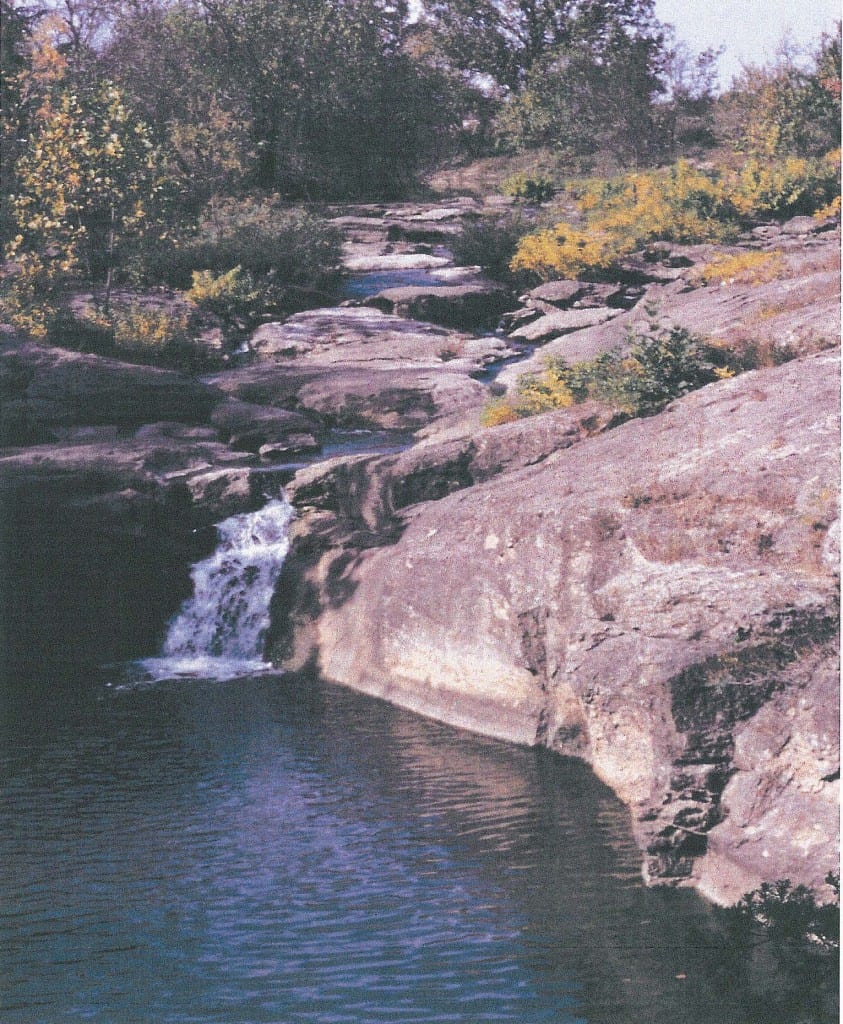 111. The opportunities for Kansas to enter the experiential tourism market are limited. Much of the Great Plains has been converted to commodity agriculture, and natural landscapes such as the Flint Hills are limited and discrete.
111. The opportunities for Kansas to enter the experiential tourism market are limited. Much of the Great Plains has been converted to commodity agriculture, and natural landscapes such as the Flint Hills are limited and discrete.
111.1 The following photographic exhibit is a fair and accurate representation of recreational riders and working ranch cowboys enjoying the Tallgrass Prairie viewshed. Agritourism and nature based experiential opportunities are appealing to a broadly diverse population of travelers.
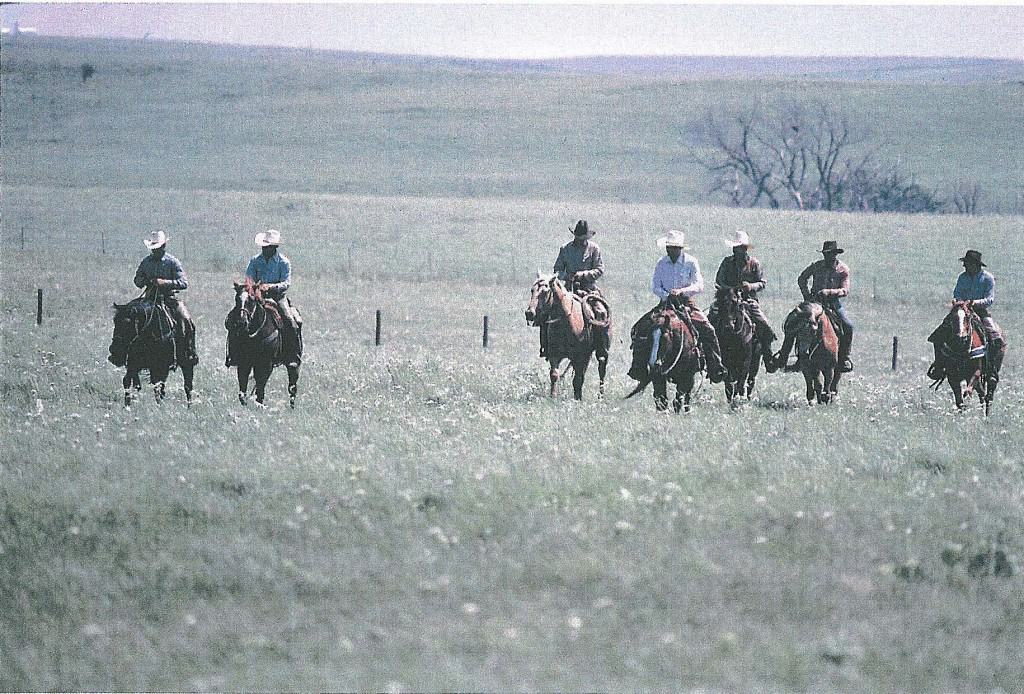
111.1 Recreatonal riders on a working ranch
112. The Flint Hills and Cheyenne Bottoms including the Quivira National Wildlife Refuge are among the few destinations in Kansas that will attract nature tourists to Kansas from throughout the nation and the world.
113. The promise of nature tourism in the Flint Hills is more potent today than when originally voiced.
113.1 The ever-changing demographic landscape in the United States has been dominated by the decades-long flood of rural residents into a relative handful of cities. Many of these urbanites, isolated from the natural and cultural resources that are still contained in rural America, are vacationing out of the cities in an effort to reconnect with their roots and those of their families.
114. Experiential travel is among the most significant travel sectors in the United States and one that continues to prodigiously expand. As such, it represents a significant economic driver for rural communities. Experiential tourism is contributing to the economic vitality of rural America and it does indeed “work for America.”
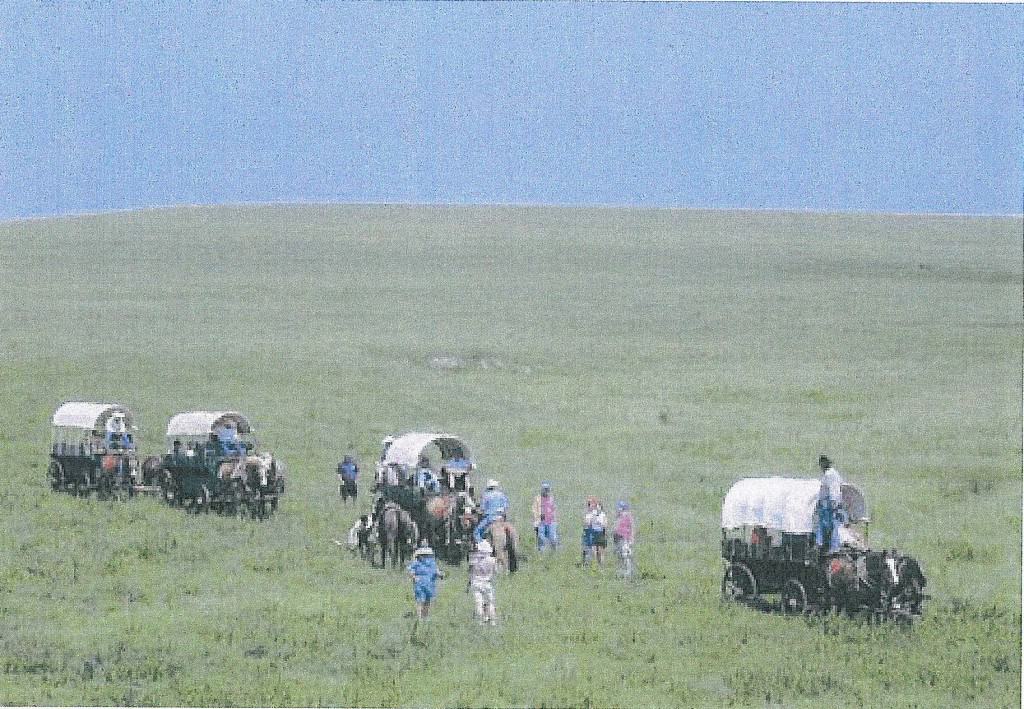
114.1 Nineteenth Century Wagon Train
114.1 The preceding photographic exhibit is a fair and accurate representation of a Nineteenth Century Wagon Train, an experiential activity which, in the Flint Hills Tallgrass Prairie Regional Ecosystem, brings the visitor a deeper understanding of the Pioneer spirit that built our nation.
114.2 In 1999 a class of consumers was defined who favor the consumption of experiences over traditional goods and services. They buy experiences to spend time enjoying memorable events that are personally engaging. Experiences are a distinct economic offering that occur when “a company intentionally uses services as the stage and goods as the props to engage an individual.”
114.3 According to the Travel Industry Association of America (TIA), “81% of U.S. adults who traveled in the past year, or 118 million, are considered historic/cultural travelers …for 30% of historic/cultural travelers, their destination choice was influenced by a specific historic or cultural event or activity.”
114.4 Outdoor recreation and/or visiting national or state parks are also one of the top activities for U.S. travelers taking leisure trips within the United States. One in four (27%) of these leisure trips includes some form of outdoor recreation and/or a visit to a national or state park.
115. The Flint Hills Regional Ecosystem provides one of the primary opportunities for the State of Kansas to develop experiential tourism, particularly eco-tourism, nature tourism, and agri-tourism.
116. Protecting the amenities of the Flint Hills Regional Ecosystem permits Kansas to capitalize on its unique national natural resource treasures which represent distinctive national and international differentiation opportunities for Kansas.
117. Nature tourism encompasses a broad range of travel interests and activities that elevate and enhance the individual experiences of the traveler. These interests are disparate, and bound together solely by the shared goal of each traveler to expand personal horizons. Personal enrichment, enlightenment, inspiration and engagement are among the primary motivators for these travelers. All of these motivators drive visitors to natural sites and protected areas. Relaxation and stress reduction are also important aims, but they are achieved indirectly through the experiences from the primary travel motivations.
117.1 Nature travel is estimated to be increasing at an annual rate between 10 percent and 30 percent. Between 40 percent and 60 percent of international visitors travel to enjoy and appreciate nature. More specifically, wildlife-associated recreation, as opposed to outdoor recreation in general, now involves millions of Americans in hunting, fishing, and a variety of non-consumptive activities such as birding, wildlife watching and nature photography.
117.2 The primary motivations of nature tourists are to enjoy sights, smells, sounds of nature; be outdoors; see wildlife species and behavior not seen before; get away from the demands of daily life at home and work; and enjoy family recreation.
117.3 Improved health, longer lifespans, retiring Baby Boomers, and a wealthier traveling public all support past trends that indicate growth rates in nature-based tourism activities of at least 10 percent annually and strongly favor a further increase in nature-based tourism .. Growth in wildlife watching has increased annually at rates far in excess of this.
117.4 Americans planning summer vacations will be staying closer to home and visiting destinations reachable by car. In addition to proximity, many travelers are looking for vacations that offer relaxation and a sense of escape to nature where outdoor activities including hiking, horseback riding and camping are available.
118. Destination brand building is all about developing a rich, relevant brand personality. The position of the Flint Hills Region as the icon for the Great Plains and as a land of both healthy natural resources and beauty will translate into the rational benefit of encountering history, heritage, and folklore. At the emotional level, visitors will experience awe of the elements and be rejuvenated by the experience.
Beneficial Impacts of Tourism Development
119. In addition to the traditional economic impacts from tourism-direct, indirect, and induced-ecologically and culturally sensitive tourism development can benefit the environmental health of a region.
119.1 The following photographic exhibit is a fair and accurate representation of some of the Native American tradition of the region.

119.1_Native Americans
120. Tourism, economic development, and conservation efforts can work in concert as tourism revenues allow communities to invest in green spaces, hike-and-bike trails, interpretative centers, and a variety of amenities that are enjoyed by travelers and residents alike.
121. Experiential tourism development in Flint Hills communities will directly lead to an enhanced quality of life in the region. Amenities demanded by tourists also benefit residents and represent an amenity base upon which future economic development efforts may be constructed.
121.1 The following photographic exhibit is a fair and accurate representation of guests at a working ranch.
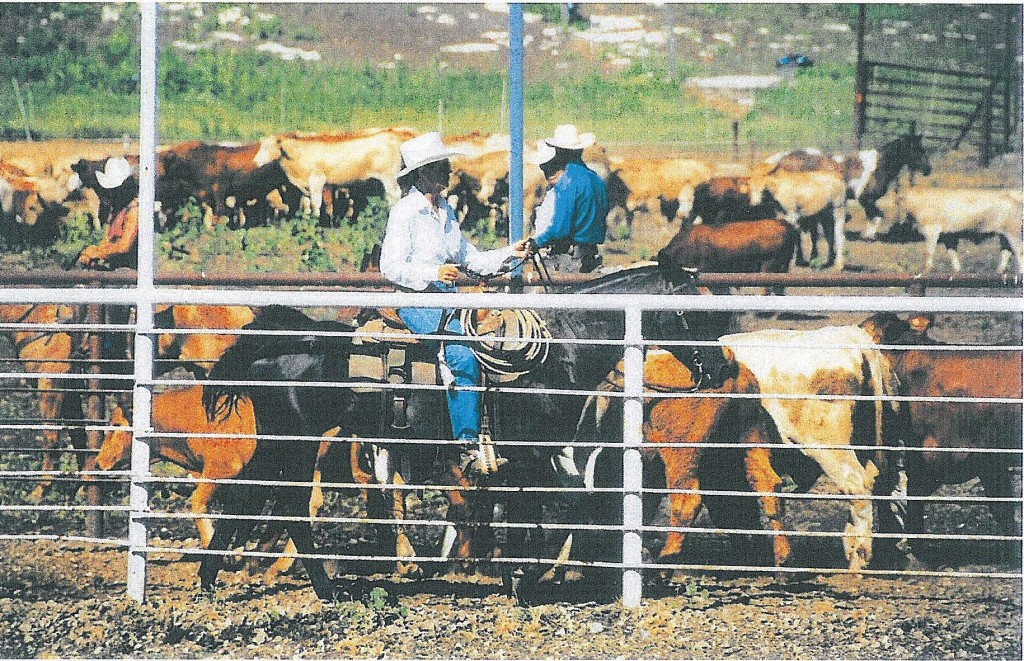
122.1 Guests at a working ranch
122. According to the most recent U.S. Census data, about 26.9 million people live in the urban and suburban areas of major metropolitan areas within a day’s drive (8 hours) of the Flint Hills.
Economic Impacts of Tourism
123. Experiential tourism will allow communities in the Flint Hills to utilize existing resources, nature, culture, and history, to attract additional travelers. Nature tourism demonstrates exceptional adaptability to most economic cycles. During booms, international and long-haul markets can be targeted, and during recessions the focus can be geared down to regional, auto-travel.
124. Birding and other nature tourism development and promotion in other parts of the country have helped to make significant economic contributions to local communities. Bird watchers spent $7.4 billion nationwide in 2001 for food, lodging, transportation and other trip related expenses; and another $24.3 billion for wildlife watching equipment and other expenses according to the United States Fish & Wildlife Service.
125. According to Wilkerson (2003), “Given its historical performance as a luxury good during expansions and a necessity during recessions, travel and tourism’s future economic prospects look quite bright.” Traditional economic impacts from tourism are many, including the direct impact of visitor spending; the indirect changes in sales, income, or jobs in regional sectors that supply goods and services to the recreation/tourism industries; and the induced impact of increased sales within the region from the household spending of the income earned in the tourism and supporting sectors.
125.1 The Byway economic impact study estimated 1,025 visitor groups with an average size of 4.4 people visited the Tallgrass Prairie National Preserve during August 1998. This was further extrapolated to 41,000 individuals per year who tour the Byway.
125.2 Based upon the Byway economic impact study, it is conservatively estimated that each visitor group to the Flint Hills Tallgrass Prairie Region spent approximately $50/day/person on their trip. Using the 1994 statewide travel expenditure figure of $60/day/person and an annual regional visitation estimate of 41,000 people per year, the current direct expenditures by visitors to the region can be estimated at about $2.8 million adjusted for inflation over ten years annually.
125.3 In 2001, domestic travelers spent about $3.5 billion in Kansas. Nearly 55,000 jobs, with $872.8 million in wages and salaries, were supported by domestic travel spending in Kansas during 2001. Travel-generated jobs comprised 4.1% of the-total nonfarm employment in Kansas. Domestic travel spending in Kansas also generated $546.1 million in tax revenue for federal, state and local governments in 2001.
The Blue Ridge Parkway Experience
126. The Blue Ridge Parkway is a linear national park extending 469 miles from Shenandoah National Park in Virginia to Great Smoky Mountains National Park in North Carolina. The park is a scenic motor road designed by landscape architects to enable visitors to enjoy the scenic beauty of the region from their vehicles. Research indicates that the primary reason most visitors make a trip to the Parkway is to enjoy the views.
126.1 The Blue Ridge Parkway Scenic Experience Project was conducted in the summer and fall of 2002 as a collaborative project between the National Park Service, two universities, and an independent consultant. The study was designed to determine the benefits of the scenic experience and how change in the scenic quality would affect visitation; how much visitors would pay to preserve scenic quality; and how much they would pay to improve it. According to the National Park Service, in dollar terms, the scenic views along the Parkway in North Carolina are worth upwards of $5 billion a year to the visitors who enjoy them. 126.2 In 2002, more than 21.6 million recreation visits were made to the Blue Ridge Parkway making it the most visited national park unit in the United States.
Wind turbines = serious, permanent damage
127. Upon information and belief, since the renewal of certain tax advantages and subsidies for wind energy speculators and their “Wind Industry,” a number of industrial wind turbine commercial electric power generation facilities have been proposed to be located throughout the Flint Hills Tallgrass Prairie Regional Ecosystem as can be seen from the following graphic exhibit.
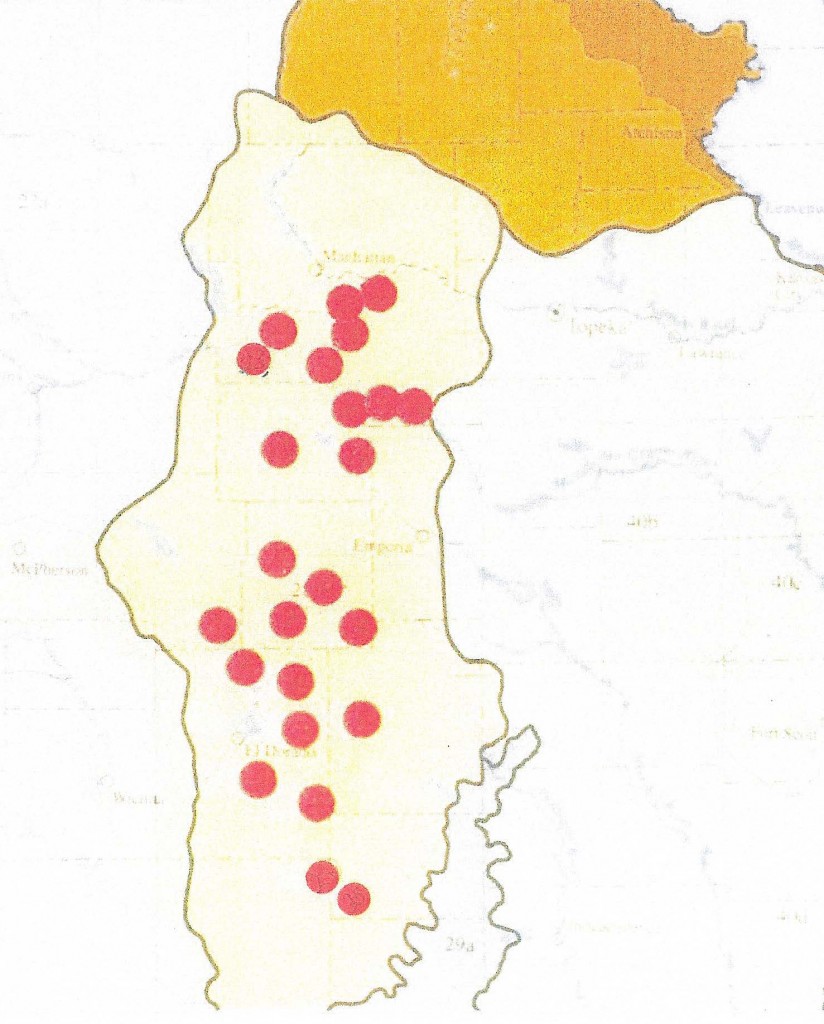
Proposed Flint Hills Wind Turbines
129. Upon information and belief, Greenlight Energy admits that significant development of industrial wind turbine commercial electric power generation facilities in the Flint Hills Tallgrass Prairie Regional Ecosystem will cause serious permanent and irreparable damage.
130. The industrial wind turbine commercial electric power generation facilities proposed by the corporate Defendant wind energy speculators will cause serious, permanent and irreparable damage to the unique national and international resource treasure that is the Flint Hills Tallgrass Prairie Regional Ecosystem by becoming an irreconcilable environmental system determinant irrevocably committing the entire Regional Environmental System and all its myriad elements, processes and systems to a future dominated by industrial wind turbine towers where once there was a sea of grass over which magnificent birds soared.
130.1 The following photographic exhibit is a fair and accurate representation of the scene of large scale industrial wind turbine commercial electric power generation facilities in Germany and the public reaction to those facilities.
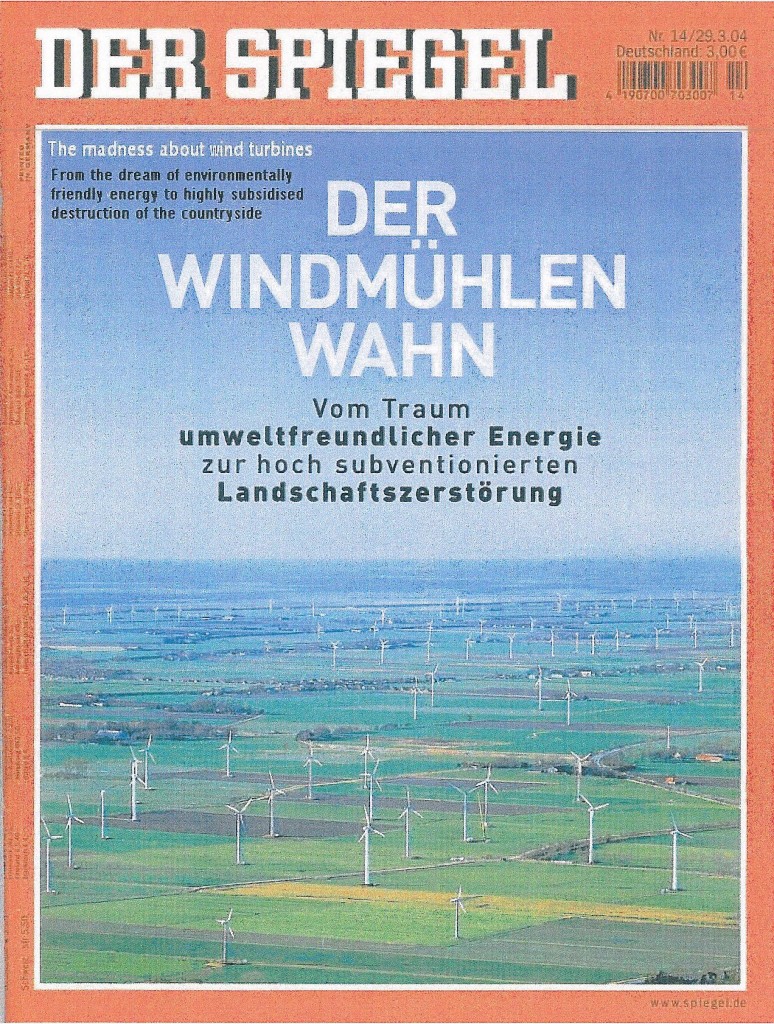
Der Spiegel
Killing Birds
131. Upon information and belief, Greenlight Energy admits that significant bird collision problems have occurred with existing wind turbine generators, particularly at flyway sites such as Altamont Pass in California.
132. Upon information and belief, Greenlight Energy admits that responsible wind development should avoid certain migratory bird routes or dense avian habitats, but insists on siting a number of large scale industrial wind turbine commercial electric power generation facilities in some of the most ecologically sensitive areas of the Flint Hills Tallgrass Prairie Regional Ecosystem.
133. Soaring birds such as hawks, eagles and vultures, and other birds that migrate at night within two to four hundred feet of the ground are vulnerable to kills from collisions with the turbine blades, or from flying into the gigantic turbine towers. Certain weather conditions and events may dramatically increase the occurrence of bird strikes and may result in massive bird kills. 133.1 The following photographic exhibit is a fair and accurate representation of the relatively low industrial wind turbines located at Altamont Pass in California near San Francisco.
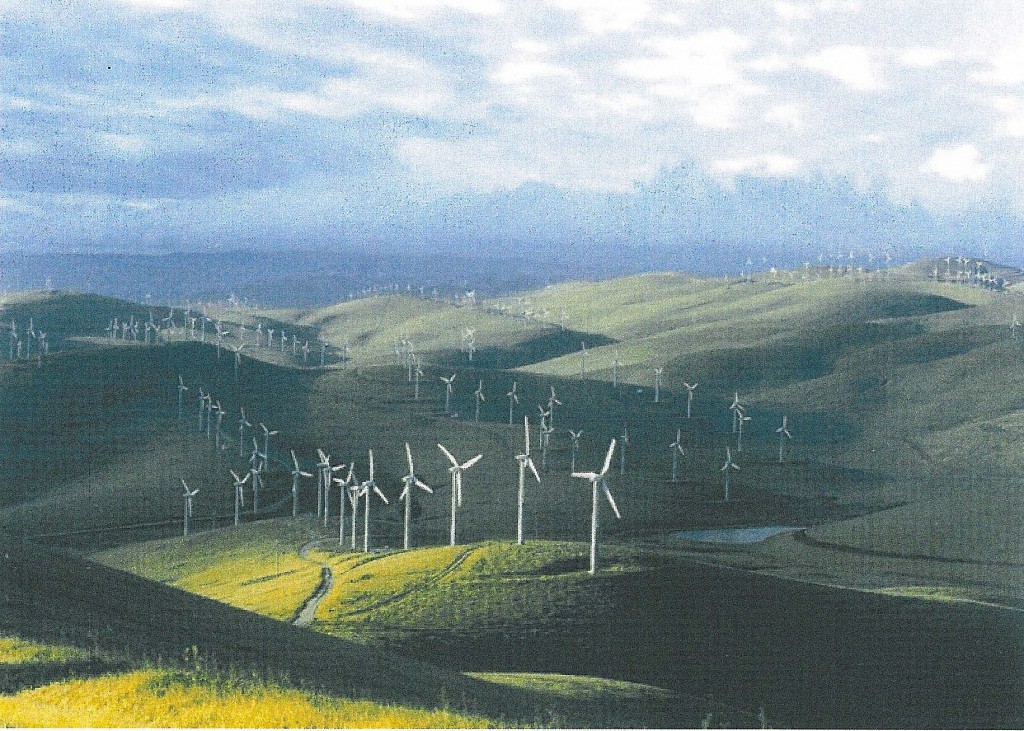
Wind turbines at Altamont Pass
134. Industrial wind turbine commercial electric power generation facilities should avoid locations where there is a large prey base for raptors such as the Flint Hills Tallgrass Prairie Regional Ecosystem where wintering and migratory populations of raptors are attracted to the native grasslands because of the availability of prey and the topography.
135. Construction, operation and maintenance of industrial wind turbine commercial electric power generation facilities in the Flint Hills Tallgrass Prairie Regional Ecosystem with scores of industrial turbines installed at a height of 350 feet or greater will create a killing zone for local and migrating birds of such size and duration that serious, permanent and irreparable damage will be done to species whose future is already threatened.
135.1 The following photographic exhibit is a fair and accurate representation of the kill zone associated with the relatively low industrial wind turbines located at Altamont Pass in California near San Francisco.
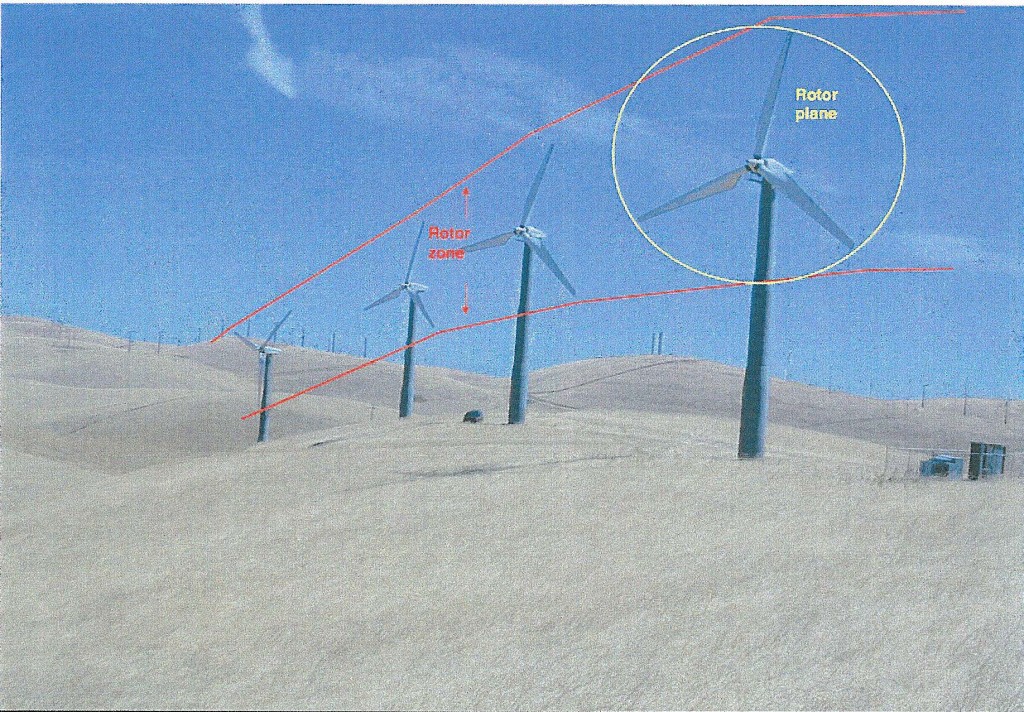
Altamont Pass Raptor Kill Zone
136. The Turkey Vulture which is one of the most visible large soaring birds gracing the sky over the prairie hills of Kansas from mid March thru October will suffer serious, permanent and irreparable damage from the industrial wind turbine commercial electric power generation facilities proposed for the Flint Hills Tallgrass Prairie Regional Ecosystem as they take advantage of the updrafts over the hills and glide back and forth over the ridges and out over the plateaus usually from 50 to several hundred feet over the ground.
137. Locating industrial wind turbine commercial electric power generation facilities in the Flint Hills Tallgrass Prairie Ecosystem will cause serious, permanent and irreparable damage to migratory and resident breeding populations of Turkey Vultures, Red-tailed Hawks, American Kestrals, Rough-legged Hawks, Peregrine Falcons, Prairie Falcons, Northern Harrriers, Short-eared Owls and Loggerhead Shrikes as they search the grasslands for food and are attracted to the other dead birds, bats and insects, including dragonflies, buttereflies and moths that have been killed by the turbine blades.
137.1 The following photographic exhibit is a fair and accurate representation of a Golden Eagle killed by the relatively low industrial wind turbine commercial electric power generation facility at Altamont Pass.
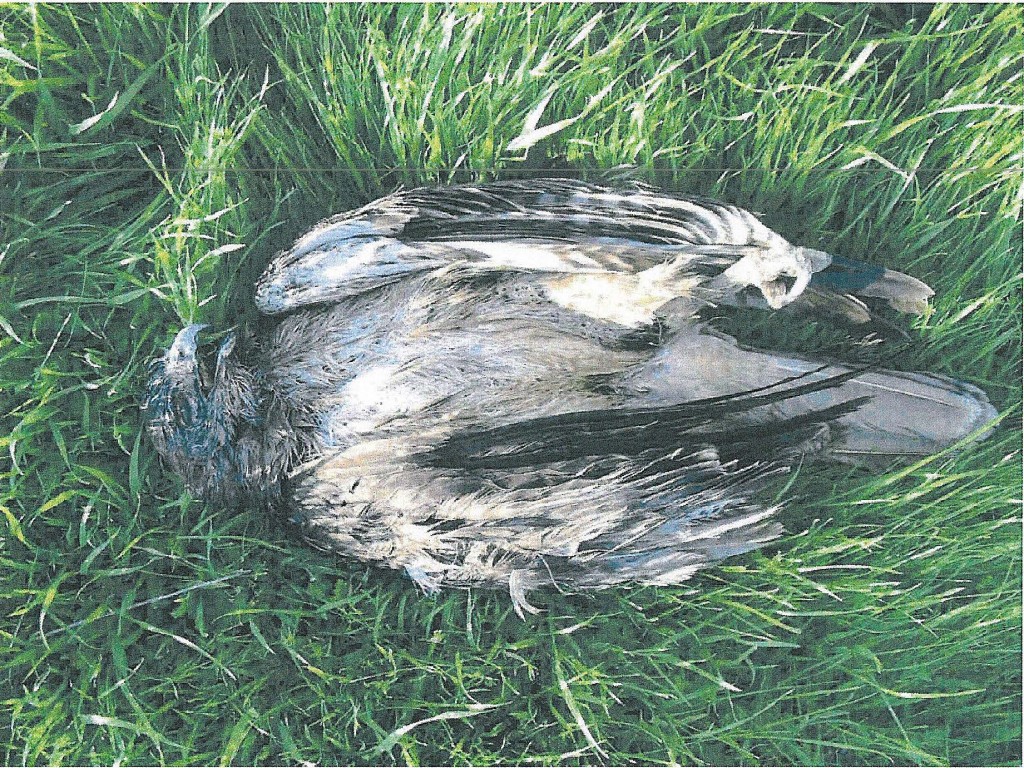
Golden Eagle Killed by Altamont Pass wind turbines
137.2 The following photographic exhibit is a fair and accurate representation of an American Kestral killed by the relatively low industrial wind turbine commercial electric power generation facility at Altamont Pass.
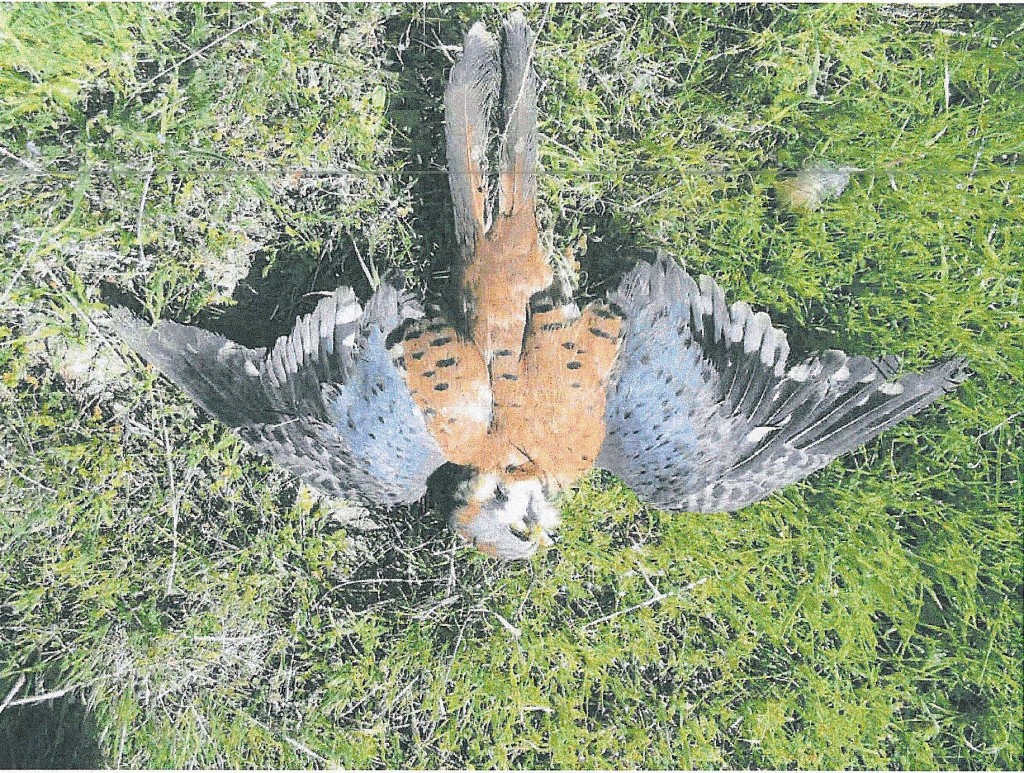
American Kestrel killed by Altamont Pass wind turbines
137.3 The following photographic exhibit is a fair and accurate representation of some body parts of a bird on the ground after an encounter with the relatively low industrial wind turbine commercial electric power generation facility at Altamont Pass.
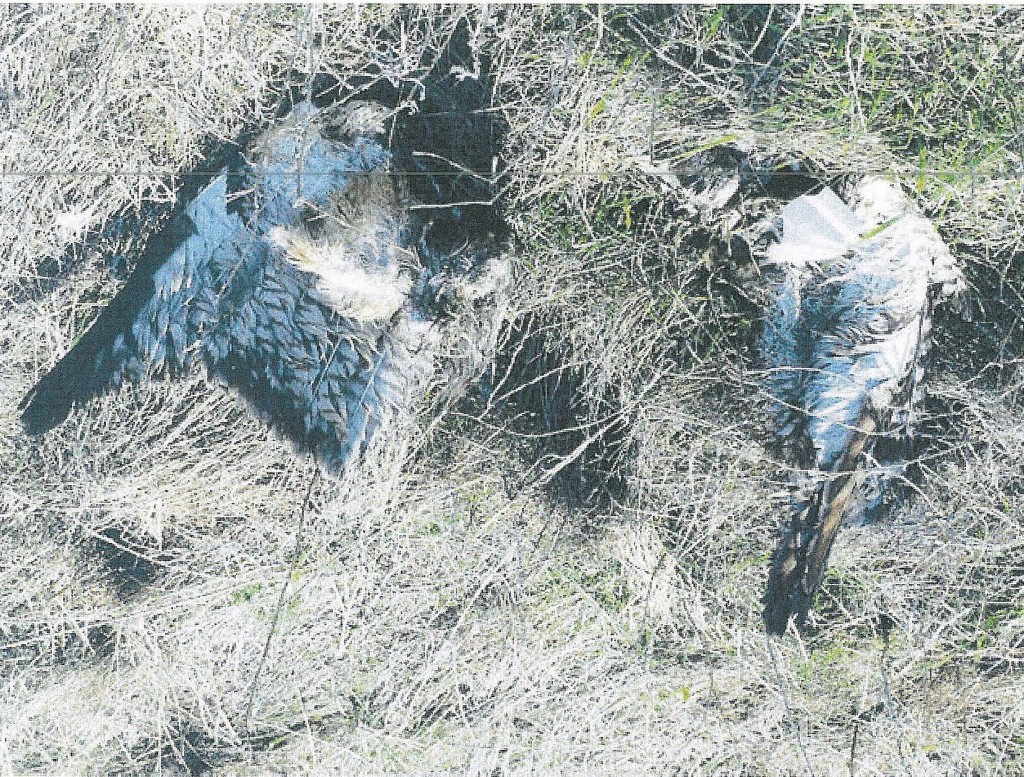
Raptor body parts from Altamont wind turbines
137.4 The following photographic exhibit is a fair and accurate representation of a hawk killed by the relatively low industrial wind turbine commercial electric power generation facility at Altamont Pass.
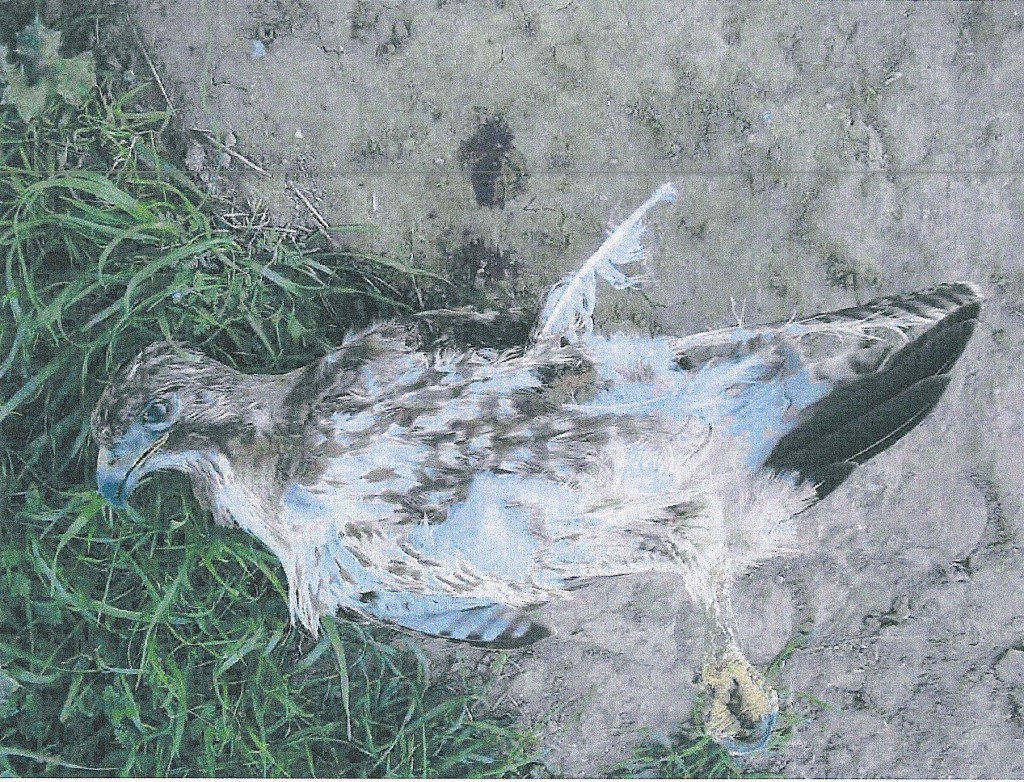
Hawk killed by Altamont wind turbines
Destruction of Habitat
138. “Industrialization” of the Flint Hills by industrial wind turbine commercial electric power generation facilities with extensive networks of gigantic wind turbines, service roads and high voltage transmission power lines as well as the security fences required now as an element of homeland security, together with the strobe or other lights needed to alert aircraft to the danger, the overhead movement and noise of the gigantic propeller blades and the associated distribution of those sounds through the earth, will fragment the Flint Hills Tallgrass Prairie Regional Ecosystem and endanger the entire Regional Environmental System of which the Flint Hills Tallgrass Prairie Regional Ecosystem is a vital element.
139. The construction activities associated with development of industrial wind turbine commercial electric power generation facilities cause serious, permanent and irreparable damage to the region in which they take place.
139.1 The following photographic exhibit is a fair and accurate representation of construction activities associated with development of a ridgeline industrial wind turbine commercial electric power generation facilities in West Virginia.
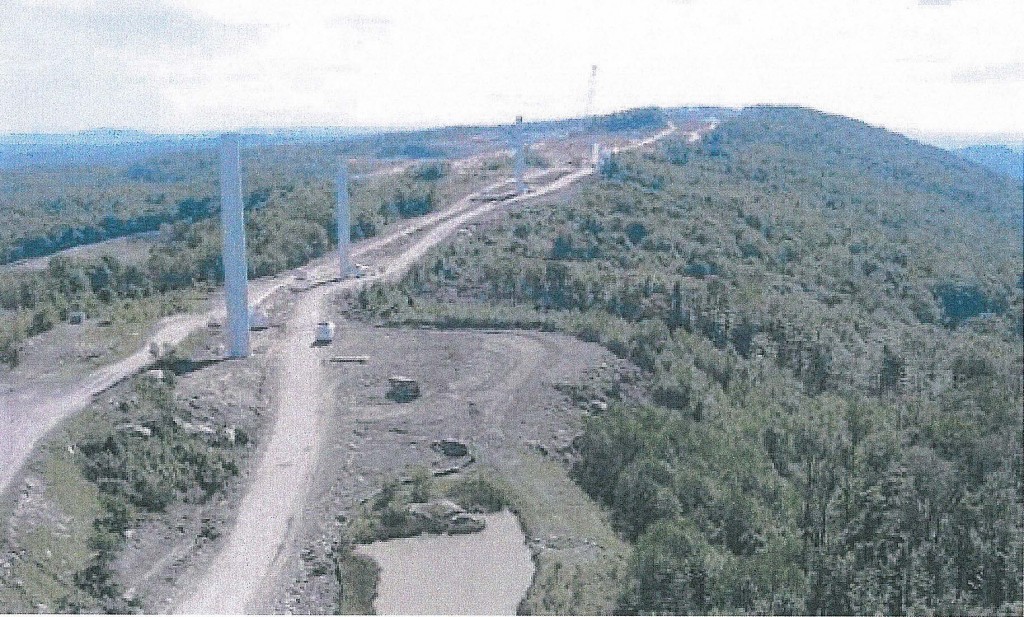
Wind turbine construction

Commercial wind turbines, Woodward, OK
139.2 The preceding photographic exhibit is a fair and accurate representation of an industrial wind turbine commercial electric power generation facility at Woodward, Oklahoma.
139.3 The following photograhic exhibit is a fair and accurate representation of the kind of right-of-way that must be maintained at industrial wind turbine commercial electric power generation facilities. This right-of-way is located in the hills of West Virginia.
Serious, permanent and irreparable damage Destruction of Habitat
140. Many species of birds such as the Greater Prairie-chicken and other animals will suffer serious, permanent and irrevocable loss of habitat no less devastating than which occurred when the original prairie was plowed.
140.1 The following photographic exhibit is a fair and accurate representation of habitat damage resulting from a relatively low local industrial wind turbine commercial electric power generation facility.
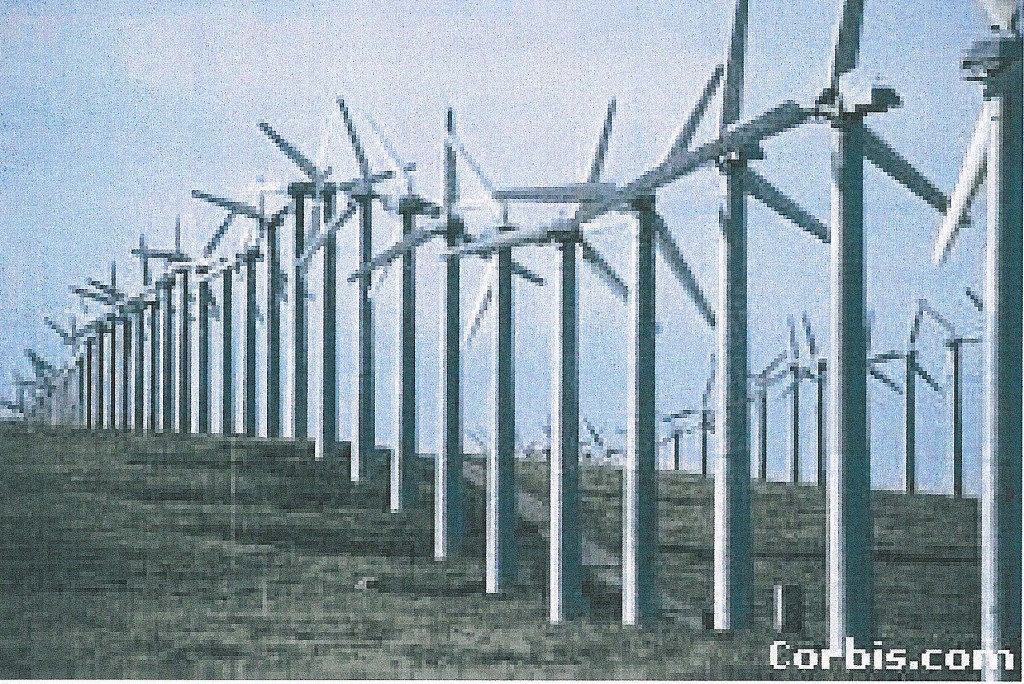
140.1 lines of industrial wind turbines
141. Predation from ground predators using the roads and trails will undoubtedly have an additional detrimental impact on the ability of local populations of ground nesting birds to sustain themselves.
Industrial wind turbines damage the quality of life
142. The industrial wind turbine commercial electric power generation facilities proposed for the Flint Hills Tallgrass Prairie Regional Ecosystem will destroy the visual amenities of the region with a Brobdignagian gothic graveyard of gigantic machines atop towers that are grossly disproportionate to the scale of the historic and environmental character of the Flint Hills and “Prairie.”
143. The industrial wind turbine commercial electric power generation facilities proposed for the Flint Hills Tallgrass Prairie Regional Ecosystem are so grossly disproportionate to the scale of the historic and environmental character of the Flint Hills and “Prairie” that they are such an imminent danger of serious, permanent and irreparable damage that they cry out for equitable relief in the nature of a provisional remedy.
144. The headlong rush of a few corporate Defendant wind energy speculators toward irrevocable destruction of a land and landscape that has been cherished and tended by indigenous peoples for millennia and by the sovereign people of the State of Kansas for generations must be stopped.
145. The question of scale is of paramount importance in determining the environmental impact of a project.
145.1 The following graphic exhibit is a fair and accurate representation of some of the scale factors involved in siting industrial wind turbine commercial electric power generation facilities.
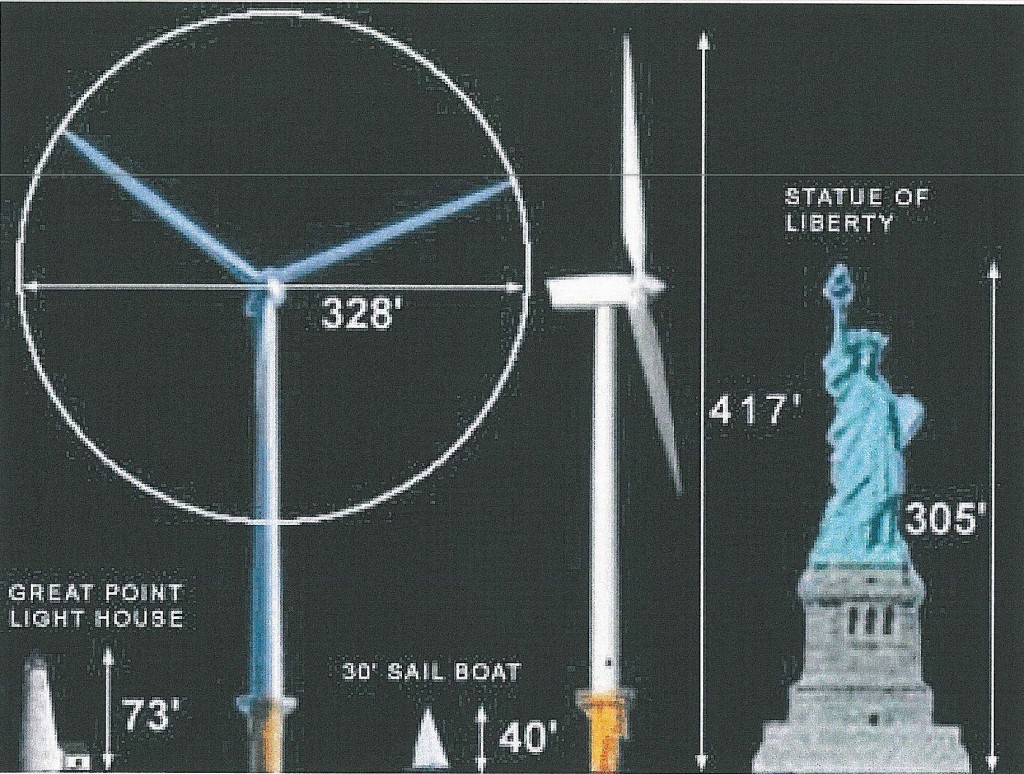
145.1_Inustrial wind turbine scale factors
146. The following photographic exhibit is a fair and accurate representation of a human worker atop the nacelle of a industrial wind turbine in the Midwest.

146. Human worker atop industrial wind turbine nacelle
147. The following photographic exhibit is a fair and accurate representation of the impact of industrial wind turbine commercial electric power generation facilities on life in France.
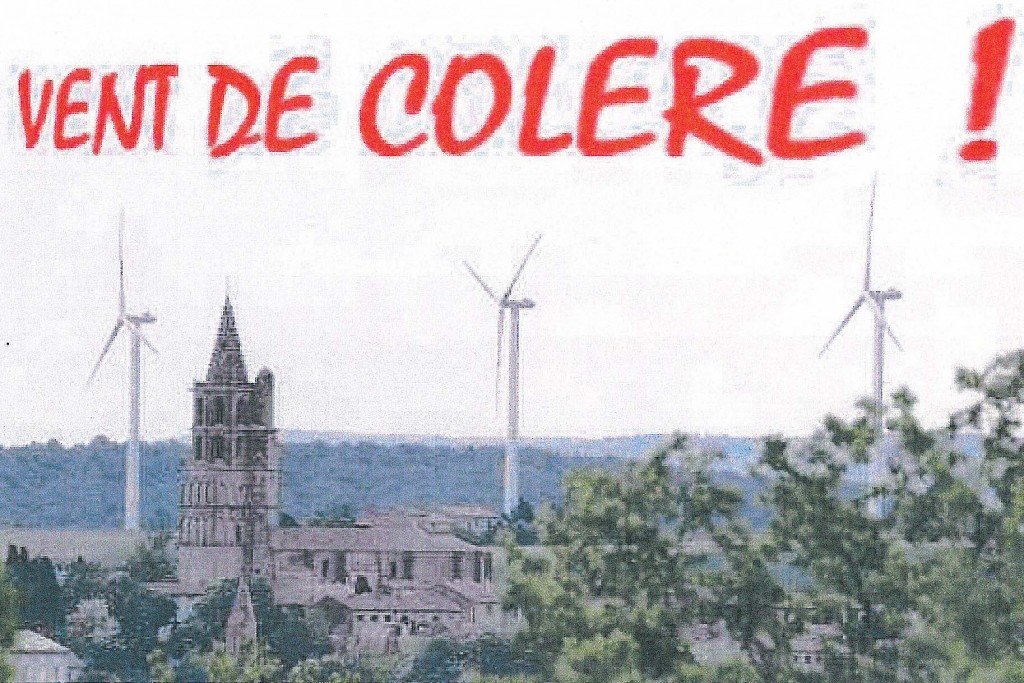
147. Industrial wind turbines and the French landscape
147.1 The following photographic exhibit is a fair and accurate representation of the impact of industrial wind turbine commercial electric power generation facilities on life in Germany.
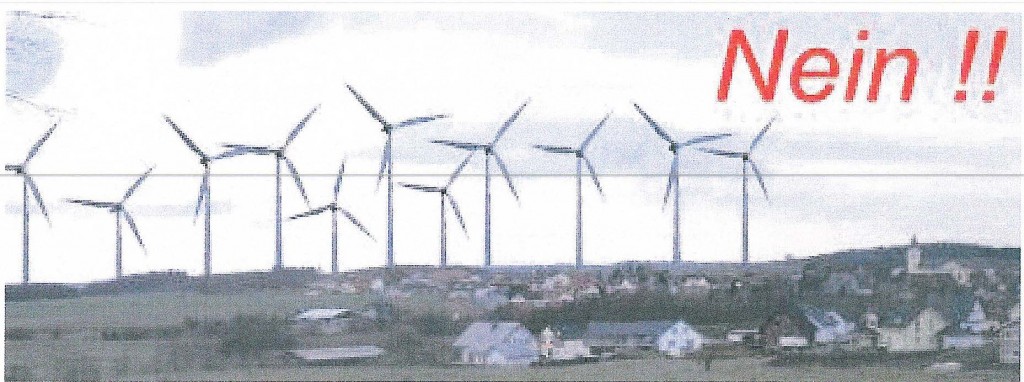
147. Industrial wind turbine impact on German countryside
148. The inevitable network of service roads, transmission lines, substations, fences or other facilities will further fragment the habitat at or near ground level and irrevocably destroy the quality of life in the region.
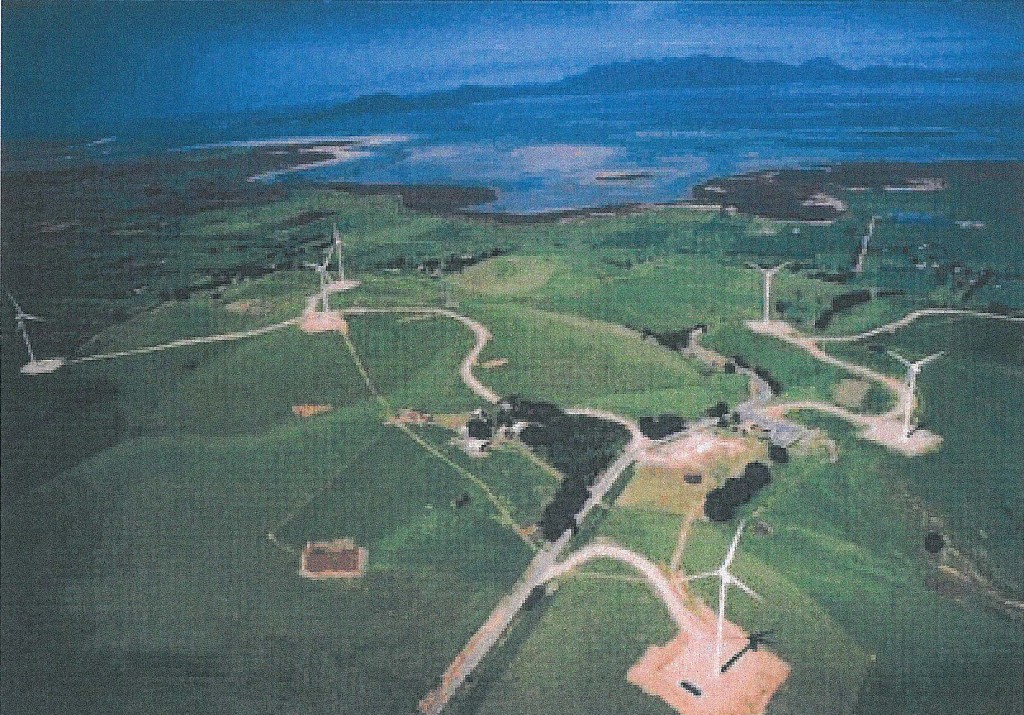 148.1 Habitat fragmentation from Industrial wind turbine infrastructure
148.1 Habitat fragmentation from Industrial wind turbine infrastructure
148.1 The preceding photographic exhibit is a fair and accurate representation of the gigantic heelprint even a small industrial wind turbine commercial electric power generation facility grinds into the land and landscape. 148.2 The following photographic exhibit is a fair and accurate representation of damage associated with right-of-way maintenance for an even smaller industrial wind turbine commercial electric power generation facility in West Texas.
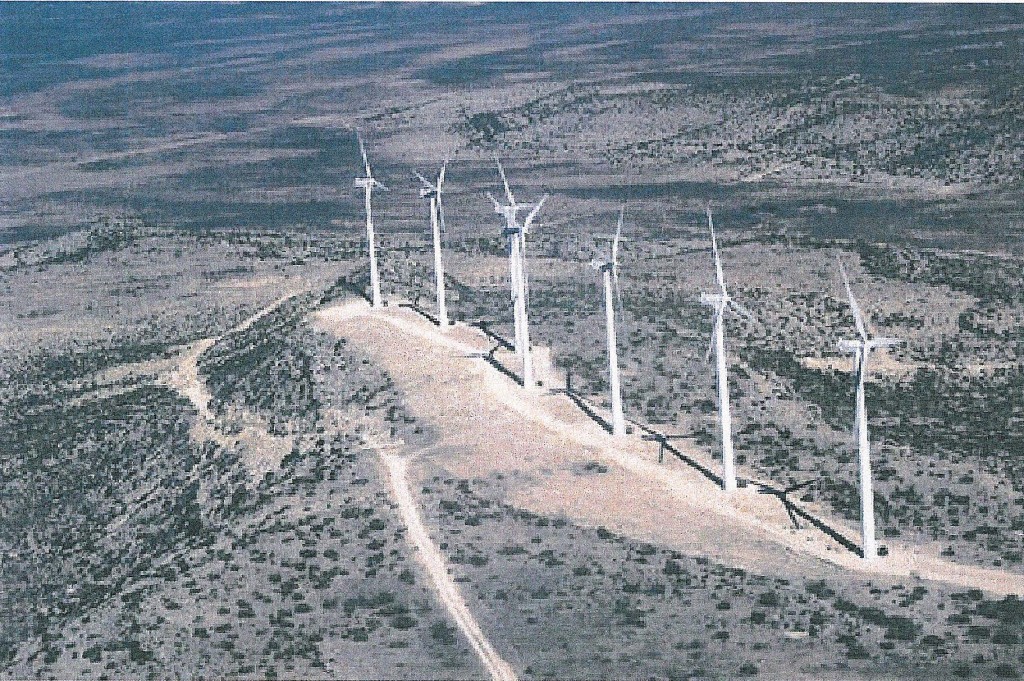
148.2 Industrial wind turbine right-of-way maintenance roads
149. The necessary and ubiquitous aircraft warning lights and the blade “flicker” effects inevitably and necessarily associated with operation and maintenance of industrial wind turbine commercial electric power generation facilities will cause serious, permanent and irreparable damage to the quality of life throughout the Flint Hills Tallgrass Prairie Regional Ecosystem and substantially reduce the value of real property for residents over large areas of the region.
150. To permit the wanton destruction of a unique national and international resource treasure such as the Flint Hills Tallgrass Prairie Regional Ecosystem is an ecological atrocity of such magnitude as to be inconsistent with the values dominating the spirit of the United States Constitution and the Constitution of the State of Kansas.

The Flint Hills Tallgrass Prairie beneficiaries
Serious, permanent and irreparable damage to the Economy
151. In addition to the high cost of what little electric power may be generated by industrial wind turbine commercial electric power generation facilities, and the serious, permanent and often irreparable damage to local and regional environmental and ecological systems and viewscapes with resulting permanent damage to real property values, industrial wind turbine commercial electric power generation facilities owned and/or operated by wind energy speculators such as the corporate Defendants in this action create a net outflow of wealth (dollars) from the people of Kansas.
It is all about tax avoidance and subsidies
152. Tax avoidance not environmental benefits or energy independence has become the prime motivation for the frenzy among wind energy speculators to build industrial wind turbine commercial electric power generation facilities as quickly as possible regardless of whether there is any economic justification for such facilities. This system of tax credits and subsidies leads wind energy speculators to sweep environmental siting considerations aside in their frantic pursuit of economic rewards without risk—something for nothing. 153. Industrial wind turbine commercial electric power generation facility owners enjoy two very generous federal tax breaks: five-year double declining balance accelerated depreciation and a Production Tax Credit for each kWh of electricity produced during the first 10 years the giant turbines spin regardless of whether the electric power produced provides any benefit to the hard pressed consumer of electric power or the businesses that run on electric power.
154. Since most states conform their state corporate income tax to the federal system, the five-year double declining balance accelerated depreciation can also be deducted from otherwise taxable income in the state the industrial wind turbine commercial electric power generation facilities are located thus reducing the owners’ corporate tax liability in that state.
Renewable Portfolio Standards-Shifting Costs to Consumers … Again
155. A “Renewable Portfolio Standard” mandates some minimum amount or percentage of electricity that a distribution company would have to produce or purchase and make available to its customers. The “mandate” would have to be met even though electric power produced from “renewable” sources was substantially more costly than electric power form “traditional” sources.
156. Renewable Portfolio Standards (mandates) benefit wind energy speculators at the expense of electric power consumers in violation of the Constitution of the United States.
157. Renewable Portfolio Standards are one of the most insidious ways yet developed to shift costs from developers of industrial wind turbine commercial electric power generation facilities to ordinary electric power consumers and to hide those costs in monthly electric bills.
The Production Tax Credit
158. The wind “Production Tax Credit” which allows the owner to deduct from federal income tax liability $0.018 per kWh of electric power produced commercially during the first 10-years of the project life. Although this tax credit expired at the end of 2003, it was recently renewed by the United States Congress to restore the credit.
159. Various other subsidies shift large amounts of cost from industrial wind turbine commercial electric power generation facility owners to ordinary taxpayers and electric customers.
160. States also permit local governments to exempt industrial wind turbine commercial electric power generation facilities from some portion of the property taxes that would normally be paid. In Kansas the wind energy speculators pay no property taxes at all!
161. Tax breaks provided to owners of industrial wind turbine commercial electric power generation facilities shift and transfer the tax burden those owners escape to ordinary taxpayers unjustly enrich the owners of industrial wind turbine commercial electric power generation facilities at the expense of all the other people of the United States who consume electric power all in violation of the Constitution of the United States.
162. In addition to unconscionable tax benefits, the owners of industrial wind turbine commercial electric power generation facilities receive the revenue from the sale of the electric power that is produced.
Guaranteed Markets
163. In some states there is a virtually guaranteed market for electric power produced from industrial wind turbine commercial electric power generation facilities due to the State’s “Renewable Set Asides” requirement applicable to investor owned utilities and a “Mandatory Green Power Option” applicable to all utilities.
164. These additional markets resulting from mandated purchases of “green electric power” by federal and state government agencies at above market prices cover these increased operating costs by reducing other agency services and programs.
165. State programs requiring or encouraging electric utilities to offer “green” electric power at premium prices, seldom attract enough “volunteers” to pay the utilities’ costs of buying the “green” electric power and administering the program. The cost not recovered from customers paying premium prices is spread among all the other consumers of electric power.
166. The wind industry has ready access to and support from Department of Energy (DOE) officials who control the flow of tax dollars for renewable energy programs, as well as National Renewable Energy Laboratories and other Department of Energy contractor employees who use taxpayer dollars to aid the wind industry’s lobbying and public relations efforts. These officials and employees actively participate in the development and distribution of biased “studies,” “analyses,” and “reports” that overstate the benefits and understate the true costs of wind energy. Their actions suggest that their loyalty is to the interests of the wind industry, not those of taxpayers and consumers.
Wind energy speculators and their “Wind Industry”
167. In spite of subsidies and favorable tax incentives, wind power represents a de minimus portion of United States energy production.
168. Fossil energy sources—coal, natural gas, and petroleum combined—are expected to supply 84.73% of United States energy requirements in 2025 according to the United States Energy Information Agency. That is 212 times the 40/100 of 1% expected from wind.
168.1 The following table was taken from an official statement of the United States Energy Information Agency.
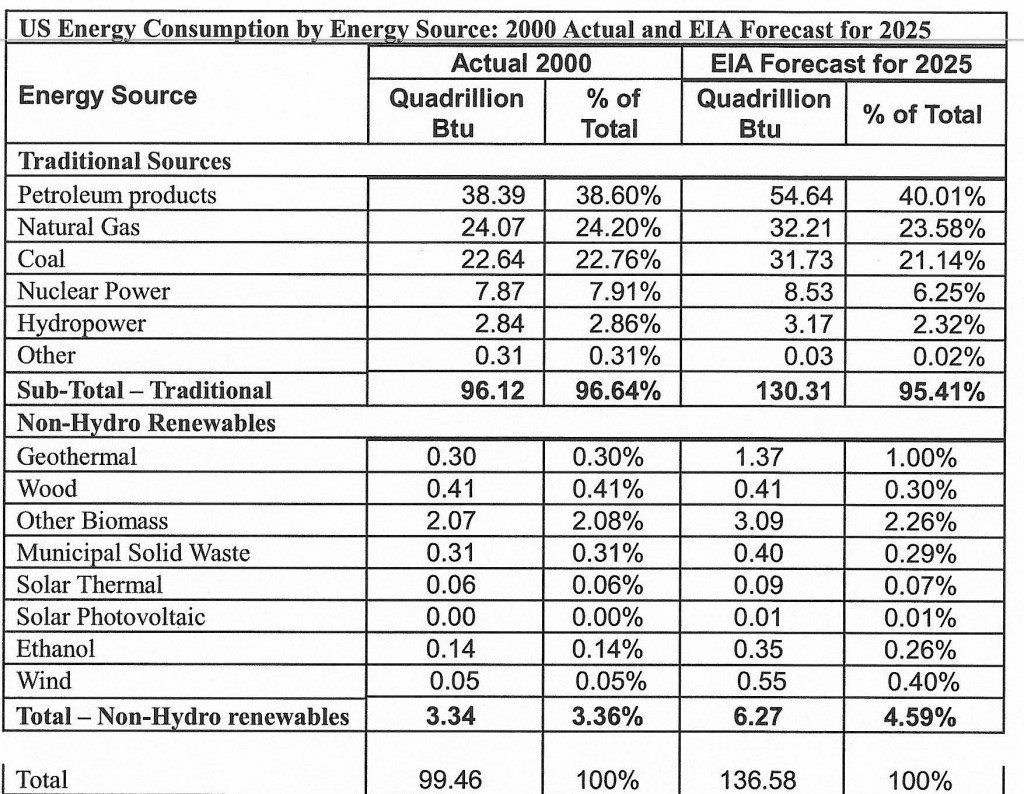
United States Energy Information Agency 2025 forecast
169. At the end of 2003, United States wind energy capacity reached 6,374 megawatts, and about 500 megawatts may have been added in 2004. Projects under construction or negotiation may add 3,000 megawatts of wind capacity in the U.S. in the next five years. This amount is dwarfed by the installed electrical capacity for the nation of 953,205 megawatts. Wind provides about 1.5% of the nation’s electricity generation capacity.
Windfalls and wipeouts
170. Economic analyses indicate that the extra cost to electric power consumers will far exceed the income received by the few landowners who might be willing to lease their land for erection of industrial wind turbine commercial electric power generation towers and it would be more economically rational for the electric power consumers to pay the landowners not to allow industrial wind turbines to be built upon their land!
171. The big “ winners” are the owners of industrial wind turbine commercial electric power generation facilities; electric power consumers and local taxpayers are the big “losers.”
172. The big “losers” when industrial wind turbine commercial electric power generation facilities are built are the electric power consumers who pay the higher true cost of the electric power produced and the local and regional taxpayers who absorb the tax burden escaped by the owners.
The voodoo economics of wind turbine electric power generation
173. The United States has been, is now, and will almost certainly continue for the next few decades to be heavily dependent on coal, petroleum, natural gas, hydropower and nuclear energy to meet our energy requirements.
174. Despite the hundreds of millions of tax dollars spent on R&D and the other generous subsidies, there is no significant probability that wind will make a significant contribution toward meeting United States energy requirements.
175. Federal and state government actions designed to force greater reliance on wind distort capital investment and the very structure of the American Free Enterprise System by steering capital to projects that have little economic merit.
175.1 The greater share of the capital investment in industrial wind turbine commercial electric power generation facilities goes for turbines, blades, towers, electronics and related equipment which are produced in other states and, often, foreign countries. Little of the money for equipment and supplies is spent locally.
176. The generous federal and state tax breaks and “Renewable Portfolio Standards” produce significant transfers of wealth from taxpayers and electric power consumers to wind energy speculators.
Overstated benefits; underestimated real costs
177. Wind energy speculators have overstated the benefits of wind power and underestimated the real costs to consumers, ratepayers, and taxpayers
178. Industrial wind turbine electric power generating systems still remain more expensive and less dependable than traditional sources of electric power.
Industrial wind turbine failures
179. Industrial wind turbine commercial electric power generation facilities are extremely susceptible to damage from lightning. The State of Kansas is well known for the frequency of storms accompanied by lightning.
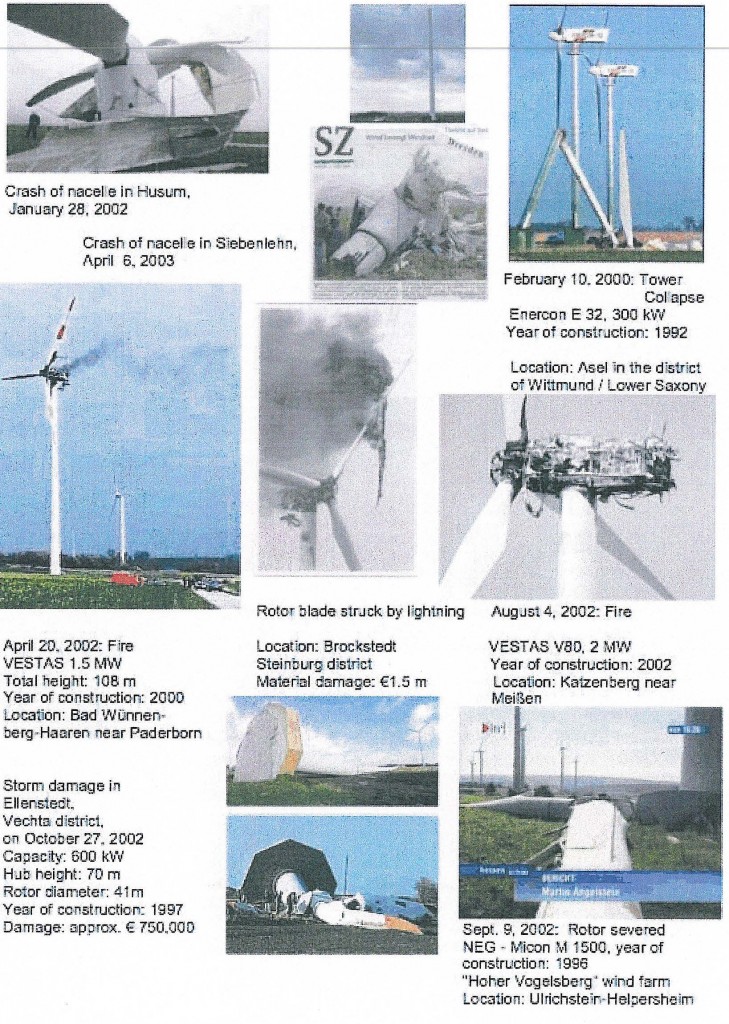
Montage of wind turbine catastrophic failures

Wind turbine blades after lightning strike
180. Contributing to the unreliability of industrial wind turbine commercial electric power generation facilities is their susceptibility to fire and the consequences of such fires to the communities that would be at risk in the Flint Hills Tallgrass Prairie Regional Ecosystem.
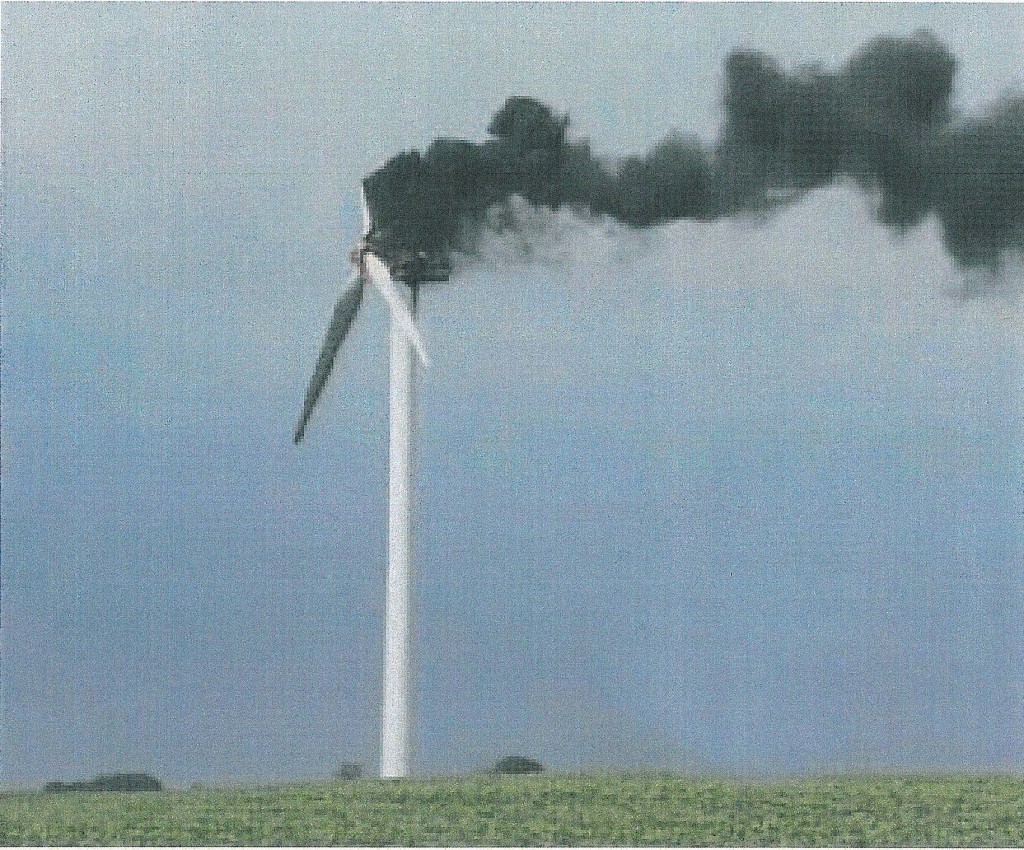
Wind turbine afire after lightning strike
182. In addition to their vulnerability to lightning and fire, industrial wind turbine commercial electric power generation facilities are vulnerable to high winds such as occur in Kansas with relatively regular frequency.
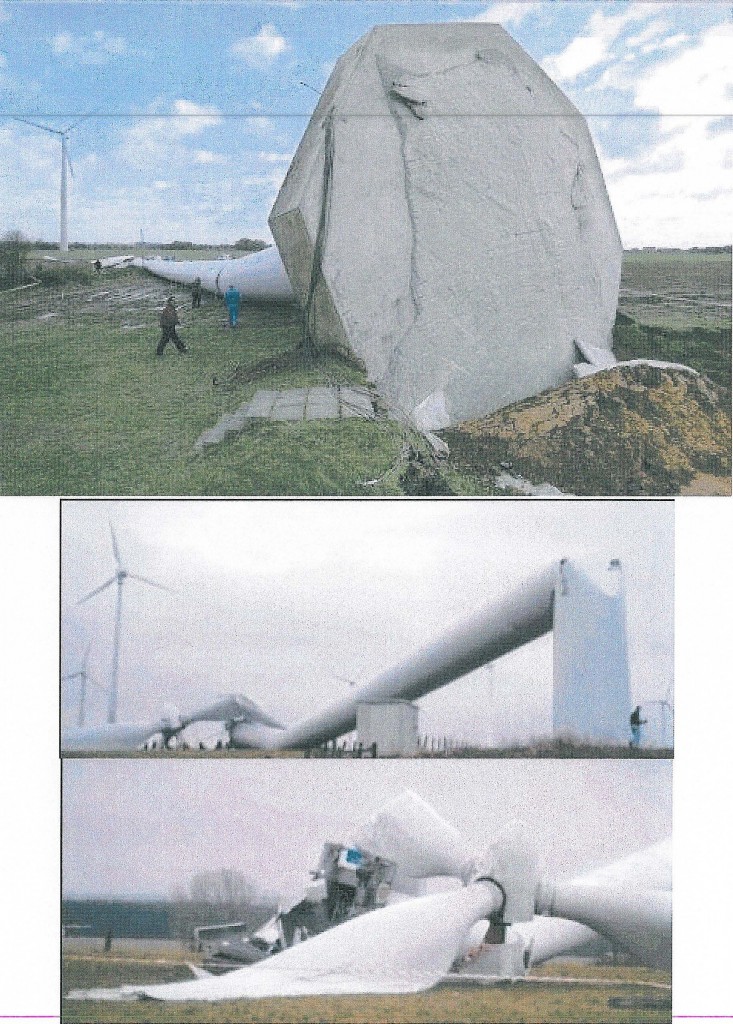
Wind turbine uprooted after windstorm
183. Because wind produces energy only intermittently when the wind blows within certain speeds, it actually produces only about two-tenths of one percent (0.2%) of the nation’selectrical energy. Nevertheless, the United States Department of Energy has announced a goal of obtaining 5% of United States electric power from wind by 2020.
184. In spite of its relatively advantageous price, wind power is not likely to become a major source of energy because of its intermittent output, the need to build massive transmission lines to convey the energy to the regions which need it, environmental problems, and its impact on the transmission system itself.
Transmission systems and networks
185. The huge towers carrying high voltage transmission lines across the country, require heavy insulators and substantial ground clearance because air may be a good insulator, but it has its limits.
185.1 If the distance between the high voltage transmission cables is not great enough, the air may “break down” and sparking or arcing may occur. Moisture in the air makes breakdown easier, and designers of transmission lines have to provide for the worst possible atmospheric situation. Tall towers and wide rights-of-way have been the answer to the problem for almost a century.
186. For any type of power line, the amount of energy lost as heat to the resistance of the line increases as the amount of current fed through it is increased, and also as the line is lengthened. For a short line, these losses are small enough, but as the distances over which electric current must flow are increased, the heat loss becomes a significant fraction of the total energy transmitted. Some way must be found to carry the same amount of power, but reduce the heat lost, which depends on the current and the distance.
186.1 Increasing the voltage and reducing the current keeps the power the same but reduces the heat losses which depend on the current. Keeping the current as low as possible so the losses are low, and then raising the voltage as high as possible so that the product of voltage and current—the power&mdashremains high has been the basic philosophy of the American electric power industry since the time of George Westinghouse.
186.2 As the distances lengthen; the need for higher and higher voltages becomes evident. Transmission lines carrying voltages of 100,000 to 300,000 volts are common, and ones of over a million volts are under consideration. 186.3 The following photographic exhibit is a fair and accurate representation of high voltage transmission lines in Florida.
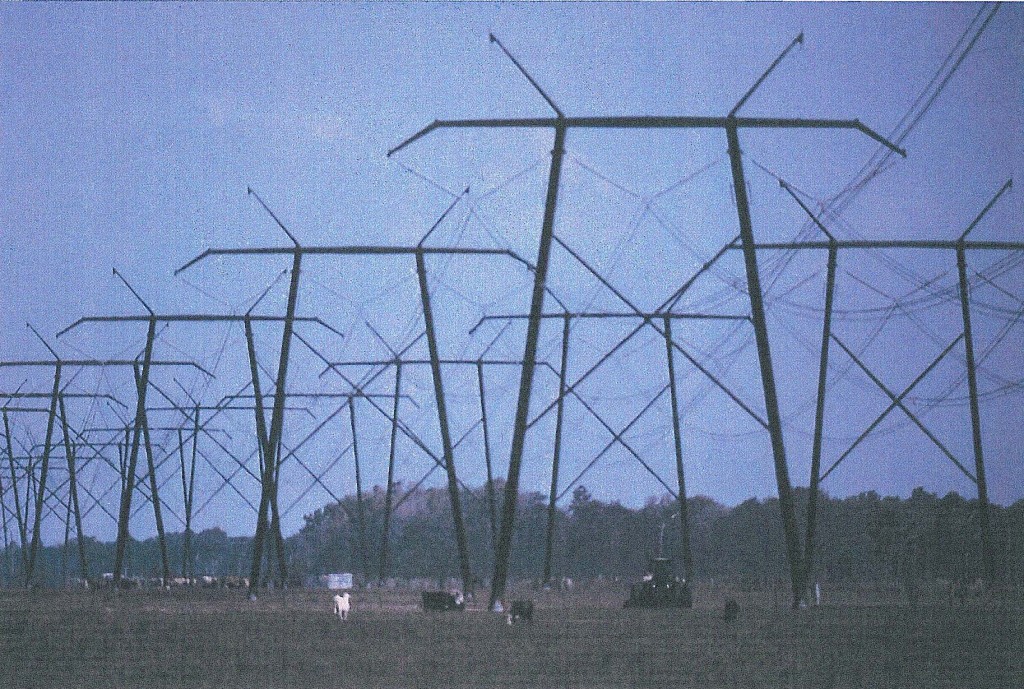
High Voltage transmission lines in Florida
187. Construction of transmission lines requires heavy equipment, new roads and significant materials, as well as construction activities that will conflict with wildlife and ecosystems.
187.1 The transmission line right-of-way needs to be kept free of vegetation to avoid fires and power outages and chemical mowing with herbicides is often employed.
188. A line used solely for transmitting power from a generating plant to a distant center of load or from one load center to another is a transmission line. The group of interconnected transmission lines that carries the energy at a high voltage is termed the transmission system. Transmission voltages usually range from 69,000 to 500,000 volts.
188.1 Transmission lines emanating from power plants usually form a network looping through various communities and to other power plants.
The “Grid”
189. The main transmission system of bulk power supply is the system of transmission lines interconnecting a company’s major power plants and the lines interconnecting with other power suppliers. Thus, the transmission system for bulk power supply is distinguished from the lower voltage transmission lines serving communities and industries and from the low-voltage distribution systems within the communities.
190. Electric power systems generally operate in two modes: (1) the steady-state or dynamic equilibrium condition and (2) the transient or unstable condition.
190.1 The condition of dynamic equilibrium is the desirable one. Unfortunately, power systems are always undergoing discrete changes in demand and supply and are subject to transmission-line interruptions and short circuits. To operate satisfactorily a system must absorb all of these disturbances and still remain in dynamic equilibrium. When ever a disturbance of any kind causes this equilibrium condition to be lost, the system becomes unstable and the result is usually a “blackout.”
190.2 Under normal conditions the system operates under several constraints, the most important one being that it must supply the entire consumer demand with minimum fluctuations in voltage and frequency. When a system cannot meet this requirement the result is a “brownout.”
190.3 Further, the system must operate at maximum possible efficiency and with minimum overall cost; that is, for a given demand situation the most economical generators must be on-line and the energy must be transmitted over those channels that introduce minimum loss.
190.4 On a larger scale, the same criteria apply to groups of individual utilities that are banded together in so-called “Interconnected Systems” or “Power Pools”, each organized as a separate entity serving a specific region.
190.5 Under emergency conditions it is sometimes possible for blocks of power to be moved from one region to another provided that elaborate pre-arrangements have been made.
190.6 Still another restraint on the development of large-scale power-pool interconnections is the technical limitation on the practical length of overhead AC transmission lines. Lines that are longer than 400 miles operate under severe stability and synchronization limits, and such ties are avoided in normal power system design. Similarly, underground a-c cables are even more restricted, with a maximum possible length of about 20 miles.
191. The lack of appropriate interconnection between the Southwest Power Pool (SPP) and Rocky Mountain Power Association (RMPA) power pools in western Kansas and eastern Colorado does not permit substantial growth in commercial wind energy development in Western Kansas where there would be fewer adverse cultural, historical and ecological impacts.
191.1 The following graphic exhibit is a fair and accurate schematic representation of growth in the Electric Grid System.
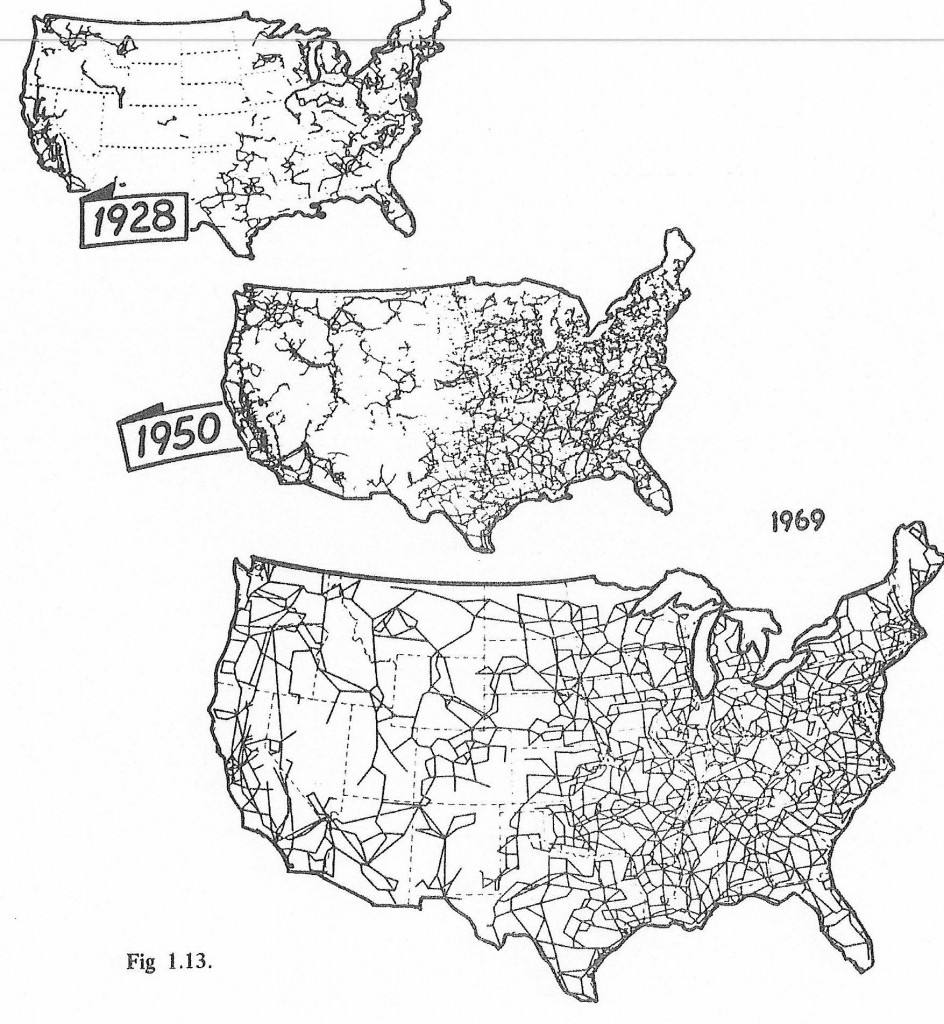
The Continental United States Electric PowerGrid
192. The low capacity factor of the winds—the low percentage of time an industrial wind turbine commercial electric power generation facility actually is working at or near capacity—and poor correlation with load because of the long distance from population centers and the fact the wind often blows at times when electricity demand is low further reduces the already low annual average loading of transmission lines.
193. Adding significant numbers of industrial wind turbine commercial electric power generation facilities will only increase the total costs of distributing whatever electric energy might be generated because of the regional sprawl that is required by industrial wind turbine siting constraints.
194. The ability of the existing transmission grid system to handle the heavy flows that occur only a few times during the year is decreasing. The nation’s transmission network is already the primary cause of power outages.
195. Upon information and belief, utility companies maintaining the electrical power grid must now meet a new requirement that the wires to the customer be available for delivering power produced by others who don’t maintain the delivery network.
196. Upon information and belief, In the case of industrial wind turbine commercial electric power generation facilities, the Federal Energy Regulatory Commission has placed the costs of distributing whatever small amounts of electric power the owners and operators of these industrial wind turbine commercial electric power generation facilities might generate on the owner of the transmission and distribution network-not the wind energy speculators. Traditionally, the cost of upgrading electrical transmission line systems are borne by those who create the need for such upgrades.
False and misleading claims by the corporate Defendants
197. The wind industry, the Department of Energy, its national laboratories, and other wind energy advocates have misled the public, the media, Congress and state legislators and regulators with their claims about the benefits of wind energy. They have greatly overstated the benefits and understated the true costs.
198. The wind industry and the corporate Defendants make false claims that industrial wind turbine commercial electric power generation facilities provide significant economic benefits in the areas and states where they are constructed as a result of capital investment, jobs, tax revenues, lease payments to landowners, and “other” economic activities.
199. Industrial wind turbine commercial electric power generation facilities produce few local economic benefits and whatever benefits might exist are overwhelmed by the higher true cost to the purchasers of the electric power produced by the industrial wind turbine commercial electric power generation facilities and the taxpayers who are forced to provide direct and indirect subsidies to the wind energy speculators.
200. Most of the jobs during construction of industrial wind turbine commercial electric power generation facilities last only a few months and are often filled by workers imported from outside the region affected.
200.1 Only 20 of 200 construction period jobs were filled by local workers in the case of the Top of Iowa industrial wind turbine commercial electric power generation facility built in 2001 and only 7 permanent jobs resulted.
201. Any of the putative economic benefits attributable to industrial wind turbine commercial electric power generation facilities will be much more than offset by:
201.1 The increase in electric customers’ monthly bills because electric power produced from wind is more expensive and that in the overall economic system, higher costs for electric power means that less money is available to consumers to spend for food, clothing, shelter, education, medical expenses and other needs reducing economic activity;
201.2 The cost of repairing roads damaged by the construction traffic and the continuing additional cost of government services particularly police, fire protection, and homeland security; 201.3 Other losses of economic activity, particularly tourism.
Prayer for Relief
WHEREFORE, the Representative Plaintiff organization, on behalf of all those entitled to the full benefit, use and enjoyment of the unique national and international resource treasures that is the Flint Hills Regional Environmental System without serious, permanent and irreparable damage, degradation or diminution in value resulting from the development of the industrial wind turbine power generating facilities proposed by the Corporate Defendants, and all others similarly situated, not only of this generation but of those generations yet unborn, demands judgment of the corporate Defendants.
DECLARING the rights of the people of the United States in and to the full benefit, use and enjoyment of the unique national and international resource treasures that is the Flint Hills Regional Environmental System, without serious, permanent and irreparable damage, degradation or diminution in value from the operation and development of the industrial wind turbine commercial electric power generation facilities proposed by the Corporate Defendant owners and developers of such industrial wind turbine commercial electric power generation facilities.
DECLARING that the proposal by the Corporate Defendants to locate industrial wind turbine commercial electric power generation facilities in the Flint Hills Tallgrass Prairie Ecosystem violates the rights of the plaintiffs and all the sovereign people of the United States not only of this generation but of those generations yet unborn, to the full benefit, use and enjoyment of the unique national and international natural resource treasure, the Flint Hills Tallgrass Prairie Regional Ecosystem, guaranteed under the Ninth Amendment of the Constitution of the United States and protected by the due process clause of the Fifth Amendment of the Constitution of the United States and by the due process and equal protection clauses of the Fourteenth Amendment of the Constitution of the United States.
DECLARING that any permanent exemption from Kansas property tax afforded to commercial wind energy developments violates the provisions of the Kansas State Constitution and the Constitution of the United States.
DECLARING that any tax relief or incentives for development of industrial wind turbine commercial electric power generation facilities should be limited to those facilities that can establish by a fair preponderance of substantial credible scientific evidence that the sites selected are located in places that do not substantially diminish ecological, aesthetic, cultural and economic values of public importance and do not cause serious, permanent and irreparable damage to unique national and international resource treasures such as the Flint Hills Tallgrass Prairie Ecosystem.
DECLARING that the discrepancies and lack of uniform comprehensive policies among various municipal subdivisions and government agencies involved in approving and regulating the siting, construction, operation, and maintenance of industrial wind turbine electric power generating facilities violates the provisions of the Kansas State Constitution and the Constitution of the United States.
DECLARING that the lack of any ecologically sophisticated, environmentally responsible, socially relevant, and economically rational comprehensive plan for the Flint Hills Regional Environmental System in general and the Flint Hills Tallgrass Prairie Ecosystem in particular together with the lack of any scientifically supportable siting criteria for industrial wind turbine commercial electric power generation facilities violates the provisions of the Kansas State Constitution and the Constitution of the United States.
RESTRAINING the corporate Defendants jointly or severally, individually or in concert with others, from any operation or development of industrial wind turbine commercial electric power generation facilities within the Flint Hills Tallgrass Prairie Ecosystem.
RESTRAINING the corporate Defendants jointly or severally, individually or in concert with others, from any development of industrial wind turbine commercial electric power generation facilities in the Flint Hills Tallgrass Prairie Ecosystem until there is substantial credible evidence that such industrial wind turbine commercial electric power generation facilities conforms and complies at the minimium with recommendations made by the siting committee of the Kansas Renewable Energy Working Group, the Kansas Department of Wildlife & Parks, and the United States Fish & Wildlife Service.
PROHIBITING commercial wind energy development and the location and construction of industrial wind turbines in the Flint Hills Tallgrass Prairie Regional Ecosystem and the buffer area surrounding that system necessary to protect migratory birds and comply with the letter and the spirit of the treaty of December 8, 1916 between the United States and Great Britain and the Migratory Bird Act which imiplements that Treaty.
PROHIBITING commercial wind energy development and the location and construction of industrial wind turbines in the Flint Hills Tallgrass Prairie Regional Ecosystem and the buffer area surrounding that system necessary to protect and preserve the aesthetic qualities of the Flint Hills viewshed and enhance the multiple tourism marketing strengths of the region: Frontier History, Hunting, Eco-tourism, and Agri-tourism.
All together with any and all such further relief as to this court shall seem just and proper under the circumstances.
DATED at Wichita Kansas, this the 24th day of January 2005
VICTOR JOHN YANNACONE, JR. (VY6405) of counsel pro haec vice
Terry L. Malone (11169) MARTIN, PRINGLE, OLIVER, WALLACE & BAUER Attorneys for the Plaintiffs
Flint Hills CA_10 Plaintiffs Brief
Flint Hills CA_10_Plaintiffs Reply Brief
